
- •1.0 What Is the GMAT®?
- •1.1 Why Take the GMAT® Test?
- •1.2 GMAT® Test Format
- •1.3 What Is the Content of the Test Like?
- •1.4 Quantitative Section
- •1.5 Verbal Section
- •1.6 What Computer Skills Will I Need?
- •1.7 What Are the Test Centers Like?
- •1.8 How Are Scores Calculated?
- •1.9 Analytical Writing Assessment Scores
- •1.10 Test Development Process
- •2.0 How to Prepare
- •2.0 How to Prepare
- •2.1 How Can I Best Prepare to Take the Test?
- •2.2 What About Practice Tests?
- •2.3 How Should I Use the Diagnostic Test?
- •2.4 Where Can I Get Additional Practice?
- •2.5 General Test-Taking Suggestions
- •3.0 Diagnostic Test
- •3.0 Diagnostic Test
- •3.1 Quantitative Sample Questions
- •3.2 Verbal Sample Questions
- •3.3 Quantitative and Verbal Answer Keys
- •3.4 Interpretive Guide
- •3.5 Quantitative Answer Explanations
- •3.6 Verbal Answer Explanations
- •4.0 Math Review
- •4.0 Math Review
- •4.1 Arithmetic
- •4.2 Algebra
- •4.3 Geometry
- •4.4 Word Problems
- •5.0 Problem Solving
- •5.0 Problem Solving
- •5.1 Test-Taking Strategies
- •5.2 The Directions
- •5.3 Sample Questions
- •5.4 Answer Key
- •5.5 Answer Explanations
- •6.1 Test-Taking Strategies
- •6.2 The Directions
- •6.3 Sample Questions
- •6.4 Answer Key
- •6.5 Answer Explanations
- •7.0 Reading Comprehension
- •7.0 Reading Comprehension
- •7.1 What Is Measured
- •7.2 Test-Taking Strategies
- •7.3 The Directions
- •7.4 Sample Questions
- •7.5 Answer Key
- •7.6 Answer Explanations
- •8.0 Critical Reasoning
- •8.0 Critical Reasoning
- •8.1 What Is Measured
- •8.2 Test-Taking Strategies
- •8.3 The Directions
- •8.4 Sample Questions
- •8.5 Answer Key
- •8.6 Answer Explanations
- •9.0 Sentence Correction
- •9.0 Sentence Correction
- •9.1 Basic English Grammar Rules
- •9.2 Study Suggestions
- •9.3 What Is Measured
- •9.4 Test-Taking Strategies
- •9.5 The Directions
- •9.6 Sample Questions
- •9.7 Answer Key
- •9.8 Answer Explanations
- •10.0 Analytical Writing Assessment
- •10.0 Analytical Writing Assessment
- •10.1 What Is Measured
- •10.2 Test-Taking Strategies
- •10.3 The Directions
- •10.4 GMAT® Scoring Guide: Analysis of an Issue
- •10.5 Sample: Analysis of an Issue
- •10.6 Analysis of an Issue Sample Topics
- •10.8 Sample: Analysis of an Argument
- •10.9 Analysis of an Argument Sample Topics
- •Appendix A Percentile Ranking Tables
- •Appendix B Answer Sheets
- •Problem Solving Answer Sheet
- •Reading Comprehension Answer Sheet
- •Critical Reasoning Answer Sheet
- •Sentence Correction Answer Sheet

6.4 Data Sufficiency Answer Key
6.4 Answer Key
1. |
B |
36. |
B |
71. |
C |
106. |
D |
141. |
C |
2. |
E |
37. |
A |
72. |
A |
107. |
B |
142. |
E |
3. |
A |
38. |
C |
73. |
B |
108. |
D |
143. |
D |
4. |
E |
39. |
D |
74. |
A |
109. |
A |
144. |
D |
5. |
E |
40. |
B |
75. |
A |
110. |
A |
145. |
D |
6. |
D |
41. |
E |
76. |
E |
111. |
E |
146. |
B |
7. |
A |
42. |
A |
77. |
D |
112. |
B |
147. |
C |
8. |
C |
43. |
E |
78. |
C |
113. |
D |
148. |
B |
9. |
A |
44. |
C |
79. |
E |
114. |
D |
149. |
A |
10. |
B |
45. |
D |
80. |
D |
115. |
D |
150. |
A |
11. |
A |
46. |
B |
81. |
C |
116. |
A |
151. |
D |
12. |
B |
47. |
A |
82. |
B |
117. |
D |
152. |
B |
13. |
D |
48. |
C |
83. |
C |
118. |
E |
153. |
D |
14. |
C |
49. |
B |
84. |
D |
119. |
E |
154. |
A |
15. |
B |
50. |
C |
85. |
A |
120. |
B |
155. |
D |
16. |
A |
51. |
B |
86. |
A |
121. |
E |
156. |
B |
17. |
D |
52. |
B |
87. |
E |
122. |
C |
157. |
D |
18. |
B |
53. |
A |
88. |
B |
123. |
A |
158. |
D |
19. |
C |
54. |
C |
89. |
C |
124. |
A |
159. |
A |
20. |
A |
55. |
E |
90. |
A |
125. |
D |
160. |
D |
21. |
E |
56. |
A |
91. |
E |
126. |
E |
161. |
C |
22. |
E |
57. |
D |
92. |
A |
127. |
D |
162. |
A |
23. |
B |
58. |
E |
93. |
D |
128. |
B |
163. |
B |
24. |
D |
59. |
E |
94. |
A |
129. |
C |
164. |
C |
25. |
D |
60. |
D |
95. |
E |
130. |
C |
165. |
A |
26. |
D |
61. |
C |
96. |
A |
131. |
D |
166. |
D |
27. |
D |
62. |
D |
97. |
A |
132. |
C |
167. |
A |
28. |
E |
63. |
C |
98. |
B |
133. |
B |
168. |
A |
29. |
E |
64. |
B |
99. |
D |
134. |
B |
169. |
B |
30. |
B |
65. |
D |
100. |
D |
135. |
D |
170. |
A |
31. |
B |
66. |
C |
101. |
B |
136. |
D |
171. |
A |
32. |
E |
67. |
D |
102. |
D |
137. |
A |
172. |
C |
33. |
C |
68. |
A |
103. |
D |
138. |
E |
173. |
D |
34. |
D |
69. |
A |
104. |
E |
139. |
B |
174. |
B |
35. |
D |
70. |
D |
105. |
B |
140. |
E |
|
|
289
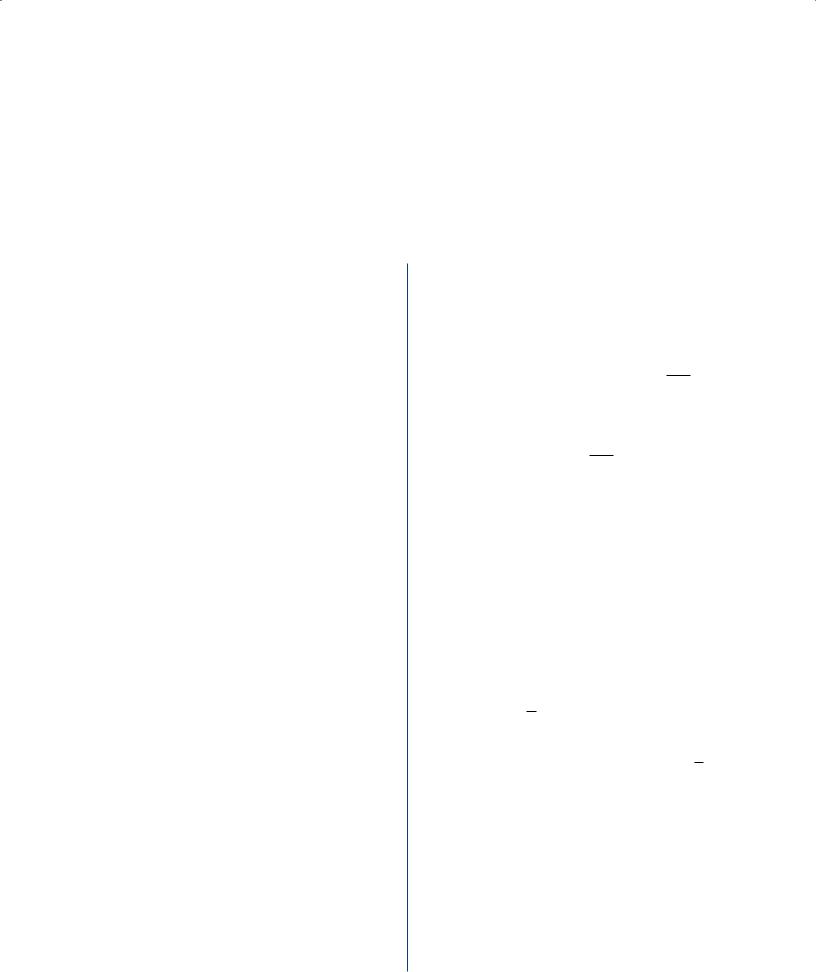
The Official Guide for GMAT® Review 12th Edition
6.5 Answer Explanations
The following discussion of data sufficiency is intended to familiarize you with the most efficient and effective approaches to the kinds of problems common to data sufficiency. The particular questions in this chapter are generally representative of the kinds of data sufficiency questions you will encounter on the GMAT. Remember that it is the problem solving strategy that is important, not the specific details of a particular question.
1.What is the value of |x| ?
(1)x = –|x|
(2)x2 = 4
Arithmetic Absolute value
(1)The absolute value of x, |x|, is always positive or 0, so this only determines that x is negative or 0; NOT su cient.
(2)Exactly two values of x (x = ±2) are possible, each of which gives the value 2 for |x|; SUFFICIENT.
The correct answer is B; statement 2 alone is su cient.
2.What percent of a group of people are women with red hair?
(1)Of the women in the group, 5 percent have red hair.
(2)Of the men in the group, 10 percent have red hair.
Arithmetic Percents
In order to solve this problem, it is necessary to know the total number of people in the group and the number of women with red hair.
(1)This indicates that 5 percent of the women have red hair, but neither the total number of women nor the total number of people in the group is known. Therefore, further information is needed; NOT su cient.
(2)This indicates the percent of men who have red hair, a fact that is irrelevant. It does not give information as to the total number in the group or the number of women with red hair; NOT su cient.
With (1) and (2) taken together, the percent of men with red hair is known and the percent of the women with red hair is known, but not the percent of the group who are women with red hair. For example: if there are 100 women,
including 5 red-haired women, and 100 men,
5 including 10 red-haired men, then 200 = 2.5
percent of the group are women with red hair. On the other hand, if there are 300 women, including 15 red-haired women and 100 men, including 10
15
red-haired men, then 400 = 3.75 percent of the group are women with red hair.
The correct answer is E;
both statements together are still not su cient.
3.In a certain class, one student is to be selected at random to read. What is the probability that a boy will read?
(1)Two-thirds of the students in the class are boys.
(2)Ten of the students in the class are girls.
Arithmetic Probability
2
(1) Since 3 of the students in the class are boys, the probability that one student
selected at random will be a boy is 2; SUFFICIENT. 3
(2)The desired probability is di erent for a class with 10 girls and 20 boys than it is for a class with 10 girls and 10 boys; NOT su cient.
The correct answer is A; statement 1 alone is su cient.
290
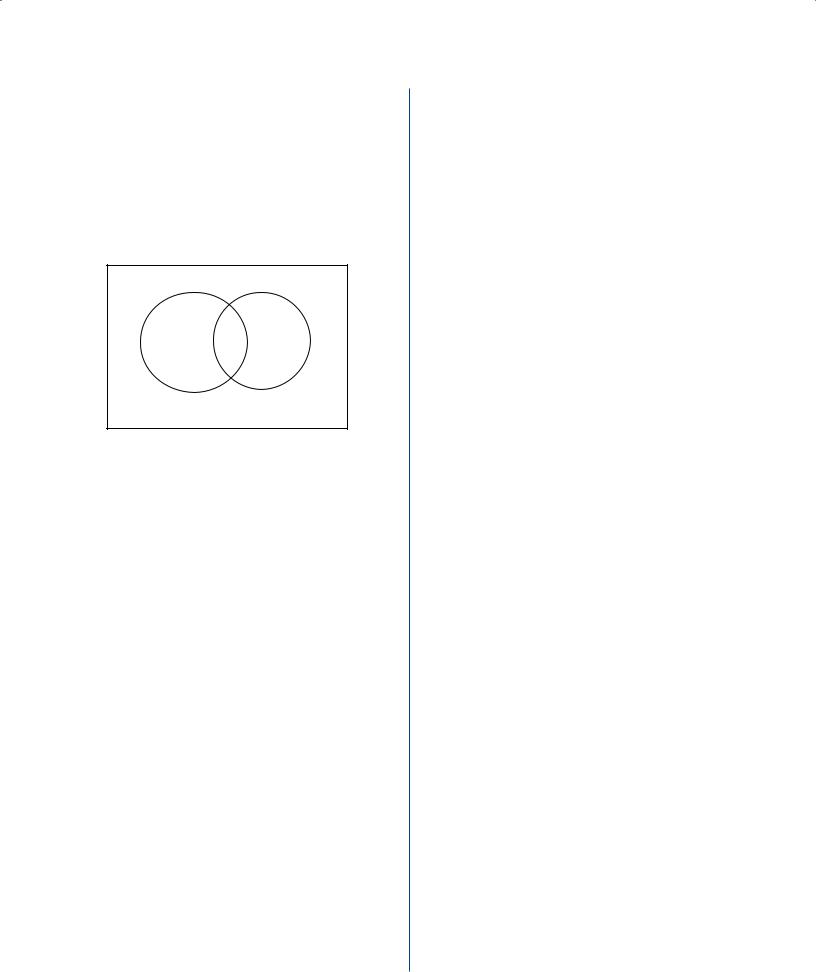
4.In College X the number of students enrolled in both a chemistry course and a biology course is how much less than the number of students enrolled in neither?
(1)In College X there are 60 students enrolled in a chemistry course.
(2)In College X there are 85 students enrolled in a biology course.
Arithmetic Sets (Venn diagrams)
Chemistry Biology
x |
y |
z |
w
Consider the Venn diagram above, in which x represents the number of students in chemistry only, y represents the number of students in both chemistry and biology, z represents the number of students in biology only, and w represents the number of students in neither chemistry nor biology. Find the value for w – y.
(1)Since there are 60 students enrolled in chemistry, x + y = 60, but there is no way to determine the value of y. Also, no information is given for determining w. For example, if x = y = 30 and w = 30, then w – y = 0. However, if x = y = 30 and w = 40, then w – y = 10; NOT su cient.
(2)Since there are 85 students enrolled in biology, y + z = 85, but there is no way to determine the value of y. Also, no
information is given for determining w. For example, if x = y = 30, z = 55, and w = 30, then w – y = 0. However, if x = y = 30,
z = 55, and w = 40, then w – y = 10;
NOT su cient.
Taking (1) and (2) together and subtracting the equation in (1) from the equation in (2) gives z – x = 25. Then, adding the equations gives
x + 2y + z = 145, but neither gives information for
6.5 Data Sufficiency Answer Explanations
finding the value of w. For example, if x = y = 30, z = 55, and w = 30, then w – y = 0. However, if x = y = 30, z = 55, and w = 40, then w – y = 10.
The correct answer is E;
both statements together are still not su cient.
5.A certain expressway has Exits J, K, L, and M, in that order. What is the road distance from Exit K to Exit L ?
(1)The road distance from Exit J to Exit L is 21 kilometers.
(2)The road distance from Exit K to Exit M is 26 kilometers.
Geometry Lines
Let JK, KL, and LM be the distances between adjacent exits.
(1)It can only be determined that KL = 21 – JK; NOT su cient.
(2)It can only be determined that KL = 26 – LM; NOT su cient.
Statements (1) and (2) taken together do not provide any of the distances JK, LM, or JM, which would give the needed information to find
KL. For example, KL = 1 if JK = 20 and LM = 25, while KL = 2 if JK = 19 and LM = 24.
The correct answer is E;
both statements together are still not su cient.
6.If n is an integer, is n + 1 odd?
(1)n + 2 is an even integer.
(2)n – 1 is an odd integer.
Arithmetic Properties of numbers
(1)Since n + 2 is even, n is an even integer, and therefore n + 1 would be an odd integer; SUFFICIENT.
(2)Since n – 1 is an odd integer, n is an even integer. Therefore n + 1 would be an odd integer; SUFFICIENT.
The correct answer is D;
each statement alone is sufficient.
291

The Official Guide for GMAT® Review 12th Edition
7.For which type of investment, J or K, is the annual rate of return greater?
(1)Type J returns $115 per $1,000 invested for any one-year period and type K returns $300 per $2,500 invested for any one-year period.
(2)The annual rate of return for an investment of type K is 12 percent.
Arithmetic Percents
Compare the annual rates of return for
Investments J and K.
(1)For Investment J, the annual rate of return is $115 per $1,000 for any one-year period, which can be converted to a percent. For
Investment K, the annual rate of return is $300 per $2,500 for any one-year period, which can also be converted to a percent. These two percents can be compared to determine which is larger; SUFFICIENT.
(2)Investment K has an annual rate of return of 12 percent, but no information is given about the annual rate of return for Investment J; NOT su cient.
The correct answer is A; statement 1 alone is su cient.
8.A citrus fruit grower receives $15 for each crate of oranges shipped and $18 for each crate of grapefruit shipped. How many crates of oranges did the grower ship last week?
(1)Last week the number of crates of oranges that the grower shipped was 20 more than twice the number of crates of grapefruit shipped.
(2)Last week the grower received a total of $38,700 from the crates of oranges and grapefruit shipped.
Algebra Simultaneous equations
If x represents the number of crates of oranges and y represents the number of crates of grapefruit, find a unique value for x.
(1)Translating from words into symbols gives x = 2y + 20, but there is no information about y and no way to find a unique value for x from this equation. For example, if
y = 10, then x = 40, but if y = 100, then x = 220; NOT su cient.
(2)Translating from words to symbols gives 15x + 18y = 38,700, but there is no way to
find a unique value for x from this equation.
For example, if y = 2,150, then x = 0 and if y = 0, then x = 2,580; NOT su cient.
Taking (1) and (2) together gives a system of two equations in two unknowns. Substituting the equation from (1) into the equation from (2) gives a single equation in the variable y. This equation can be solved for a unique value of y from which a unique value of x can be determined.
The correct answer is C;
both statements together are su cient.
9.If Pat saved $600 of his earnings last month, how
much did Pat earn last month? 1
(1)Pat spent 2 of his earnings last month for living
expenses and saved of the remainder.
(2)Of his earnings last month, Pat paid twice as much in taxes as he saved.
Arithmetic Operations with rational numbers
Let E be Pat’s earnings last month. Find a unique value for E.
1
(1)Pat spent 2E for living expenses and so
1 |
1 |
|
|
|
|
|
|
|
|
||
E – |
|
E = |
|
E remained. Pat saved |
|
of what |
|||||
2 |
2 |
||||||||||
remained, so Pat saved |
1 |
|
|
= |
1 |
E. |
|||||
|
1 E |
6 |
|||||||||
|
|
|
|
|
3 |
|
2 |
|
|
||
But Pat saved $600, so 600 = 16 E
and this gives a unique value for E; SUFFICIENT.
(2)Pat saved $600 last month and paid 2($600) in taxes, but there is no way to determine Pat’s earnings last month; NOT su cient.
The correct answer is A; statement 1 alone is su cient.
10.Water is pumped into a partially fi lled tank at a constant rate through an inlet pipe. At the same time, water is pumped out of the tank at a constant rate through an outlet pipe. At what rate, in gallons per minute, is the amount of water in the tank increasing?
292

(1)The amount of water initially in the tank is 200 gallons.
(2)Water is pumped into the tank at a rate of
10 gallons per minute and out of the tank at a rate of 10 gallons every 2 1 minutes.
2
Arithmetic Work Problem
If both the rate of the water being pumped into the tank and the rate of the water being pumped out of the tank are known, then the rate at which the total amount of water in the tank is changing can be determined, but not if only one of these quantities is known.
(1)This only gives the amount of water in the tank initially; NOT su cient.
(2)This information provides both the needed
rates. Since the water is being pumped out 1 of the tank at the rate of 10 gallons every 22 minutes, that is, 4 gallons every minute, and since 10 gallons are pumped into the tank every minute, the rate at which the water is increasing in the tank is 10 – 4 = 6 gallons per minute; SUFFICIENT.
The correct answer is B; statement 2 alone is su cient.
11.Is x a negative number?
(1)9x > 10x
(2)x + 3 is positive.
Arithmetic Properties of numbers
(1)Subtracting 9x from both sides of 9x > 10x gives 0 > x, which expresses the condition that x is negative; SUFFICIENT.
(2)Subtracting 3 from both sides of x + 3 > 0 gives x > –3, and x > –3 is true for some negative numbers (such as –2 and –1) and for some numbers that aren’t negative (such as 0 and 1); NOT su cient.
The correct answer is A; statement 1 alone is su cient.
12.If i and j are integers, is i + j an even integer?
(1)i < 10
(2)i = j
6.5 Data Sufficiency Answer Explanations
Arithmetic Properties of numbers
(1)Although i < 10, i could be an even number or an odd number less than 10. There is no information about j, so j could be an even number or an odd number. If i and j are both even integers, then i + j is an even integer, and if i and j are both odd integers, then i + j is an even integer. If, however, either i or j is an even integer and the other is an odd integer, then i + j is an odd integer;
NOT sufficient.
(2)If i = j, then i + j can also be represented as i + i when i is substituted for j in the expression. This can be simplified as 2i, and since 2 times any integer produces an even integer, then i + j must be an even integer; SUFFICIENT.
The correct answer is B; statement 2 alone is sufficient.
13.The charge for a telephone call between City R and City S is $0.42 for each of the fi rst 3 minutes and $0.18 for each additional minute. A certain call between these two cities lasted for x minutes, where x is an integer. How many minutes long was the call?
(1)The charge for the fi rst 3 minutes of the call was $0.36 less than the charge for the remainder of the call.
(2)The total charge for the call was $2.88.
Algebra First-degree equations
Let C be the charge for a phone call that lasts
x minutes. Then C = 0.42(3) + 0.18(x – 3), where x ≥ 3. Find a unique value for x.
(1)The charge, in dollars, for the first 3 minutes of the call is 3(0.42) = 1.26 and the charge for the remainder of the call is 0.18(x – 3).
Then, 1.26 = 0.18(x – 3) – 0.36, which can be solved for a unique value of x; SUFFICIENT.
(2)The charge, in dollars, for the call was 2.88, so 2.88 = 0.42(3) + 0.18(x – 3), which can be solved for a unique value of x;
SUFFICIENT.
The correct answer is D;
each statement alone is su cient.
293
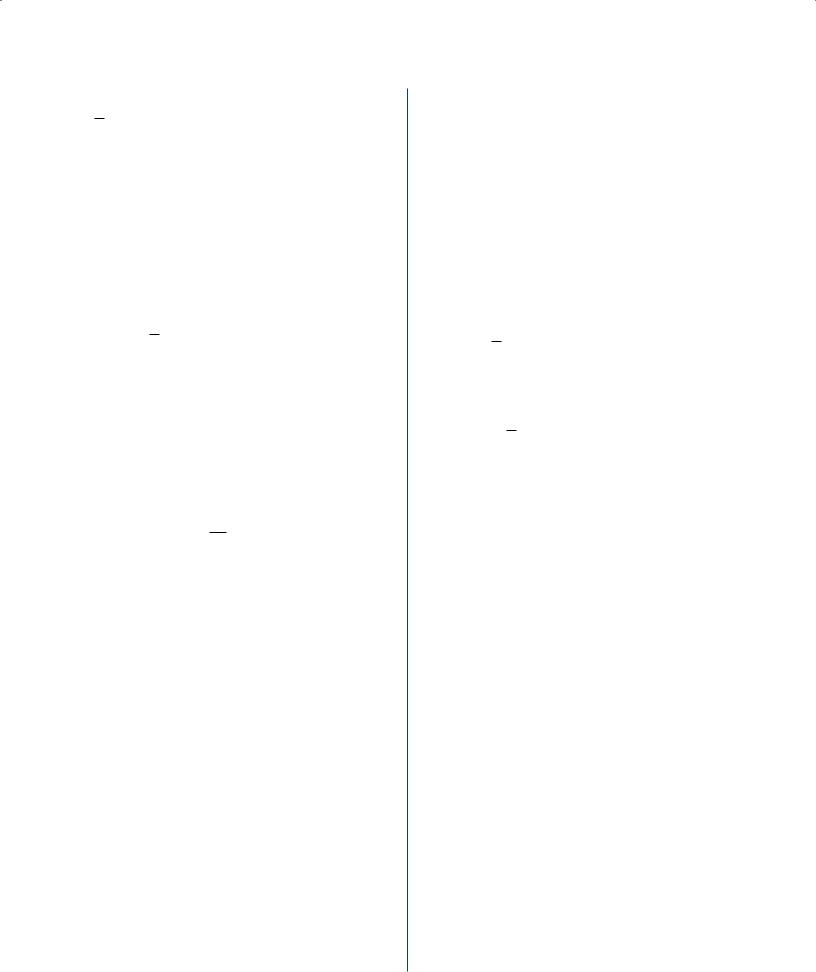
The Official Guide for GMAT® Review 12th Edition
14.If Car X followed Car Y across a certain bridge that is 1
2 mile long, how many seconds did it take Car X to
travel across the bridge?
(1)Car X drove onto the bridge exactly 3 seconds after Car Y drove onto the bridge and drove off the bridge exactly 2 seconds after Car Y drove off the bridge.
(2)Car Y traveled across the bridge at a constant speed of 30 miles per hour.
Arithmetic Rate problem
Find the number of seconds that it took Car X to
cross the 1 -mile bridge. 2
(1)If Car X drove onto the bridge 3 seconds after Car Y and drove o the bridge
2 seconds after Car Y, then Car X took
1 second less to cross the bridge than Car Y. Since there is no information on how long Car Y took to cross the bridge, there is no way to determine how long Car X took to cross the bridge; NOT su cient.
(2)If the speed of Car Y was 30 miles per hour,
1
it took Car Y 60 hour = 1 minute =
60 seconds to cross the bridge. However, there is no information on how long Car X took to cross the bridge; NOT su cient.
Taking (1) and (2) together, Car X took 1 second less than Car Y to cross the bridge and Car Y took 60 seconds to cross the bridge, so Car X took
60 – 1 = 59 seconds to cross the bridge.
The correct answer is C;
both statements together are su cient.
15.If n + k = m, what is the value of k ?
(1)n = 10
(2)m + 10 = n
Algebra Firstand second-degree equations
It is given that n + k = m, so k = m – n. Thus, the question can be rephrased as: What is the value of m – n ?
(1)If n = 10, then m – n = m – 10, and the value of m – 10 can vary. For example, m – 10 = 0 if m = 10 and m – 10 = 1 if m = 11; NOT su cient.
(2)Subtracting both n and 10 from each side of m + 10 = n gives m – n = –10, and hence the value of m – n can be determined; SUFFICIENT.
The correct answer is B; statement 2 alone is su cient.
16.Is x an integer?
x
(1)is an integer.
2
(2)2x is an integer.
Arithmetic Properties of numbers
(1) If x is an integer, it means that x can 2
be divided by 2 without a remainder.
This implies that x is an even integer; SUFFICIENT.
(2)If 2x is an integer, then x could also be an integer. However, x could also be an
odd number divided by 2, such as |
1 |
or |
|||||
|
|||||||
− |
1 |
|
3 |
2 |
|
||
or |
, none of which is an integer; |
||||||
|
2 |
||||||
2 |
|
|
|
|
|||
NOT sufficient.
The correct answer is A; statement 1 alone is sufficient.
17.Is the integer P odd?
(1)The sum of P, P + 4, and P + 11 is even.
(2)The sum of P – 3, P, and P + 11 is odd.
Arithmetic Properties of numbers
Determine if the integer P is odd.
(1)If the sum of P, P + 4, and P + 11 is even, then P + P + 4 + P + 11 = 3P + 15 is even.
Since 15 is odd, 3P must be odd in order for 3P + 15 to be even. Then, if 3P is odd, P is odd because, if P were even, then 3P would be even; SUFFICIENT.
294

(2)If the sum of P – 3, P, and P + 11 is odd, then P – 3 + P + P + 11 = 3P + 8 is odd. Since 8 is even, 3P must be odd in order for 3P + 8 to be odd. Then, as in (1), P is odd; SUFFICIENT.
The correct answer is D;
each statement alone is su cient.
18.What is the maximum number of rectangular blocks, each with dimensions 12 centimeters by 6 centimeters by 4 centimeters, that will fi t inside rectangular Box X ?
(1)When Box X is fi lled with the blocks and rests on a certain side, there are 25 blocks in the bottom layer.
(2)The inside dimensions of Box X are 60 centimeters by 30 centimeters by 20 centimeters.
Geometry Volume
Determine how many rectangular blocks will fit in a rectangular box.
(1)The side on which the box is resting could be 30 cm by 20 cm. If the blocks are resting on the side that is 6 cm by 4 cm, there would be 306 × 204 = 5 × 5 = 25 blocks on the bottom layer. If the box is 12 cm tall, a maximum of 25 blocks would fit inside the box. However, if the box is 48 cm tall, a maximum of 100 blocks would fit inside the box; NOT su cient.
(2)If the box is resting on a side that is 30 cm by 20 cm, then 306 × 204 = 5 × 5 = 25 blocks will fit on the bottom layer. In this case, the
height of the box is 60 cm and 1260 = 5 layers will fit inside the box. If the box is resting on a side that is 60 cm by 30 cm, then
1260 × 306 = 5 × 5 = 25 blocks will fit on the bottom layer. In this case, the height of the
box is 20 cm and 204 = 5 layers will fit inside the box. If the box is resting on a side
that is 60 cm by 20 cm, then 1260 × 204 = 5 × 5 = 25 blocks will fit on the bottom
layer. In this case, the height of the box is
6.5 Data Sufficiency Answer Explanations
30 cm and 306 = 5 layers will fit inside the
box. In all cases, the maximum number of blocks that will fit inside the box is 5 × 25 = 125; SUFFICIENT.
The correct answer is B; statement 2 alone is su cient.
19.If sequence S has 200 terms, what is the 192nd term of S ?
(1)The fi rst term of S is –40.
(2)Each term of S after the fi rst term is 3 less than the preceding term.
Arithmetic Series and sequences
Determine the 192nd term of the 200-term sequence S.
(1)The first term of S is –40, but there is no way to determine any of the subsequent terms of S; NOT su cient.
(2)Each term after the first term is 3 less than the preceding term, but there is no information on what the first term is and, therefore, no way to determine the 192nd term. For example, if the first term is 60, the 192nd term is 60 – 191(3) = –513, but if the first term is 600, the 192nd term is 600 – 191(3) = 27; NOT su cient.
Taking (1) and (2) together, the first term is –40 and each term after the first is 3 less than the preceding term. Then, the second term is
–40 – 3 = –43, the third term is –43 – 3 = –40 – 2(3) = –46, and the 192nd term is –40 – 191(3) = –613.
The correct answer is C;
both statements together are su cient.
20.In PQR, if PQ = x, QR = x + 2, and PR = y, which of the three angles of PQR has the greatest degree measure?
(1)y = x + 3
(2)x = 2
295
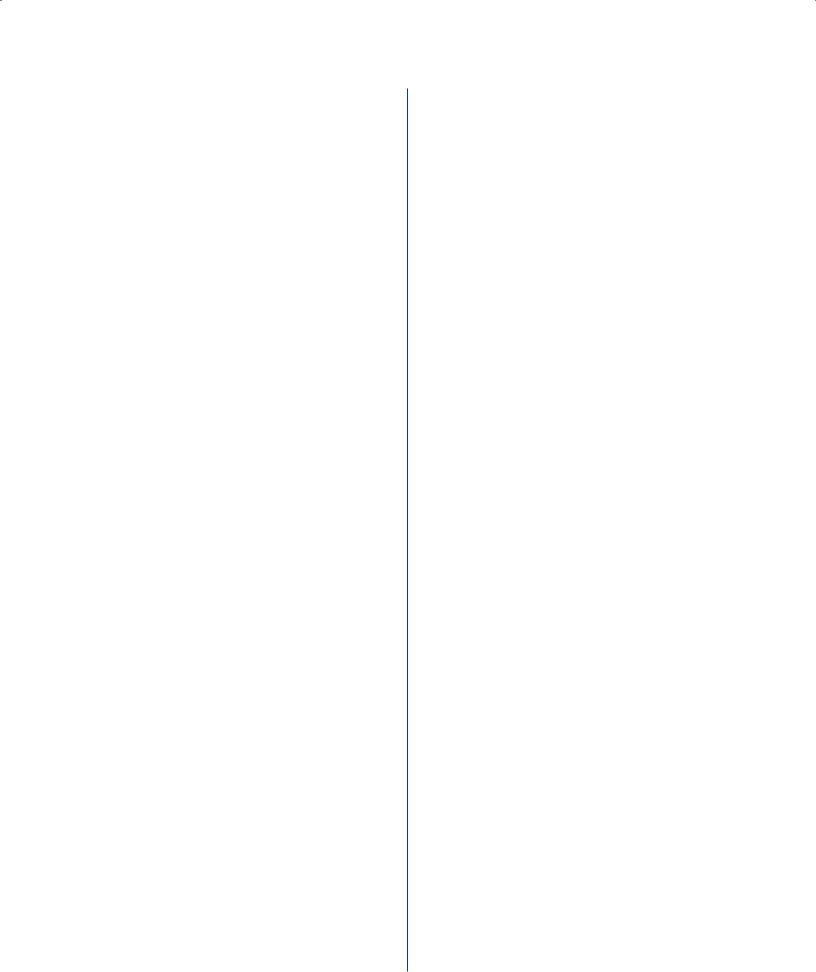
The Official Guide for GMAT® Review 12th Edition
Geometry Triangles
In any triangle, the largest angle is opposite the longest side.
(1)Since x + 2 > x, the longest side is either x + 2 or y; therefore, it is sufficient to determine whether y > x + 2. If y = x + 3 and since x + 3 > x + 2, it follows by
substitution that y > x + 2; SUFFICIENT.
(2)Substituting 2 for x yields that PQ = 2 and
QR = 4, but no information is given as to the relationship of these sides with the value of y given for side PR; NOT sufficient.
The correct answer is A; statement 1 alone is sufficient.
21.What percent of the drama club members enrolled at a certain school are female students?
(1)Of the female students enrolled at the school, 40 percent are members of the drama club.
(2)Of the male students enrolled at the school, 25 percent are members of the drama club.
Arithmetic Percents
Determine what percent of drama club members are female.
(1)Knowing that 40 percent of the females enrolled at the school are in the drama club provides no information about the male/ female breakdown of the drama club; NOT su cient.
(2)Knowing that 25 percent of the males enrolled at the school are in the drama club provides no information about the male/ female breakdown of the drama club; NOT su cient.
Taking (1) and (2) together does not give enough information to determine what percent of drama club members are female. For example, if the school has 100 female students and 100 male students, then the drama club would have
0.40(100) + 0.25(100) = 40 + 25 = 65 members,
40
65 ≈ 62 percent of whom are female. On the
other hand, if the school had 40 female students and 160 male students, the drama club would
have 0.40(40) + 0.25(160) = 16 + 40 =
16
56 members, 56 ≈ 29 percent of whom are female.
The correct answer is E;
both statements together are still not su cient.
22.A family-size box of cereal contains more cereal and costs more than the regular-size box of cereal. What is the cost per ounce of the family-size box of cereal?
(1)The family-size box of cereal contains 10 ounces more than the regular-size box of cereal.
(2)The family-size box of cereal costs $5.40.
Arithmetic Rate problem
Determine the cost per ounce of cereal in the family-size box.
(1)A family-size box contains 10 ounces more cereal than a regular-size box, but there is no information about how many ounces are contained in a regular-size box and no information about the cost of either size box, so there is no way to determine the cost per ounce of cereal in the family-size box; NOT su cient.
(2)A family-size box costs $5.40, but there is no information about how many ounces of cereal a family-size box contains, so there is no way to determine the cost per ounce of cereal in the family-size box; NOT su cient.
Taking (1) and (2) together, a family-size box costs $5.40 and contains 10 ounces more cereal than a regular-size box. However, there is no information about how much cereal a regular-size box contains and, therefore, no way to determine the cost per ounce of the cereal in a family-size box.
The correct answer is E;
both statements together are still not su cient.
23.The profit from the sale of a certain appliance increases, though not proportionally, with the number of units sold. Did the profit exceed $4 million on sales of 380,000 units?
(1)The profit exceeded $2 million on sales of 200,000 units.
(2)The profit exceeded $5 million on sales of 350,000 units.
296
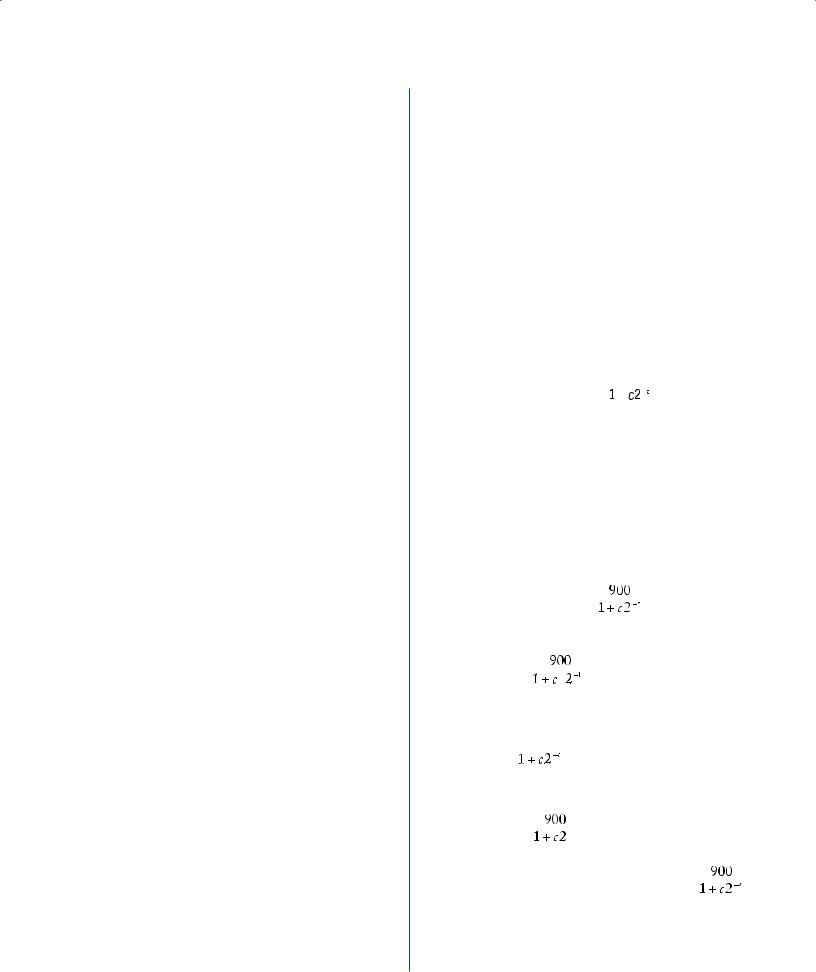
Arithmetic Arithmetic operations; Proportions
(1)If the profits did increase proportionally, it might be reasonable to expect a profit of $4 million on sales of 400,000 units.
However, it is given that the profits do not increase proportionally. Without knowing how the profits increase, it is impossible to tell the profits on sales of 380,000 units; NOT sufficient.
(2)It is given that the profits do increase with the number of units sold. Therefore, since the profit on sales of just 350,000 units well exceeded $4 million, then sales of 350,000 + 30,000 = 380,000 units would also have a profit exceeding $4 million; SUFFICIENT.
The correct answer is B; statement 2 alone is sufficient.
24.If n is an integer, is n even?
(1)n2 – 1 is an odd integer.
(2)3n + 4 is an even integer.
Arithmetic Properties of numbers
Determine if the integer n is even.
(1)Since n2 – 1 is odd, n2 is even and so n is even; SUFFICIENT.
(2)Since 3n + 4 is even, 3n is even and so n is even; SUFFICIENT.
The correct answer is D;
each statement alone is su cient.
25.Carmen currently works 30 hours per week at her part-time job. If her gross hourly wage were to increase by $1.50, how many fewer hours could she work per week and still earn the same gross weekly pay as before the increase?
(1)Her gross weekly pay is currently $225.00.
(2)An increase of $1.50 would represent an increase of 20 percent of her current gross hourly wage.
Arithmetic Operations with rational numbers
Let w be Carmen’s gross hourly wage and let n be the number of hours fewer Carmen will need to work. Find a unique value for n such that
30w = (30 – n)(w + 1.50).
6.5Data Sufficiency Answer Explanations
(1)Since Carmen’s gross weekly pay is currently $225.00, then 30w = 225 and w = 7.50. Substituting 7.50 for w gives 30(7.50) =
(30 – n)(7.50 + 1.50), which can be solved for a unique value of n; SUFFICIENT.
(2)Since 1.50 is 20 percent of Carmen’s current gross hourly pay, 1.50 = 0.20w and w = 7.50. This is the same information that was gained from statement (1) and will lead to the same result; SUFFICIENT.
The correct answer is D;
each statement alone is su cient.
26.The number n of units of its product that Company X is scheduled to produce in month t of its next fi scal year is given by the formula n =  , where c is a
, where c is a
constant and t is a positive integer between 1 and 6, inclusive. What is the number of units of its product that Company X is scheduled to produce in month 6 of its next fi scal year?
(1)Company X is scheduled to produce 180 units of its product in month 1 of its next fi scal year.
(2)Company X is scheduled to produce 300 units of its product in month 2 of its next fi scal year.
Algebra Formulas |
|
|
Given the formula n = |
|
, determine the |
|
||
value of n when t = 6. |
|
|
(1)Given that n = 180 when t = 1, then
180 =  . This equation can be solved for a unique value of c. Then, by
. This equation can be solved for a unique value of c. Then, by
substituting this value for c and 6 for t into n =  , the value of n can be
, the value of n can be
determined; SUFFICIENT.
(2)Given that n = 300 when t = 2, then
300 =  . This equation can be solved
. This equation can be solved
for a unique value of c. Then, by substituting
this value for c and 6 for t into n = |
|
, |
|
||
the value of n can be determined; |
|
|
SUFFICIENT. |
|
|
The correct answer is D;
each statement alone is su cient.
297

The Official Guide for GMAT® Review 12th Edition
27.When 200 gallons of oil were removed from a tank, the volume of oil left in the tank was 73 of the tank’s capacity. What was the tank’s capacity?
(1)Before the 200 gallons were removed, the
volume of oil in the tank was 1 of the tank’s capacity. 2
(2)After the 200 gallons were removed, the volume of the oil left in the tank was 1,600 gallons less than the tank’s capacity.
Arithmetic Operations with rational numbers
Let C be the capacity, in gallons, of the tank and let V be the volume of oil in the tank initially.
3
Then V – 200 = 7 C. Find a unique value for C.
(1)Since the volume of oil in the tank initially
was |
1 |
the tank’s capacity, V = |
1 |
C. Then, |
|||||||
2 |
2 |
||||||||||
|
1 |
1 |
|
|
3 |
|
|||||
substituting |
|
C for V gives |
|
C – 200 = |
7 |
C, |
|||||
2 |
2 |
||||||||||
which can be solved for a unique value of C; SUFFICIENT.
(2)After the 200 gallons were removed, the volume of oil left in the tank was 1,600 gallons less than the tank’s capacity.
T erefore,h since V – 200 = |
3 |
C, |
3 |
C = |
7 |
7 |
C – 1,600. This equation can be solved for a unique value of C; SUFFICIENT.
The correct answer is D;
each statement alone is su cient.
28.Division R of Company Q has 1,000 employees. What is the average (arithmetic mean) annual salary of the employees at Company Q ?
(1)The average annual salary of the employees in Division R is $30,000.
(2)The average annual salary of the employees at Company Q who are not in Division R is $35,000.
Arithmetic Statistics
Determine the average (arithmetic mean) annual salary of the employees at Company Q , given that Division R within Company Q has
1,000 employees.
(1)Although the average annual salary of the 1,000 employees in Division R is given, there is no information about the number
of Company Q employees who are not in Division R or about their annual salaries. Therefore, it is impossible to determine the average annual salary of the employees at
Company Q ; NOT su cient.
(2)Although the average annual salary of the employees NOT in Division R is given, there is no information about the number of employees who are not in Division R.
Therefore, it is impossible to determine the average annual salary of the employees at Company Q ; NOT su cient.
Taking (1) and (2) together does not give the number of employees who are NOT in Division R, which is necessary to determine the average annual salary of the employees of Company Q .
The correct answer is E;
both statements together are still not su cient.
 } x meters
} x meters
29.A circular tub has a band painted around its circumference, as shown above. What is the surface area of this painted band?
(1)x = 0.5
(2)The height of the tub is 1 meter.
Geometry Surface area
The surface area of the band is the product of the circumference of the band and the width of the band. If both factors are known, then the area can be determined, but not if only one of these factors is known.
(1)Only one factor, the width of the band, is known; NOT su cient.
(2)The circumference or the means to find the circumference is not known; NOT su cient.
With (1) and (2) taken together, there still is no information about the circumference of the tub.
The correct answer is E;
both statements together are still not su cient.
298
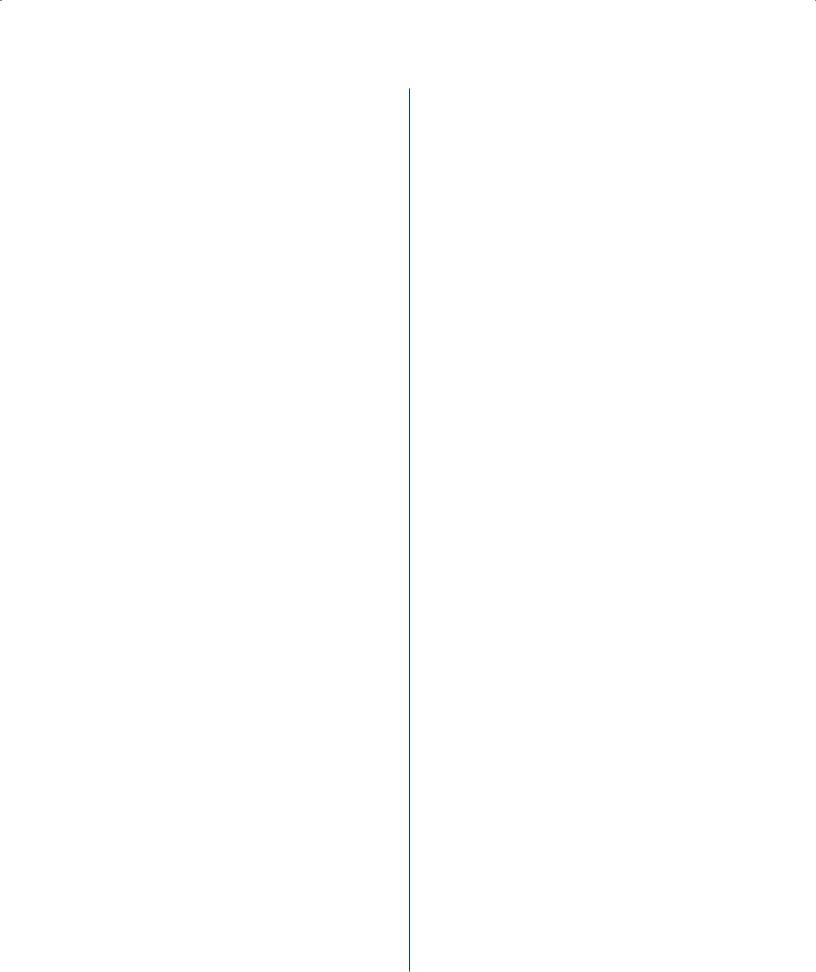
30.What is the value of integer n ?
(1)n( n + 1) = 6
(2)22n = 16
Arithmetic; Algebra Arithmetic operations; Firstand second-degree equations
(1)If (n + 1) is multiplied by n, the result is
n2 + n = 6. If 6 is subtracted from both sides, the equation becomes n2 + n – 6 = 0. This in turn can be factored as (n + 3)(n – 2) = 0.
Therefore, n could be either –3 or 2, but there is no further information for deciding between these two values; NOT sufficient.
(2)From 22n = 16, 22n must equal 24 (since 2 × 2 × 2 × 2 = 16). Therefore, 2n = 4 and n = 2; SUFFICIENT.
The correct answer is B; statement 2 alone is sufficient.
d = 0.43t 7
31.If t denotes the thousandths digit in the decimal representation of d above, what digit is t ?
(1)If d were rounded to the nearest hundredth, the result would be 0.44.
(2)If d were rounded to the nearest thousandth, the result would be 0.436.
Arithmetic Place value; Rounding
Determine t, the thousandths digit of d = 0.43t 7.
(1)Since d rounded to the nearest hundredth is
0.44, t can be 5, 6, 7, 8, or 9 because each of 0.4357, 0.4367, 0.4377, 0.4387, and 0.4397 rounded to the nearest hundredth is 0.44;
NOT su cient.
(2)Since d rounded to the nearest thousandth is 0.436 and the digit in ten-thousandths place of d is 7, the digit in thousandths place gets increased by 1 in the rounding process. Thus, t + 1 = 6 and t = 5; SUFFICIENT.
The correct answer is B; statement 2 alone is su cient.
6.5Data Sufficiency Answer Explanations
32.Jerry bought 7 clothing items, including a coat, and the sum of the prices of these items was $365. If there was no sales tax on any clothing item with a price of less than $100 and a 7 percent sales tax on all other clothing items, what was the total sales tax on the 7 items that Jerry bought?
(1)The price of the coat was $125.
(2)The average (arithmetic mean) price for the 6 items other than the coat was $40.
Arithmetic Applied problems
Determine the amount of sales tax Jerry paid on the purchase of 7 items of clothing that included a coat and totaled $365, where there was no tax on any item with a price less than $100 and 7 percent tax on all other items.
(1)Although Jerry paid sales tax on the price of the coat, which was $125, and the total price of the other 6 items was $365 – $125 = $240, no information is given on the individual prices of the other 6 items, which may or may not have been less than $100 and subject to sales tax; NOT su cient.
(2)Although the average price of the other
6 items was $40, no information is given on the individual prices of the other 6 items, which may or may not have been over $100, and therefore may or may not have been subject to sales tax; NOT su cient.
Taking (1) and (2) together, Jerry paid at least 0.07(125) = $8.75 in sales tax, but no information is given about whether any of the other 6 prices were subject to sales tax. If the price of each of the other 6 items was $40, then Jerry would have paid only $8.75 in sales tax. However, if the price of each of 2 items was $100 and the other 4 items were $10 each, Jerry would have paid a total of
0.07(125 + 100 + 100) = $22.75 in sales tax.
The correct answer is E;
both statements together are still not su cient.
299
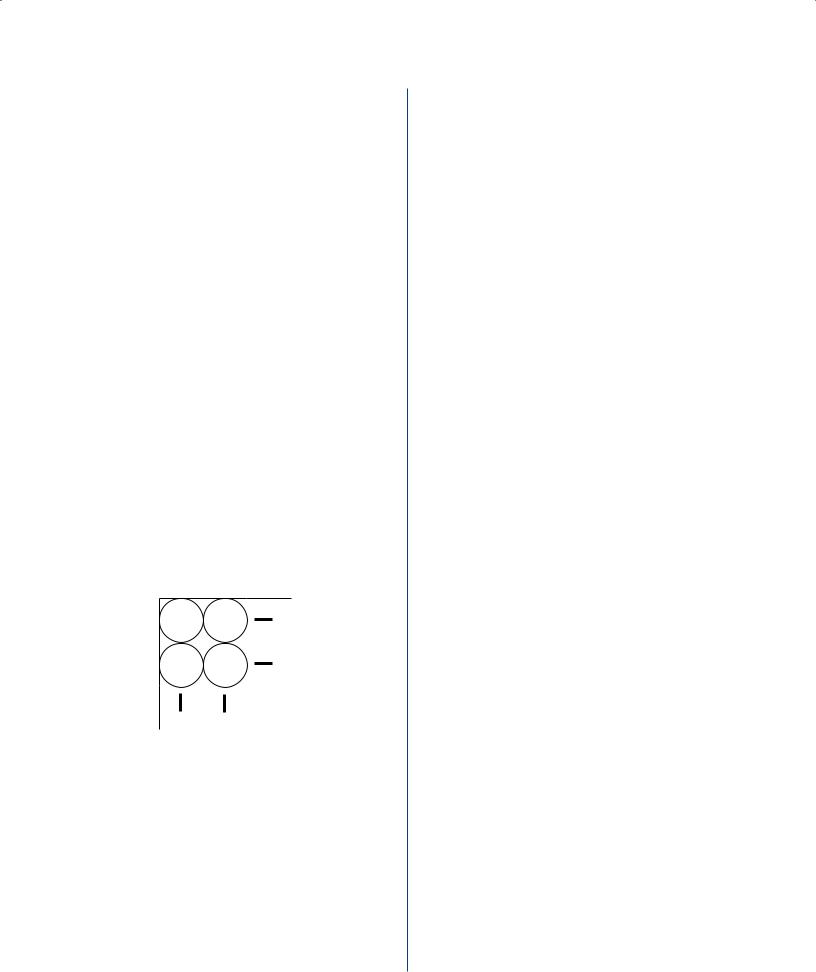
The Official Guide for GMAT® Review 12th Edition
33.What was the price at which a merchant sold a certain appliance?
(1)The merchant’s gross profi t on the appliance was 20 percent of the price at which the merchant sold the appliance.
(2)The price at which the merchant sold the appliance was $50 more than the merchant’s cost of the appliance.
Algebra Applied problems
Let R, C, and P be the appliance’s selling price, the merchant’s cost, and the gross profit, respectively. Determine the value of R.
(1)Since R – C = P and P = 0.20R, then R – C = 0.2R and 0.8R = C. No information is given about the value of C, so the value of R cannot be determined; NOT su cient.
(2)Although R = C + 50, no information is given about the value of C, so the value of R cannot be determined; NOT su cient.
Taking (1) and (2) together and combining the two equations gives R = 0.8R + 50, which can be solved for a unique value of R.
The correct answer is C;
both statements together are su cient.
34.The inside of a rectangular carton is 48 centimeters long, 32 centimeters wide, and 15 centimeters high. The carton is filled to capacity with k identical cylindrical cans of fruit that stand upright in rows and columns, as indicated in the figure above. If the cans are 15 centimeters high, what is the value of k ?
(1)Each of the cans has a radius of 4 centimeters.
(2)Six of the cans fit exactly along the length of the carton.
Geometry Circles
(1)If the radius of each can is 4 centimeters, the diameter of each can is 8 centimeters.
Along the 48-centimeter length of the carton, 6 cans (48 ÷ 8) can be placed; along the 32-centimeter width of the carton,
4 cans (32 ÷ 8) can be placed. Hence, k = 6 × 4 = 24; SUFFICIENT.
(2)If 6 cans fit along the 48-centimeter length of the carton, this implies that the diameter of each can is 8 centimeters (48 ÷ 6). Along
the 32 centimeter width, 4 cans can be placed, and again k = 6 × 4 = 24; SUFFICIENT.
The correct answer is D;
each statement alone is sufficient.
x |
− 4 |
= z |
|
− x |
= 8 |
y |
||
|
− z |
= t |
8 |
35.For the system of equations given, what is the value of z ?
(1)x = 7
(2)t = 5
Algebra Firstand second-degree equations
(1)Since x = 7, then 7 can be substituted for x in the equation x – 4 = z, yielding z = 3; SUFFICIENT.
(2)If t = 5, then the equation 8 – z = t can be used to solve this question:
8 |
– z = 5 |
substitute for t |
3 |
– z = 0 |
subtract 5 from both sides |
3 |
= z |
add z to both sides; |
|
|
SUFFICIENT. |
The correct answer is D;
each statement alone is sufficient.
36.For all integers n, the function f is defi ned by f(n) = an, where a is a constant. What is the value of f(1) ?
(1)f(2) = 100
(2)f(3) = –1,000
300
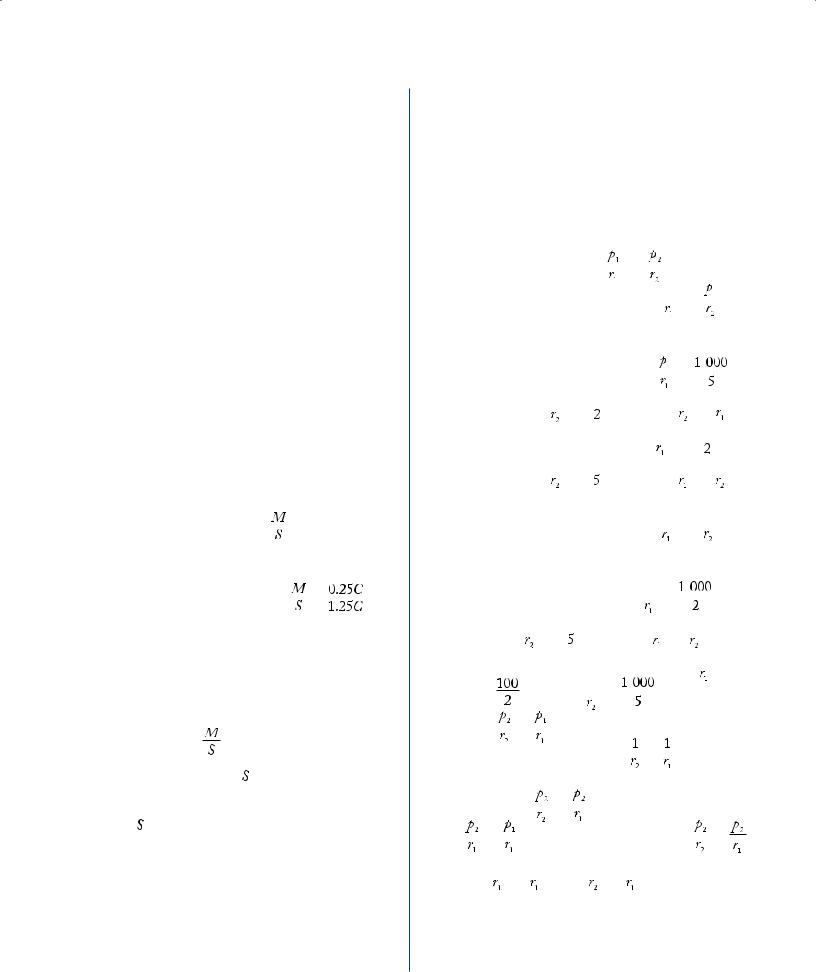
Algebra Functions
Given f(n) = an, find the value of f(1).
(1)Given that f(2) = 100, a2 = 100, from which a = 10 or a = –10. Then, f(1) = 101 = 10 or
f(1) = (–10)1 = –10; NOT su cient.
(2)Given that f(3) = –1,000, a3 = –1,000, from which a = –10. Then, f(1) = (–10)1 = –10; SUFFICIENT.
The correct answer is B; statement 2 alone is su cient.
37.The selling price of an article is equal to the cost of the article plus the markup. The markup on a certain television set is what percent of the selling price?
(1)The markup on the television set is 25 percent of the cost.
(2)The selling price of the television set is $250.
Algebra Percents
Let S be the selling price of the television; C, the cost; and M, the markup, all in dollars. Then,
S = C + M. Find the value of |
|
as a percent. |
|
(1)Since the markup on the television is 25 percent of the cost, M = 0.25C. Then,
S = C + 0.25C = 1.25C and |
|
= |
|
= |
|
|
0.20, which, as a percent is 20 percent; SUFFICIENT.
(2)The selling price of the television is $250, so 250 = S = C + M. However, there is no information as to the values of either C or M. Therefore, it is impossible to determine
the value of . For example, if C = 200 and M = 50, then  = 0.20 or 20 percent,
= 0.20 or 20 percent,
but if C = 150 and M = 100, then
 = 0.40 or 40 percent; NOT su cient.
= 0.40 or 40 percent; NOT su cient.
The correct answer is A; statement 1 alone is su cient.
6.5Data Sufficiency Answer Explanations
38.If p1 and p2 are the populations and r1 and r2 are the numbers of representatives of District 1 and District 2,
respectively, the ratio of the population to the number of representatives is greater for which of the two districts?
(1)p1 > p2
(2)r2 > r1
Algebra Ratios
Determine which ratio, |
|
or |
|
, is greater. |
|
|
(1)Even if p1 > p2, which ratio,  or
or  , is
, is
greater depends of the values of r1 and r2.
For example, if p1 = 1,000, p2 = 500, then p1 > p2. If r1 = 5 and r2 = 2,  =
=  = 200 and
= 200 and  =
=  = 250, so
= 250, so  >
>  . If however, r1 = 2 and r2 = 5,
. If however, r1 = 2 and r2 = 5,  =
= 

 =
=
500 and  =
=  = 100, so
= 100, so  >
>  ; NOT su cient.
; NOT su cient.
(2)Even if r2 > r1, which ratio,  or
or  , is
, is
greater depends of the values of p1 and p2. For example, if r1 = 2, r2 = 5, then r2 > r1. If p1 = 1,000 and p2 = 500,  =
=  = 500 and
= 500 and  =
=  = 100, so
= 100, so  >
>  . If however, p1 = 100 and p2 = 1,000,
. If however, p1 = 100 and p2 = 1,000,  =
=
=50 and  =
=  = 200, so
= 200, so
|
|
> |
|
; NOT su cient. |
|
|
||
|
|
|
|
|
||||
Taking (1) and (2) together, |
|
< |
|
because |
||||
|
|
|||||||
r2 > r1, and because populations can be assumed to
be positive, |
|
< |
|
. Then, it follows that |
|
||||||
|
|
|
|||||||||
|
|
< |
|
because p2 < p1. Combining |
|
|
< |
||||
|
|
|
|
||||||||
and  <
<  gives
gives  <
<  .
.
The correct answer is C;
both statements together are su cient.
301

The Official Guide for GMAT® Review 12th Edition
39.In a random sample of 80 adults, how many are college graduates?
(1)In the sample, the number of adults who are not college graduates is 3 times the number who are college graduates.
(2)In the sample, the number of adults who are not college graduates is 40 more than the number who are college graduates.
Algebra First-degree equations
Let C be the number of college graduates and let N be the number who are not college graduates. Then, C + N = 80. Find the value of C.
(1)Since the number who are not college graduates is 3 times the number who are, N = 3C. Then C + 3C = 80, 4C = 80, and
C = 20; SUFFICIENT.
(2)Since the number who are not college graduates is 40 more than the number who are college graduates, N = C + 40. Then
C + (C + 40) = 80, 2C + 40 = 80, 2C = 40, and C = 20; SUFFICIENT.
The correct answer is D;
each statement alone is su cient.
R |
R |
S |
T |
U |
0 |
y |
x |
62 |
|
S |
y |
0 |
56 |
75 |
T |
x |
56 |
0 |
69 |
U |
62 |
75 |
69 |
0 |
40.The table above shows the distance, in kilometers, by the most direct route, between any two of the four cities, R, S, T, and U. For example, the distance between City R and City U is 62 kilometers. What is the value of x ?
(1)By the most direct route, the distance between S and T is twice the distance between S and R.
(2)By the most direct route, the distance between T and U is 1.5 times the distance between R and T.
Arithmetic; Algebra Tables; First-degree equations
The value of x is the distance between City R and
City T; the value of y is the distance between
City R and City S.
(1)From this, it can be determined only that
56 = 2y. No information is given about x;
NOT sufficient.
(2)This statement yields the equation 1.5x = 69, which can be solved for x; SUFFICIENT.
The correct answer is B; statement 2 alone is sufficient.
41.What is the value of the two-digit integer x ?
(1)The sum of the two digits is 3.
(2)x is divisible by 3.
Arithmetic Properties of numbers
In a problem of this kind, digits are the integers from 0 through 9, inclusive.
(1)From this, the two-digit integer must be 12, 21, or 30. However, a single numerical value of x cannot be determined; NOT sufficient.
(2)Since there are many two-digit integers divisible by 3, for example, 15, 24, and 27, once again a single numerical value of x cannot be determined; NOT sufficient.
Since all three numbers from (1) are also divisible by 3, (1) and (2) taken together do not provide sufficient information to identify the value of x.
The correct answer is E;
both statements together are still not sufficient.
r |
t |
42.The fi gure above shows the circular cross section of a concrete water pipe. If the inside radius of the pipe is r feet and the outside radius of the pipe is t feet, what is the value of r ?
302

(1)The ratio of t – r to r is 0.15 and t – r is equal to 0.3 foot.
(2)The area of the concrete in the cross section is 1.29π square feet.
Geometry Circles; Area
Determine the value of r.
(1) Since |
t − r |
= 0.15 and t – r = 0.3, then |
||||
r |
||||||
0.3 |
|
|
0.3 |
|
||
= 0.15 and r = |
= 2; SUFFICIENT. |
|||||
0.15 |
||||||
r |
|
|
|
|
||
(2)The area of the concrete in the cross section is the area of the circular region with radius t minus the area of the circular region with radius r. The area of a circular region with radius R is πR2 , so the area of the concrete in the cross section is πt2 – πr2. This area is 1.29π, so πt2 – πr2 = 1.29π, and t2 – r2 = 1.29, from which it is impossible to determine a
unique value for r. For example, if t = 2.29 , then r = 1, but if t = 5.29 , then r = 2;
NOT su cient.
The correct answer is A; statement 1 alone is su cient.
43.What is the tenths digit in the decimal representation of a certain number?
1
(1)The number is less than 3. 1
(2)The number is greater than 4.
Arithmetic Properties of numbers
(1) Since the number is less than , the tenths
digit can be 0, 1, 2, or 3; NOT su cient.
(2)Since the number is greater than 1, the
4 tenths digit can be 2, 3, 4, …, 9; NOT
su cient.
From (1) and (2) taken together, the number, n, is
greater than but less than . The tenths digit
can be 2 or 3.
The correct answer is E;
both statements together are still not su cient.
6.5Data Sufficiency Answer Explanations
44.Robots X, Y, and Z each assemble components at their
respective constant rates. If rx is the ratio of Robot X’s constant rate to Robot Z’s constant rate and ry is the ratio of Robot Y’s constant rate to Robot Z’s constant
rate, is Robot Z’s constant rate the greatest of the three?
(1)rx < ry
(2)ry < 1
Algebra Ratios
Let X, Y, and Z represent the constant rates of Robots X, Y, and Z, respectively. Then rx = ZX and ry = ZY . Determine if Z is the greatest of X,
Y, and Z.
X < Y
Z Z
However, no information is given about the value of Z in relation to the values of X and
Y; NOT su cient.
(2)Since ry < 1, then Y < 1 and Y < Z.
Z
However, no information is given about the value of X in relation to the values of Y and
Z; NOT su cient.
Taking (1) and (2) together, X < Y from (1) and
Y < Z from (2), so X < Z. Thus, Z is greater than both X and Y and is the greatest of the three.
The correct answer is C;
both statements together are su cient.
45.If r is a constant and an = rn for all positive integers n, for how many values of n is an < 100 ?
(1)a50 = 500
(2)a100 + a105 = 2,050
Algebra Sequences and series
Determine how many values of n there are such that an < 100, where an = rn and r is a constant.
(1)a50 = 500, so 50r = 500 and r = 10. Thus, an < 100 for n = 1, 2, 3, …, 9 and for no other values of n; SUFFICIENT.
303
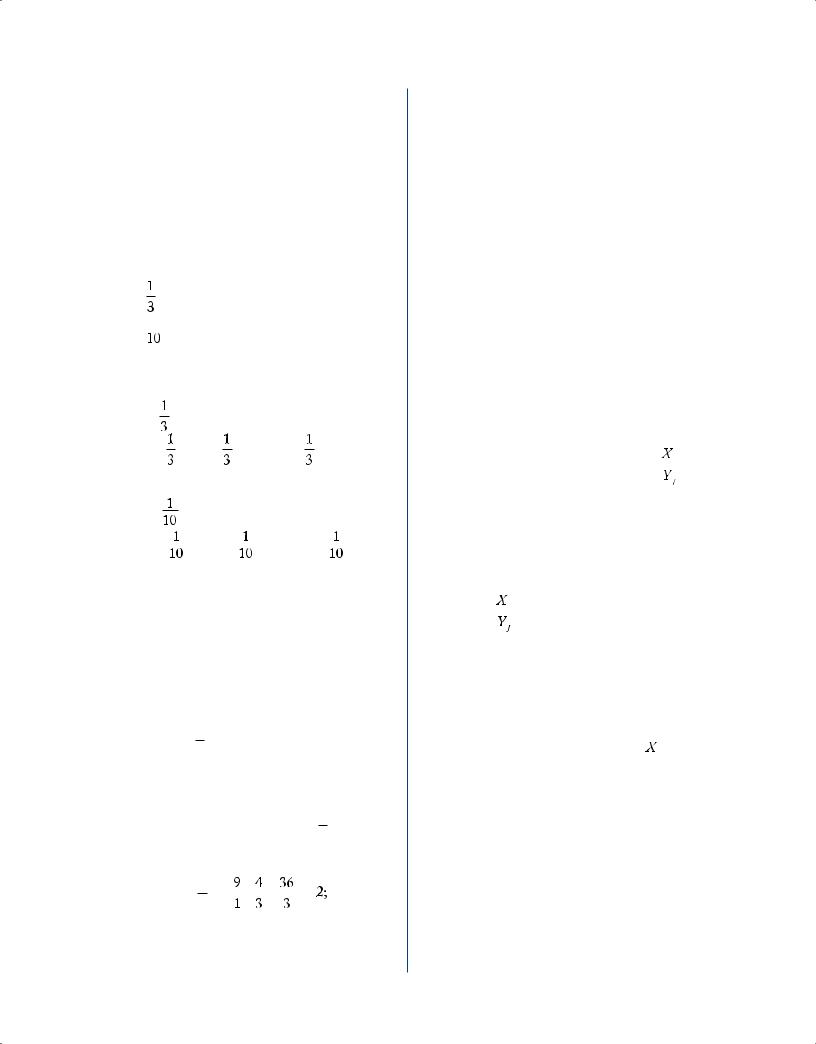
The Official Guide for GMAT® Review 12th Edition
(2)a100 + a105 = 2,050, so 100r + 105r = 2,050. Then 205r = 2,050 and r = 10. This is
the same information obtained from (1), and because (1) is su cient, so is (2); SUFFICIENT.
The correct answer is D;
each statement alone is su cient.
46.If r is represented by the decimal 0.t5, what is the digit t ?
(1)r <
(2)r < 
Arithmetic Place value
If r = 0.t 5, find the digit t.
(1)If r < , then t can be 0, 1, or 2 since 0.05 < , 0.15 < , and 0.25 < ; NOT su cient.
(2)If r < , then t must be 0, because
0.15 > |
|
, 0.25 |
> |
|
, …, 0.95 > |
|
; |
|
|
|
|||||
SUFFICIENT. |
|
|
|
|
|
||
The correct answer is B; statement 2 alone is su cient.
47.If the two floors in a certain building are 9 feet apart, how many steps are there in a set of stairs that extends from the first floor to the second floor of the building?
(1)Each step is 3 foot high.
4
(2)Each step is 1 foot wide.
Arithmetic Arithmetic operations
(1)If each step in the set of stairs is 3 foot high
4
and the set of stairs rises 9 feet from the first floor to the second, the number of steps
must be 9 ÷ 3, or 






4
SUFFICIENT.
(2)This provides no information regarding the height of the steps, and so the question cannot be answered; NOT sufficient.
The correct answer is A; statement 1 alone is su cient.
48.In June 1989, what was the ratio of the number of sales transactions made by Salesperson X to the number of sales transactions made by Salesperson Y ?
(1)In June 1989, Salesperson X made 50 percent more sales transactions than Salesperson Y did in May 1989.
(2)In June 1989, Salesperson Y made 25 percent more sales transactions than in May 1989.
Arithmetic Ratios; Percents
Let XJ be the number of sales transactions made by Salesperson X in June 1989 and let YJ be
the number of sales transactions made by
Salesperson Y in June 1989. Find  .
.
(1)Salesperson X made 50 percent more sales transactions in June 1989 than Salesperson Y made in May 1989, but no information is given about how many sales transactions
Salesperson Y made in June 1989. Therefore, it is impossible to determine the value of
 ; NOT su cient.
; NOT su cient.
(2)Salesperson Y made 25 percent more sales transactions in June 1989 than in May 1989, but no information is given about how many sales transactions Salesperson Y made in
May 1989. Therefore, it is impossible to determine the value of Yj and also impossible
to determine the value of  ; NOT su cient.
; NOT su cient. 
Taking (1) and (2) together, if XM is the number of sales transactions made by Salesperson X
in May 1989 and YM is the number of sales transactions made by Salesperson Y in May 1989,
(1) gives XJ = 1.5YM and (2) gives YJ = 1.25YM.
304
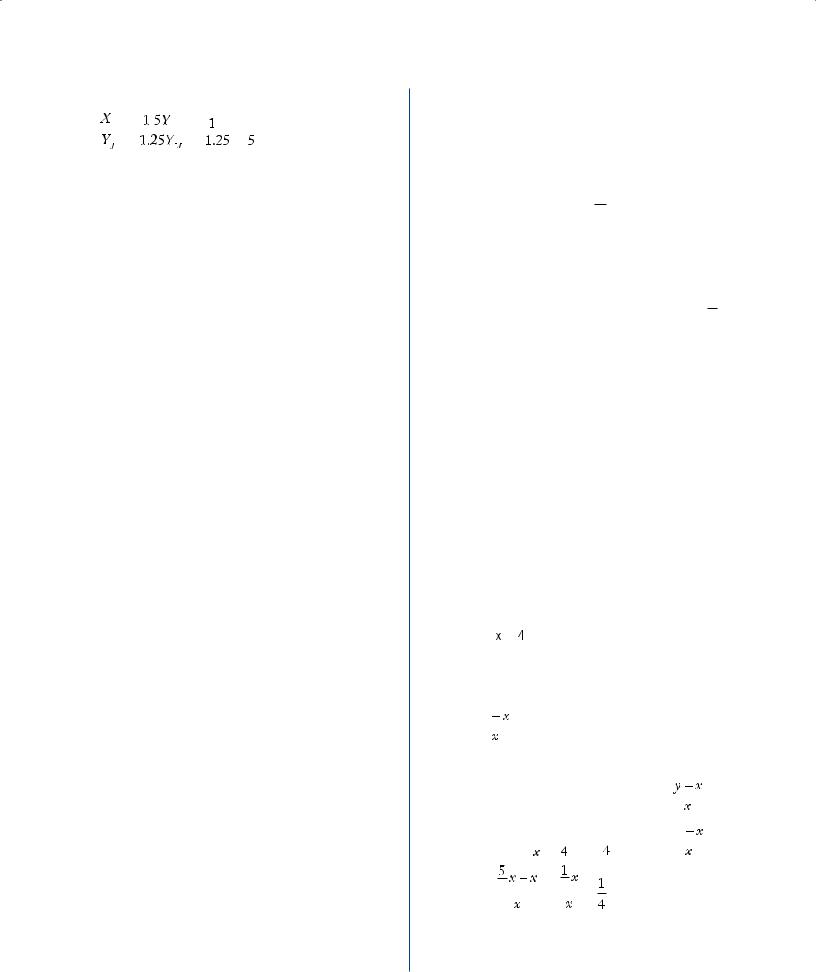
Combining these two equations gives
 =
=  =
= 

 .
.
The correct answer is C;
both statements together are su cient.
49.If a < x < b and c < y < d, is x < y ?
(1)a < c
(2)b < c
Algebra Inequalities
Given a < x < b and c < y < d, determine if x < y.
(1)Even though a < c, there is no information on the relative size of x and c. For example, if a = 3, x = 10, b = 12, c = 4, y = 6, and d = 7, a < c because 3 < 4 and x > y, since 10 > 6. If, on the other hand, a = 3, x = 4, b = 12, c = 4, y = 6, and d = 7, a < c because 3 < 4 and x < y, since 4 < 6. NOT su cient.
(2)If b < c, then a < x < b < c < y < d and so x < y;
SUFFICIENT.
The correct answer is B; statement 2 alone is su cient.
50.How many people are directors of both Company K and Company R ?
(1)There were 17 directors present at a joint meeting of the directors of Company K and Company R, and no directors were absent.
(2)Company K has 12 directors and Company R has 8 directors.
Algebra Sets
(1)This clarifies that Company K and
Company R together have 17 individuals serving as directors. However, there is no information as to the distribution of the Company K directors, the Company R directors, and the joint directors; NOT sufficient.
(2)This gives the number of directors in each company but no information as to the number of joint directors; NOT sufficient.
Taking (1) and (2) together, it is known from (2) that there are 20 directorships in all. If at a joint
6.5 Data Sufficiency Answer Explanations
meeting, there are only 17 people present, then 20 – 17 = 3 people must be joint directors.
The correct answer is C;
both statements together are sufficient.
51.If x and y are positive, is x greater than 1 ?
y
(1)xy > 1
(2)x – y > 0
Algebra Inequalities
Since, being positive, y > 0, it follows that x > 1 if and only if x > y. y
(1)There are innumerable pairs of di erent numbers x and y whose product xy is greater than 1. The larger number in each pair can be either x or y; NOT sufficient.
(2)x – y > 0 is equivalent to x > y; SUFFICIENT.
The correct answer is B; statement 2 alone is sufficient.
52.A clothing store acquired an item at a cost of x dollars and sold the item for y dollars. The store’s gross
profi t from the item was what percent of its cost for the item?
(1)y – x = 20
(2)


Algebra Applied problems
If the cost of an item of clothing is x and the selling price of the item is y, determine the value
of  as a percent.
as a percent.
(1)Although y – x = 20, there is no information to determine the value of x and therefore no
way to determine the value of |
|
; NOT |
|
||
su cient. |
|
|
(2)Since  =
=  , y =
, y =  x, and so
x, and so  =
=
 =
=  = , which is 25 percent;
= , which is 25 percent;
SUFFICIENT.
The correct answer is B; statement 2 alone is su cient.
305
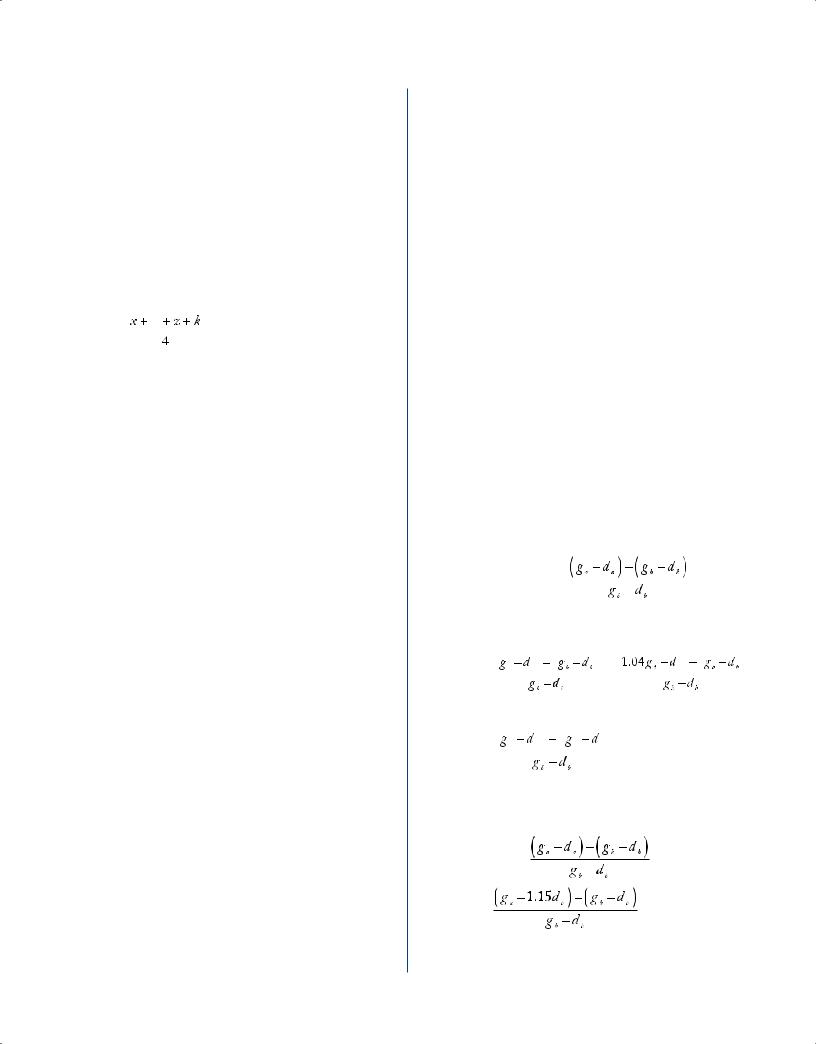
The Official Guide for GMAT® Review 12th Edition
(n – x) + (n – y) + (n – z) + (n – k)
53.What is the value of the expression above?
(1)The average (arithmetic mean) of x, y, z, and k is n.
(2)x, y, z, and k are consecutive integers.
Arithmetic Statistics
Determine the value of (n – x) + (n – y) + (n – z) +
(n – k), which can be rewritten as
4n – (x + y + z + k).
(1)Since the average of x, y, z, and k is n, then
 = n and x + y + z + k = 4n.
= n and x + y + z + k = 4n.
T us, 4hn – (x + y + z + k) = 4n – 4n = 0;
SUFFICIENT.
(2)Even though x, y, z, and k are consecutive integers, no other information is given about the values of x, y, z, k, or n; NOT su cient.
The correct answer is A; statement 1 alone is su cient.
54.A taxi company charges f cents for the fi rst mile of the taxi ride and m cents for each additional mile. How much does the company charge for a 10-mile taxi ride?
(1)The company charges $0.90 for a 2-mile ride.
(2)The company charges $1.20 for a 4-mile ride.
Arithmetic Applied problems
If a taxi company charges f cents for the first mile and m cents for each additional mile, determine the charge for a 10-mile taxi ride, which can be expressed as f + 9m.
(1)Since the charge for a 2-mile ride is $0.90, f + m = 0.90, and so f + 9m = 0.90 + 8m, but the value of m is unknown; NOT su cient.
(2)Since the charge for a 4-mile ride is $1.20,
f + 3m = 1.20, and so f + 9m = 1.20 + 6m, but the value of m is unknown; NOT su cient.
Taking (1) and (2) together and subtracting
the equation in (1) from the equation in (2) gives 2m = 0.30 from which m = 0.15. Then from (1),
f + 0.15 = 0.90 and f = 0.75. Therefore, the charge for a 10-mile taxi ride is $0.75 + 9($0.15) = $2.10.
Alternatively, the graphs of f + m = 0.90 and f + 3m = 1.20 in the ( f,m) coordinate plane are lines that intersect at exactly one point, and
therefore values of f and m can be determined, from which f + 9m can then be determined.
The correct answer is C;
both statements together are su cient.
55.Guy’s net income equals his gross income minus his deductions. By what percent did Guy’s net income change on January 1, 1989, when both his gross income and his deductions increased?
(1)Guy’s gross income increased by 4 percent on January 1, 1989.
(2)Guy’s deductions increased by 15 percent on January 1, 1989.
Arithmetic Percents
Let gb represent Guy’s gross income and db Guy’s deductions before January 1, 1989. Let ga represent Guy’s gross income and da Guy’s deductions after January 1, 1989. Determine by what percent Guy’s net income (gross income minus deductions) changed on January 1, 1989, when both his gross income and his deductions
increased, or find |
|
|
|
as a |
|
|
|
||
percent. |
|
|
|
|
|
|
|
|
(1)Guy’s gross income increased by 4 percent on January 1, 1989, so ga = 1.04gb. Then,





 =
= 



 .
.
However, no information is given about the values of gb, da, or db, and so
 cannot be determined;
cannot be determined;
NOT su cient.
(2)Guy’s deductions increased by 15 percent on January 1, 1989, so da = 1.15db.
T en, h |
|
|
= |
. However, no
306
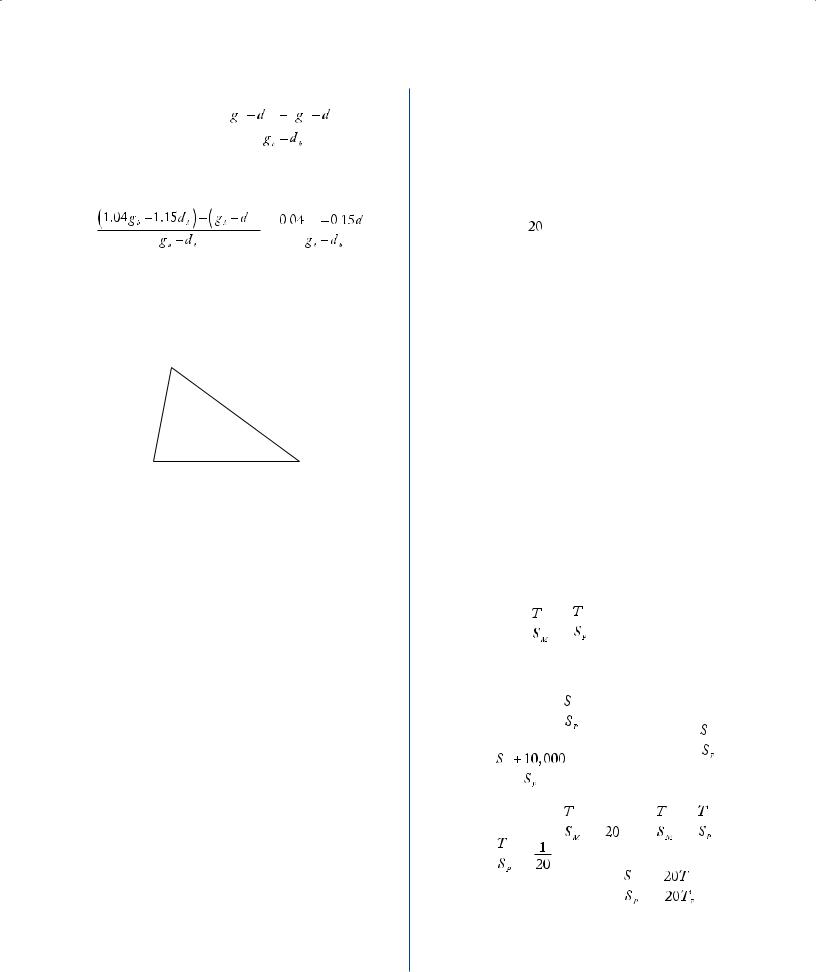
information is given about the values of ga, gb, or db, and so 
cannot be determined; NOT su cient.
Taking (1) and (2) together gives

 =
=  ,
,
which cannot be determined since the values of gb and db are unknown.
The correct answer is E;
both statements together are still not su cient.
y°
x° |
z° |
56.What is the value of z in the triangle above?
(1)x + y = 139
(2)y + z = 108
Geometry Triangles
In any triangle the sum of the interior angles is 180°; here, x + y + z = 180.
(1)Since the sum of x + y is known, the value of z can be determined by substituting 139 for x + y in x + y + z = 180; SUFFICIENT.
(2)Since the sum of y + z is known, the value of x can be determined by substitution, but there is no way to determine the value of z in the sum y + z; NOT sufficient.
The correct answer is A; statement 1 alone is sufficient.
57.Max has $125 consisting of bills each worth either $5 or $20. How many bills worth $5 does Max have?
(1)Max has fewer than 5 bills worth $5 each.
(2)Max has more than 5 bills worth $20 each.
Arithmetic Operations with integers
Let the integer x be the number of bills worth $5 each and let the integer y be the number of bills
6.5 Data Sufficiency Answer Explanations
worth $20 each. Then 5x + 20y = 125. Determine the value of x.
(1)Given that x < 5, then x = 0, 1, 2, 3, or 4. If x is even, then 5x + 20y is even and therefore cannot equal 125. If x = 3, then 15 + 20y =
125, from which it follows that 20y = 110.
But, 
 is not an integer and so x ≠ 3.
is not an integer and so x ≠ 3.
T us, xh = 1; SUFFICIENT.
(2)Given that y > 5, then y ≥ 6. If y ≥ 7, then 20y ≥ 140 and so 5x + 20y ≠ 125. Therefore, y = 6 and 5x + 20(6) = 125, so x = 1;
SUFFICIENT.
The correct answer is D;
each statement alone is su cient.
58.If the ratio of the number of teachers to the number of students is the same in School District M and School District P, what is the ratio of the number of students in School District M to the number of students in School District P ?
(1)There are 10,000 more students in School District M than there are in School District P.
(2)The ratio of the number of teachers to the number of students in School District M is 1 to 20.
Algebra Ratios
Given that  =
=  , where TM and SM are the
, where TM and SM are the
numbers of teachers and students, respectively, in District M, and TP and SP are the numbers of teachers and students, respectively, in District P,
find the value of  .
.
(1)Given that SM = SP + 10,000, then  =
=
 , but the value of SP is unknown; NOT su cient.
, but the value of SP is unknown; NOT su cient.
(2)Given that  =
=  and
and  =
=  , then
, then
 = . Therefore, SP = 20TP and SM =
= . Therefore, SP = 20TP and SM =
20TM. It follows that  =
=  , but the
, but the
values of TM and TP are unknown; NOT su cient.
307
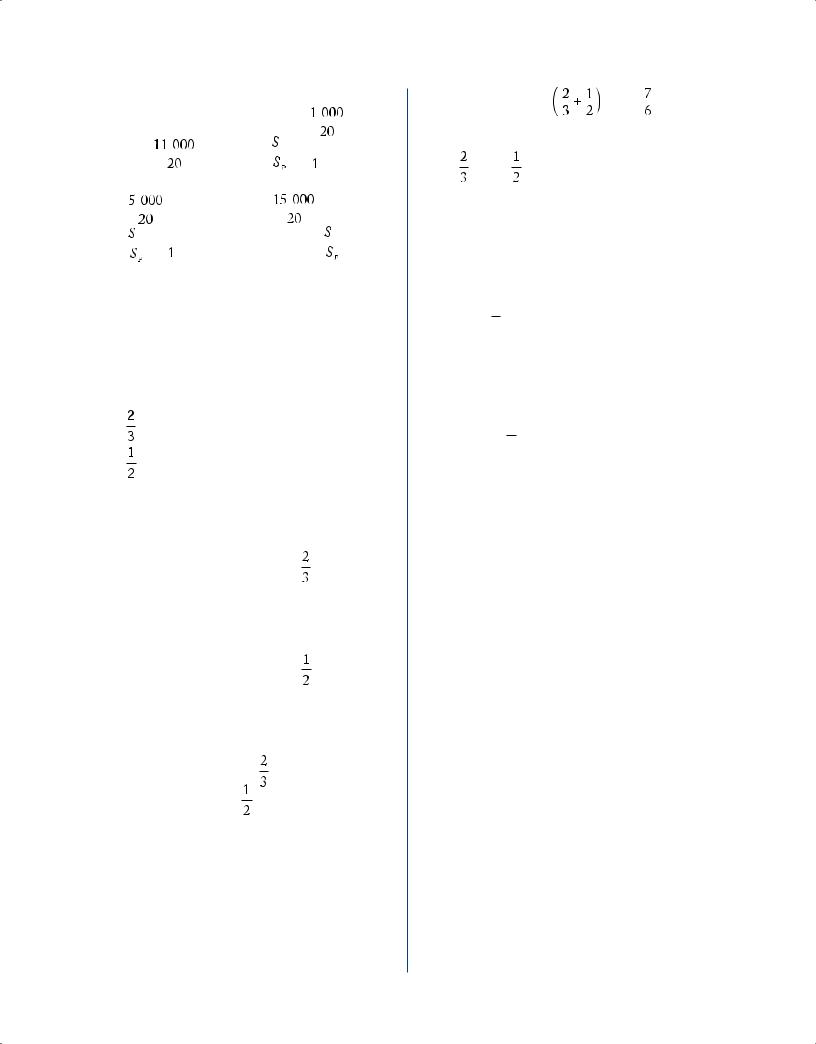
The Official Guide for GMAT® Review 12th Edition
Taking (1) and (2) together, if SP = 1,000,
SM = 1,000 + 10,000 = 11,000, TP =  = 50, and TM =
= 50, and TM =  = 550, then
= 550, then  =
=  . However, if SP = 5,000, SM = 5,000 + 10,000, = 15,000,
. However, if SP = 5,000, SM = 5,000 + 10,000, = 15,000,
TP =  = 250, and TM =
= 250, and TM =  = 750,
= 750,
then  =
=  . Therefore, the value of
. Therefore, the value of  cannot be determined.
cannot be determined.
The correct answer is E;
both statements together are still not su cient.
59.If a total of 84 students are enrolled in two sections of a calculus course, how many of the 84 students are female?
(1)of the students in Section 1 are female.
(2)of the students in Section 2 are male.
Arithmetic Operations with rational numbers
Determine how many of the 84 students in two sections of a calculus course are female.
(1) Even though it is known that of the
students in Section 1 are female, no information is given about the number of students, male or female, in each of the two sections; NOT su cient.
(2) Even though it is known that of the
students in Section 2 are male, no information is given about the number
of students, male or female, in each of the two sections; NOT su cient.
Taking (1) and (2) together, of the students in Section 1 are female and of the students in
Section 2 are female. However, there is no information about how many of the 84 students in the two sections combined are in Section 1 and how many are in Section 2. Therefore, it is impossible to determine how many females there are among the 84 students. For example, if there are 42 students in each section, the number of
females is then |
|
|
|
(42) = |
|
(42) = 49. But if |
|
|
|
|
there are 24 students in Section 1 and 60 students in Section 2, then the number of females is
(24) + (60) = 16 + 30 = 46.
The correct answer is E;
both statements together are still not su cient.
60.What is the value of n in the equation –25 + 19 + n = s ?
(1)s = 2
(2)n = 4 s
Algebra Firstand second-degree equations
(1)If s = 2, then the equation becomes
–25 + 19 + n = 2 or –6 + n = 2 or n = 8; SUFFICIENT.
(2)If n = 4, then n = 4s. By substituting this s
value of n in the given equation and simplifying, the equation becomes: –25 + 19 + 4s = s or –6 + 3s = 0 or s = 2. Once s is found to be 2, the original equation can be solved as above;
SUFFICIENT.
The correct answer is D;
each statement alone is sufficient.
61.At a certain picnic, each of the guests was served either a single scoop or a double scoop of ice cream. How many of the guests were served a double scoop of ice cream?
(1)At the picnic, 60 percent of the guests were served a double scoop of ice cream.
(2)A total of 120 scoops of ice cream were served to all the guests at the picnic.
Arithmetic Percents
(1)The total number of guests is unknown, and thus 60% of the total is also unknown; NOT sufficient.
(2)The total number of scoops served is known, but the ratio between single scoops and double scoops is unknown; NOT sufficient.
308
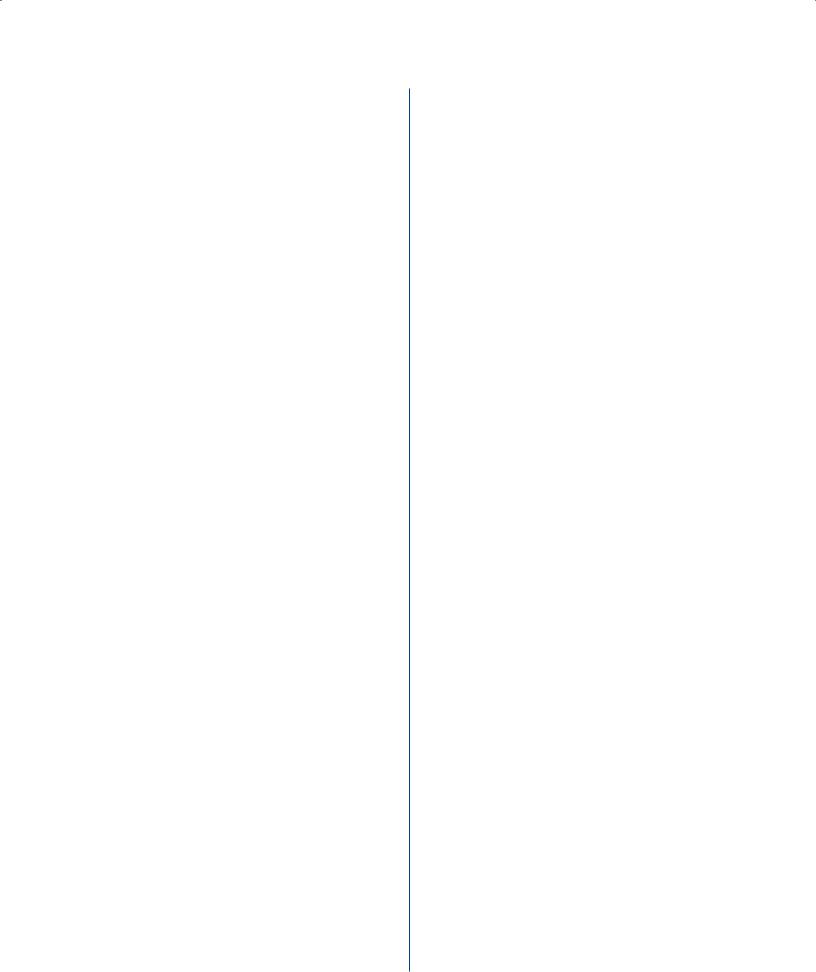
Using both statements, the ratio of the number of single scoops served to the number of double scoops served can be determined (1) and used with the total number of scoops served (2) to determine the total number of guests who were served a double scoop.
The correct answer is C;
both statements together are sufficient.
62.For a convention, a hotel charges a daily room rate of $120 for 1 person and x dollars for each additional person. What is the charge for each additional person?
(1)The daily cost per person for 4 people sharing the cost of a room equally is $45.
(2)The daily cost per person for 2 people sharing the cost of a room equally is $25 more than the corresponding cost for 4 people.
Algebra First-degree equations
If the daily room rate for a hotel is $120 for
1 person plus x dollars for each additional person, then the daily cost can be expressed as 120 + nx, where n is the number of additional people staying in the room. Determine the value for x.
(1)For 4 people sharing the cost of a room equally, each person’s share is $45. Therefore, the cost of the room, in dollars, is 120 + 3x =
45(4) = 180. This equation can be solved for a unique value of x; SUFFICIENT.
(2)Since the cost per person for 2 people is $25 more than the cost per person for 4 people,
then |
120 + x |
= |
120 + 3x |
+ 25. This |
|
2 |
|
4 |
|
equation can be solved for a unique value of x; SUFFICIENT.
The correct answer is D;
each statement alone is su cient.
63.Stores L and M each sell a certain product at a different regular price. If both stores discount their regular price of the product, is the discount price at Store M less than the discount price at Store L ?
(1)At Store L the discount price is 10 percent less than the regular price; at Store M the discount price is 15 percent less than the regular price.
6.5Data Sufficiency Answer Explanations
(2)At Store L the discount price is $5 less than the regular store price; at Store M the discount price is $6 less than the regular price.
Arithmetic Percents
Let Lr and Ld be the regular and discounted prices, respectively, at Store L, and let Mr and Md be the regular and discounted prices, respectively, at Store M. Determine if Md < Ld.
(1)Knowing that Ld = (1 – 0.10)Lr = 0.90Lr and that Md = (1 – 0.15)Mr = 0.85Mr gives no information for comparing Md and Ld ; NOT su cient.
(2)Knowing that Ld = Lr – 5 and that Md = Mr – 6 gives no information for
comparing Md and Ld ; NOT su cient.
Taking (1) and (2) together gives 0.90Lr = Lr – 5 and 0.85Mr = Mr – 6, from which it follows that
0.10Lr = 5 or Lr = 50 and 0.15Mr = 6 or Mr = 40. Then Ld = 50 – 5 = 45 and Md = 40 – 6 = 34.
Therefore, Md < Ld.
The correct answer is C;
both statements together are su cient.
64.If d denotes a decimal, is d ≥ 0.5 ?
(1)When d is rounded to the nearest tenth, the result is 0.5.
(2)When d is rounded to the nearest integer, the result is 1.
Arithmetic Rounding; Estimating
(1)In this case, for example, the value of d could range from the decimal 0.45 to 0.54. Some of these, such as 0.51 or 0.52, are greater than or equal to 0.5, and others, such as 0.47 or 0.48, are less than 0.5; NOT sufficient.
(2)When the result of rounding d to the nearest integer is 1, d could range in value from the decimal 0.50 to 1.49, which are greater than or equal to 0.5; SUFFICIENT.
The correct answer is B; statement 2 alone is sufficient.
309
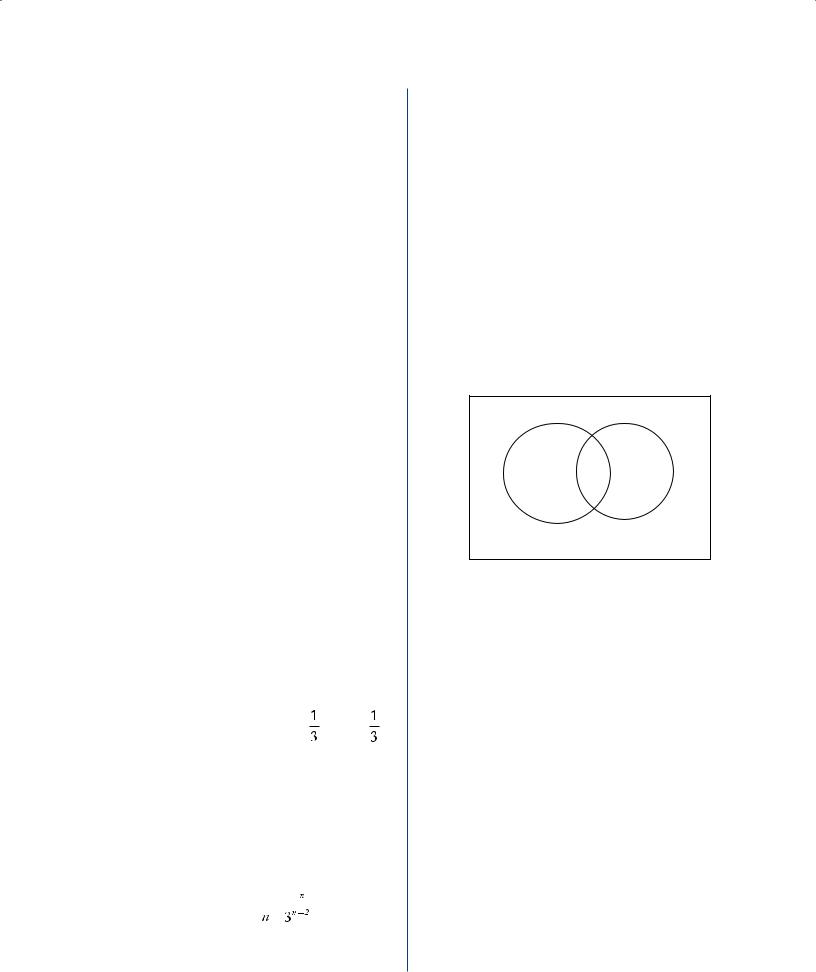
The Official Guide for GMAT® Review 12th Edition
65.How many integers are there between, but not including, integers r and s ?
(1)s – r = 10
(2)There are 9 integers between, but not including, r + 1 and s + 1.
Arithmetic Properties of numbers
(1)Although the di erence between s and r is
10, there are not 10 integers between them.
For example, if s is 24 and r is 14, their di erence is 10, but there are only 9 integers between them: 15, 16, 17, 18, 19, 20, 21, 22, and 23. This holds true for any two integers whose di erence is 10; SUFFICIENT.
(2)Since r and s are the same distance apart as r + 1 and s + 1, there would still be 9 integers between r and s in this case, although the integers themselves would change;
SUFFICIENT.
The correct answer is D;
each statement alone is sufficient.
66.If n and t are positive integers, is n a factor of t ?
(1)n = 3n – 2
(2)t = 3n
Algebra Exponents
For positive integers n and t, determine if n is a factor of t.
(1)If n = 1, then n is a factor of t, regardless of the value of t, because 1 is a factor of every positive integer. However, n = 3n – 2 implies
that n ≠ 1, because 31 – 2 = 3–1 = and 1 ≠ .
But, n = 3n – 2 provides no information about t to determine if n is a factor of t; NOT su cient.
(2)Knowing that t = 3n provides no information about n to determine if n is a factor of t. For example, if n = 3, then t = 27 and n is a factor of t. However, if n = 2, then t = 9 and 2 is not a factor of 9; NOT su cient.
Taking (1) and (2) together,  =
=  = 3n – (n – 2) =
= 3n – (n – 2) =
32 = 9, which is an integer, so n is a factor of t;
SUFFICIENT.
The correct answer is C;
both statements together are su cient.
67.In a survey of 200 college graduates, 30 percent said they had received student loans during their college careers, and 40 percent said they had received scholarships. What percent of those surveyed said that they had received neither student loans nor scholarships during their college careers?
(1)25 percent of those surveyed said that they had received scholarships but no loans.
(2)50 percent of those surveyed who said that they had received loans also said that they had received scholarships.
Arithmetic Sets
Loans Scholarships
x |
y |
z |
w
Using the variables shown on the Venn diagram above, determine the value of w. According to the information given, 30 percent had received student loans, so x + y = 0.3(200) = 60 and
x = 60 – y. Also, 40 percent had received scholarships, so y + z = 0.4(200) = 80 and z = 80 – y. Then, since x + y + z + w = 200,
w = 200 – x – y – z = 200 – (60 – y) – y – (80 – y) =
60 + y. Thus, if the value of y can be determined, then the value of w can be determined.
(1)Since 25 percent received scholarships but no loans, z = 80 – y = 0.25(200) = 50 and y = 30; SUFFICIENT.
(2)Since 50 percent of those who had received loans had also received scholarships,
0.5(x + y) = y and so 0.5(60) = 30 = y; SUFFICIENT.
The correct answer is D;
each statement alone is su cient.
310
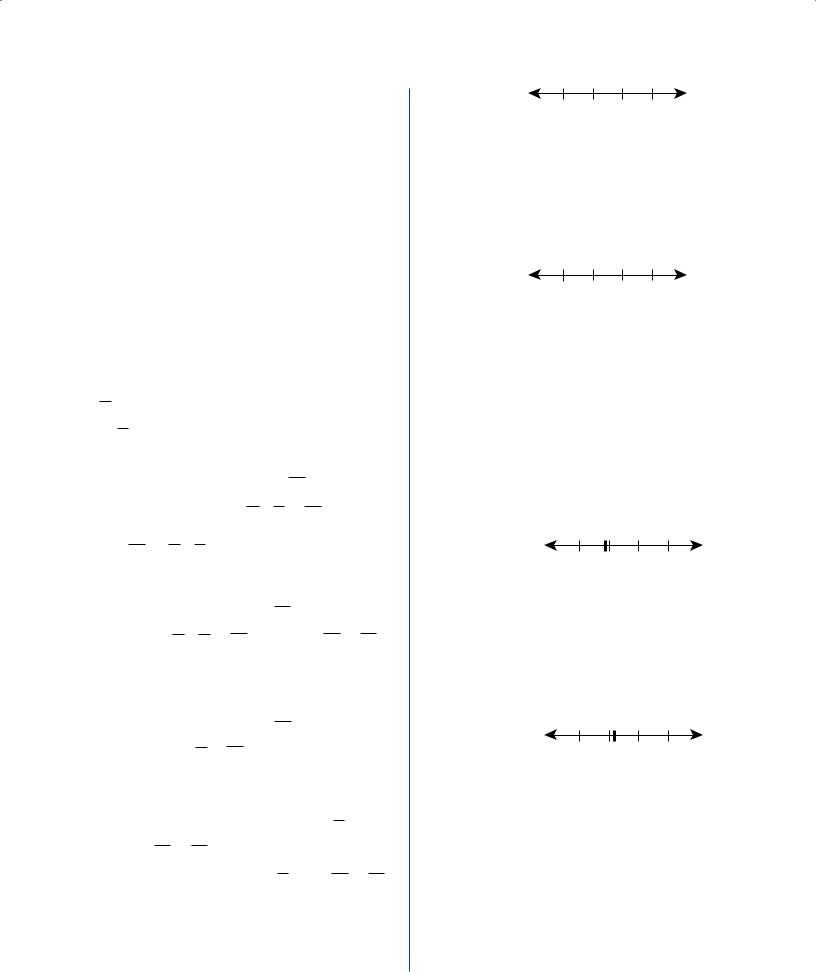
68.Three machines, K, M, and P, working simultaneously and independently at their respective constant rates, can complete a certain task in 24 minutes. How long does it take Machine K, working alone at its constant rate, to complete the task?
(1)Machines M and P, working simultaneously and independently at their respective constant rates, can complete the task in 36 minutes.
(2)Machines K and P, working simultaneously and independently at their respective constant rates, can complete the task in 48 minutes.
Algebra Applied problems |
|
|
|
|
|
|
|
|
|
|
|
|
|
|
|
|
|||||||||||||||||||||||||
Let k, m, and p be the numbers of minutes |
|
|
|
|
|
|
|||||||||||||||||||||||||||||||||||
machines K, M, and P take, respectively, to |
1 |
|
|
|
|||||||||||||||||||||||||||||||||||||
complete the task. Then, Machine K can do |
|
|
|
||||||||||||||||||||||||||||||||||||||
of the task in 1 minute, Machine M can do |
k |
|
|
||||||||||||||||||||||||||||||||||||||
|
1 |
|
|
of the task in 1 minute, and Machine P can |
|
|
|||||||||||||||||||||||||||||||||||
m |
|
|
|||||||||||||||||||||||||||||||||||||||
|
|
1 |
|
|
|
|
|
|
|
|
|
|
|
|
|
|
|
|
|
|
|
|
|
|
|
|
|
|
|
|
|
|
|
|
|
|
|
|
|
||
do |
|
of the task in 1 minute. If all three |
|
|
|
|
|
|
|||||||||||||||||||||||||||||||||
|
|
|
|
p |
|
|
|
|
|
|
|
|
|
|
|
|
|
|
|
|
|
|
|
|
|
|
|
|
|
|
|
|
|
|
|
|
|
|
|
||
machines working together can do the task |
|
|
|
|
|
||||||||||||||||||||||||||||||||||||
in 24 minutes, then they can do |
|
1 |
of the |
|
|
|
|
|
|
||||||||||||||||||||||||||||||||
24 |
|
|
|
|
|
|
|||||||||||||||||||||||||||||||||||
task in 1 minute. So, 1 + |
1 |
+ |
1 |
|
1 |
|
|
|
|
|
|
|
|
|
|
||||||||||||||||||||||||||
|
|
= |
|
and |
|
|
|
|
|
||||||||||||||||||||||||||||||||
|
p |
|
24 |
|
|
|
|
|
|||||||||||||||||||||||||||||||||
1 |
|
|
|
1 |
|
|
1 |
|
|
|
1 |
|
|
k |
m |
|
|
|
|
|
|
|
|
|
|
|
|
||||||||||||||
|
|
|
|
|
|
|
|
|
|
|
|
|
|
|
|
|
|
|
|
|
|
|
|
|
|
|
|
|
|
||||||||||||
|
= |
− |
|
+ |
|
. Determine k. |
|
|
|
|
|
|
|
|
|
|
|
||||||||||||||||||||||||
|
k |
24 |
|
m |
|
|
|
p |
|
|
|
|
|
|
|
|
|
|
|
|
|
|
|
|
|
|
|
|
|
|
|||||||||||
(1) Since M and P together can do the task in |
|||||||||||||||||||||||||||||||||||||||||
|
|
|
|
|
36 minutes, they can do |
1 |
|
in 1 minute, |
|
|
|||||||||||||||||||||||||||||||
|
|
|
|
|
36 |
|
|
||||||||||||||||||||||||||||||||||
|
|
|
|
|
|
|
|
|
|
1 |
|
|
|
|
1 |
|
|
|
1 |
|
|
|
|
|
|
1 |
|
|
|
1 |
|
|
|||||||||
|
|
|
|
|
and so |
|
+ |
|
|
= |
|
|
. Then 1 = |
|
|
– |
|
|
, |
||||||||||||||||||||||
|
|
|
|
|
|
|
|
|
24 |
36 |
|||||||||||||||||||||||||||||||
|
|
|
|
|
|
|
|
|
|
m |
|
|
|
|
p |
36 |
|
|
|
|
|
|
k |
|
|
|
|
||||||||||||||
|
|
|
|
|
which can be solved for a unique value of k; |
||||||||||||||||||||||||||||||||||||
|
|
|
|
|
SUFFICIENT. |
|
|
|
|
|
|
|
|
|
|
|
|
|
|
|
|
|
|
||||||||||||||||||
(2) Since K and P together can do the task in |
|
|
|||||||||||||||||||||||||||||||||||||||
|
|
|
|
|
48 minutes, they can do |
1 |
|
in 1 minute, |
|
|
|||||||||||||||||||||||||||||||
|
|
|
|
|
48 |
|
|
||||||||||||||||||||||||||||||||||
|
|
|
|
|
and so 1 |
|
|
|
1 |
|
|
|
= |
1 |
|
|
|
|
|
|
|
|
|
|
|
|
|
|
|
||||||||||||
|
|
|
|
|
+ |
|
|
|
|
. From this information, |
|||||||||||||||||||||||||||||||
|
|
|
|
|
|
|
|
|
|
||||||||||||||||||||||||||||||||
|
|
|
|
|
|
|
|
|
|
k |
|
|
|
|
p |
48 |
|
|
|
|
|
|
|
|
|
|
|
|
|
|
1 |
|
|
|
|||||||
|
|
|
|
|
there is no way to uniquely determine |
k |
|
|
|||||||||||||||||||||||||||||||||
|
|
|
|
|
and therefore no way to uniquely determine |
||||||||||||||||||||||||||||||||||||
|
|
|
|
|
k. For example, if p = 96, then |
1 + |
1 |
= |
|
|
|
|
|||||||||||||||||||||||||||||
|
|
|
1 + |
1 |
|
|
|
|
|
1 |
|
|
|
|
|
|
|
|
|
|
|
|
|
|
k |
|
|
p |
|
|
|
|
|
|
|||||||
|
|
|
|
= |
|
|
|
|
and k = 96. On the other |
|
|
||||||||||||||||||||||||||||||
|
|
|
96 |
48 |
|
|
|
|
|||||||||||||||||||||||||||||||||
|
|
|
|
|
k |
|
|
|
|
|
|
|
|
|
|
|
|
|
|
|
|
|
|
|
|
|
|
|
|
|
|
|
|||||||||
|
|
|
|
|
hand, if p = 60, then 1 + |
1 |
|
= 1 + |
1 |
|
= |
|
1 |
||||||||||||||||||||||||||||
|
|
|
|
|
|
|
|
|
|
|
|
|
|
|
|
|
|
|
|
|
|
|
|
k |
|
p |
|
|
k |
60 |
|
48 |
|||||||||
and k = 240. So, 96 and 240 are both possible values for k; NOT su cient.
The correct answer is A; statement 1 alone is su cient.
6.5 Data Sufficiency Answer Explanations
q r s t
69.Of the four numbers represented on the number line above, is r closest to zero?
(1)q = –s
(2)–t < q
Algebra Order
q r s t
Referring to the figure above, in which it may be assumed that q, r, s, and t are di erent numbers, determine if r is closest to 0.
(1)Since q = –s, one of q and s is positive and the other is negative. Since s is to the right of q, then s is positive and q is negative.
Also, 0 is halfway between q and s, so q and s are the same distance from 0. If r = 0, then, of q, r, s, and t, r is closest to 0 because it IS 0. If r ≠ 0, then either (i) q < 0 < r < s < t or (ii) q < r < 0 < s < t.
0
q r s t
(i) If q < 0 < r < s < t , as shown above, r is closer to 0 than s is because r is between 0 and s, and r is clearly closer to 0 than t is because t is farther away from 0 than s is.
Also, since q and s are the same distance from 0 and r is closer to 0 than s is, then r is closer to 0 than q is. Therefore, r is closest to 0.
0
q r s t
(ii) If q < r < 0 < s < t, as shown above, r is closer to 0 than q is because r is between 0 and q. Also, r is closer to 0 than s is because r is closer to 0 than q is and q and s are the same distance from 0. Moreover, r is closer to 0 than t is because t is farther away from
0 than s is. Therefore, r is closest to 0.
In each case, r is closest to 0; SUFFICIENT.
(2)If –t < q, then –t is to the left of q. If t = 5, s = 4, r = 3, and q = –2, then –5 < –2, so (2) is satisfied. In this case, q is closest to 0. On
311
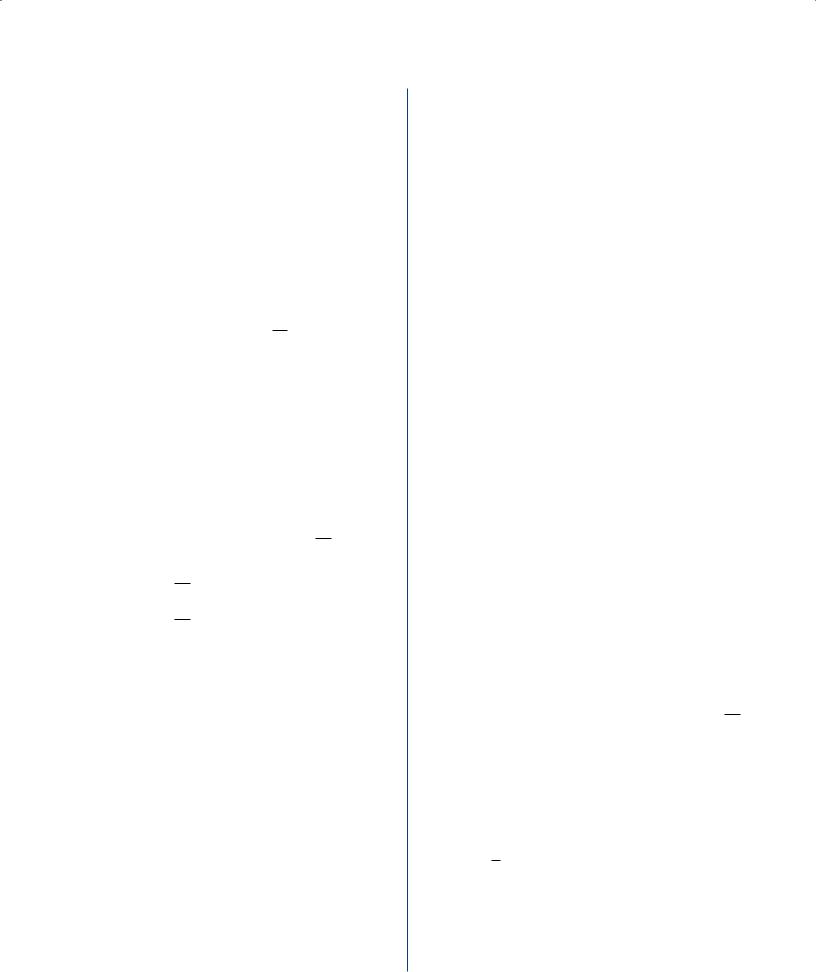
The Official Guide for GMAT® Review 12th Edition
the other hand, if t = 5, s = 4, r = –1, and q = –2, then –5 < –2, so (2) is satisfied, but r is closest to 0; NOT su cient.
The correct answer is A; statement 1 alone is su cient.
70.Mary persuaded n friends to donate $500 each to her election campaign, and then each of these n friends persuaded n more people to donate $500 each to Mary’s campaign. If no one donated more than once and if there were no other donations, what was the value of n ?
1
(1) The fi rst n people donated 16 amount donated.
(2) The total amount donated was $120,000.
Algebra Simultaneous equations
If n is the number of friends who each contributed $500 to Mary’s campaign and each persuaded n more people to contribute $500 each to the campaign, then the amount contributed to the campaign was $500(n2 + n). Assuming n > 0, determine the value of n.
1
(1)If the first n people contributed 16 of the total amount, then
500n = 161 (500)(n2 + n)
1
500n = 16 (500)(n)(n + 1)
16 = n + 1
15 = n; SUFFICIENT.
(2)If the total amount contributed was $120,000, then
500(n2 + n) = 120,000
n2 + n = 240
n2 + n – 240 = 0
(n + 16)(n – 15) = 0
n = 15; SUFFICIENT.
Note that n2 + n = 240 can be solved by inspection since n2 + n = n(n + 1) and the only consecutive positive integers whose product is 240 are 15 and 16, so n = 15.
Although it is not necessary to actually solve the quadratic equations in (1) and (2), it is necessary to analyze the nature of the solutions to make sure that there aren’t two possible values for n.
The correct answer is D;
each statement alone is su cient.
71.Carlotta can drive from her home to her office by one of two possible routes. If she must also return by one of these routes, what is the distance of the shorter route?
(1)When she drives from her home to her office by the shorter route and returns by the longer route, she drives a total of 42 kilometers.
(2)When she drives both ways, from her home to her office and back, by the longer route, she drives a total of 46 kilometers.
Arithmetic Arithmetic operations
(1)Only the sum of the distances of the two routes (42 kilometers) is given and there are infinitely many pairs of numbers with a given sum; NOT sufficient.
(2)The distance of the longer route can be
expressed as 46 kilometers, but there is no
2
information about the relationship between the two routes; NOT sufficient.
Using both statements together, the distance of the shorter route can be determined by subtracting the known distance of the longer route (2) from the known sum of the distances of the two routes (1).
The distance of the shorter route is thus 42 – 46 .
2
The correct answer is C;
both statements together are sufficient.
72.Is x > y ?
(1)x = y + 2
x
(2)2 = y – 1
Algebra Inequalities
(1)x = y + 2 so x – y = 2 and since 2 > 0, x – y > 0 and x > y; SUFFICIENT.
312

(2)The equation given is equivalent to
x = 2y – 2, which is satisfied both by x = 0 and y = 1 (x > y is false) and by x = 4 and y = 3 (x > y is true); NOT su cient.
The correct answer is A; statement 1 alone is su cient.
73.If m is an integer, is m odd?
(1)m2 is not an even integer.
(2)m – 3 is an even integer.
Algebra Properties of numbers
(1)Since m could be either the odd integer 3 or the even integer 10 and still satisfy this condition, there is no information to show definitively whether m is odd or even; NOT su cient.
(2)If m – 3 is an even integer, then m – 3 = 2k for some integer k and m = 2k + 3 =
2(k + 1) + 1, which is odd; SUFFICIENT.
The correct answer is B; statement 2 alone is su cient.
B
A x° |
|
|
|
C |
|
|
|
||
D |
||||
74.What is the area of triangular region ABC above?
(1)The product of BD and AC is 20.
(2)x = 45
Geometry Triangles; Area
The area of ABC = BD × AC . 2
(1)The product of BD and AC is given as 20, so the area of ABC is 20 or 10;
2
SUFFICIENT.
(2)With the measurement of x being 45, it is concluded that ABD is a 45-45-90 right triangle, where the length of side BD is
6.5 Data Sufficiency Answer Explanations
equal to the length of side AD. However, with no lengths of any side known, there is not enough information to calculate the area; NOT sufficient.
The correct answer is A; statement 1 alone is sufficient.
75.In the xy-plane, the line with equation ax + by + c = 0,
2
where abc ≠ 0, has slope 3. What is the value of b ?
(1)a = 4
(2)c = –6
Arithmetic Coordinate geometry
If ax + by + c = 0, then by = –ax – c and
y = |
−a |
x – |
|
c |
. The slope of the line with equation |
|||||||||||
|
|
b |
|
b |
|
|
−a |
|
|
|
||||||
ax + by + c = 0 is |
|
|
. Since the slope of this line |
|||||||||||||
b |
||||||||||||||||
is |
2 |
, then |
−a |
= |
2 |
or b = |
−3a |
. Determine the |
||||||||
|
|
b |
|
2 |
|
|||||||||||
3 |
|
|
|
3 |
|
|
|
|
|
|||||||
value of b. |
|
|
|
|
|
|
|
|
−3(4) |
|
||||||
(1) |
If a = 4, then b = |
= –6; |
||||||||||||||
|
2 |
|
||||||||||||||
|
|
SUFFICIENT. |
|
|
||||||||||||
|
|
|
|
|
||||||||||||
(2)If c = –6 and a = 2, then b = –3. However, if c = –6 and a = –2, then b = 3; NOT su cient.
The correct answer is A; statement 1 alone is su cient.
76.If m, p, and t are positive integers and m < p < t, is the product mpt an even integer?
(1)t – p = p – m
(2)t – m = 16
Arithmetic Properties of numbers
Given integers m, p, and t, for which m < p < t, determine if mpt is even.
(1)Given that t – p = p – m, then t + m = 2p.
This means that t + m is even, so both m and t are odd or both are even and therefore mt is either odd or even. If mt is even, then mpt is even, regardless of the value of p.
However, if mt is odd, the evenness or oddness of mpt depends on whether p is even or odd; NOT su cient.
313
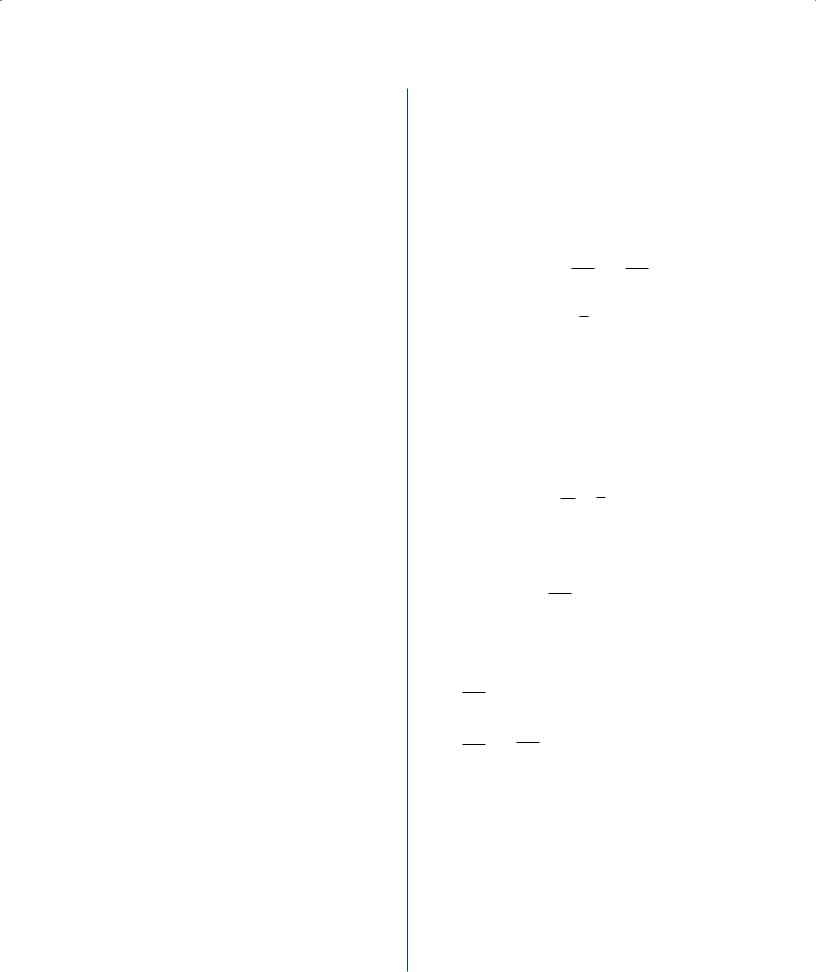
The Official Guide for GMAT® Review 12th Edition
(2)Given that t – m = 16, then m and t are either both odd or both even. This is the same situation as in (1); NOT su cient.
Taking (1) and (2) together, m and t are both even or both odd, but no information is given about the evenness or oddness of p. Therefore, mpt could be even or odd.
The correct answer is E;
both statements together are still not su cient.
77.Each week a certain salesman is paid a fi xed amount equal to $300, plus a commission equal to 5 percent of the amount of his sales that week over $1,000.
What is the total amount the salesman was paid last week?
(1)The total amount the salesman was paid last week is equal to 10 percent of the amount of his sales last week.
(2)The salesman’s sales last week totaled $5,000.
Algebra Applied problems
Let P be the salesman’s pay for last week and let S be the amount of his sales last week. Then P = 300 + 0.05(S – 1,000). Determine the value of P.
(1)Given P = 0.10S, then 0.10S = 300 +
0.05(S – 1,000). This equation can be solved for a unique value of S, from which the value of P can be determined; SUFFICIENT.
(2)Given S = 5,000, then P = 300 + 0.05(5,000 – 1,000); SUFFICIENT.
The correct answer is D;
each statement alone is su cient.
78.A total of $60,000 was invested for one year. Part of this amount earned simple annual interest at the rate of x percent per year, and the rest earned simple annual interest at the rate of y percent per year. If the total interest earned by the $60,000 for that year was $4,080, what is the value of x ?
3y
(1)x = 4
(2)The ratio of the amount that earned interest at the rate of x percent per year to the amount that earned interest at the rate of y percent per year was 3 to 2.
Algebra Applied problems
Let X be the amount invested at x percent and let
Y be the amount invested at y percent, where
X + Y = 60,000. If x X + y Y = 4,080,
100 100 determine the value of x.
(1)Given that x = 34 y, then y = 43 x. Since
X + Y = 60,000, then Y = 60,000 – X. By
|
|
substitution, |
|
|
x |
X + |
|
|
y |
|||||||||||||
|
|
100 |
|
100 |
Y = 4,080 |
|||||||||||||||||
|
|
|
|
|
|
|
|
x |
|
|
|
|
|
4 x |
|
|
|
|
|
|
||
|
|
becomes |
|
|
X + |
3 |
|
|
(60,000 – X) = |
|||||||||||||
|
|
|
|
|
|
|
100 |
|
|
|||||||||||||
|
|
|
100 |
|
||||||||||||||||||
|
|
4,080. However, because the value of X is |
||||||||||||||||||||
|
|
unknown, it is impossible to determine a |
||||||||||||||||||||
|
|
unique value for x; NOT su cient. |
||||||||||||||||||||
(2) |
Given that |
X |
= |
3 |
, then Y = |
2 |
X and |
|||||||||||||||
2 |
|
|||||||||||||||||||||
|
|
Y = |
2 |
|
|
|
|
Y |
|
3 |
|
|||||||||||
|
|
3 |
(60,000 – Y), from which the values |
|||||||||||||||||||
|
|
of Y and, in turn, X can be determined. |
||||||||||||||||||||
|
|
However, since the value of y in the |
||||||||||||||||||||
|
|
equation |
|
x |
|
X + |
|
|
y |
|
|
Y = 4,080 is still |
||||||||||
|
|
100 |
|
100 |
|
|
||||||||||||||||
|
|
unknown, it is impossible to determine a |
||||||||||||||||||||
|
|
unique value for x; NOT su cient. |
||||||||||||||||||||
Taking (1) and (2) together, |
|
|
|
|
|
|
||||||||||||||||
|
x |
X + |
|
|
y |
|
Y = 4,080 from the stem becomes |
|||||||||||||||
100 |
100 |
|
||||||||||||||||||||
|
|
|
|
|
|
|
|
|
|
|
|
|
|
|
|
|
|
|||||
|
|
|
|
4 x |
|
|
|
|
|
|
|
|
|
|
|
|
|
|
|
|
||
|
x |
X + |
|
3 |
|
Y = 4,080, using the information |
||||||||||||||||
100 |
|
|||||||||||||||||||||
|
100 |
|
|
|
|
|
|
|
|
|
|
|
|
|
|
|
|
|
||||
from (1). Then, using the values of X and Y obtained from the information in (2) leaves an equation with x as the only unknown. This equation can be solved for a unique value of x;
SUFFICIENT.
The correct answer is C;
both statements together are su cient.
314
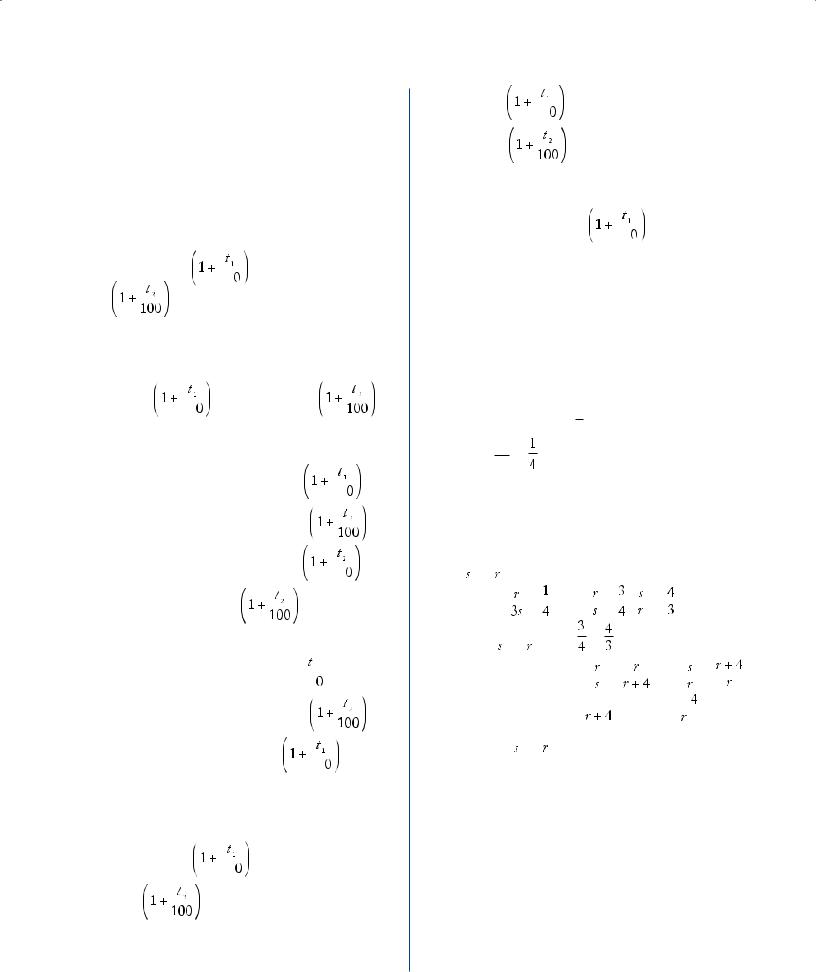
79.Leo can buy a certain computer for p1 dollars in State A, where the sales tax is t1 percent, or he can buy the same computer for p2 dollars in State B, where the sales tax is t2 percent. Is the total cost of the computer greater in State A than in State B ?
(1)t1 > t2
(2)p1t1 > p2t2
Algebra Applied problems
Determine if p1 |
|
is greater than |
||
|
||||
p2 |
|
. |
|
|
|
|
|
||
(1)Even if t1 > t2, no information is given about the size of p1 or p2, and it is impossible to tell
if p1 |
|
is greater than p2 |
|
. |
|
|
For example, if p1 = 1,000 and p2 = 1,200
with t1 = 5 and t2 = 4, then p1 |
|
|
|
= |
|||||
|
|
|
|||||||
1,000(1 + 0.05) |
= 1,050 and p2 |
|
|
|
= |
||||
|
|
|
|||||||
1,200(1 + 0.04) |
= 1,248, so p1 |
|
|
|
is |
||||
|
|
||||||||
not greater than p2 |
|
. On the |
|
|
|||||
|
|
|
|||||||
other hand, if p1 = 1,000 and p2 = 900 with t1 = 5 and t2 = 4, then p1 



 =
=
1,000(1 + 0.05) = 1,050 and p2 |
|
= |
||
|
||||
900(1 + 0.04) = 936, so p1 |
|
|
is |
|
|
||||
greater than p2; NOT su cient.
(2)Even if p1t1 > p2t2, no information is given about the size of p1 or p2 and it is impossible
to tell if p1 |
|
|
is greater than |
|
|
|
|||
p2 |
|
. For example, if p1 = 1,000 |
||
|
||||
and p2 = 1,200 with t1 = 5 and t2 = 4, then
(1,000)(5) > (1,200)(4), but as shown above,
|
|
6.5 Data Sufficiency Answer Explanations |
||
p1 |
|
|
|
is not greater than |
|
|
|||
p2 |
|
|
|
. On the other hand, if |
|
|
|
||
p1 = 1,000 and p2 = 900 with t1 = 5 and t2 = 4, then (1,000)(5) > (900)(4), but as
shown above, p1 |
|
is greater than p2; |
|
NOT su cient.
Taking (1) and (2) together is of no more help than either (1) or (2) taken separately because the same examples used to show that (1) is not su cient also show that (2) is not su cient.
The correct answer is E;
both statements together are still not su cient.
80.If r > 0 and s > 0, is sr < sr ?
(1)r = 3s
(2)s = r + 4
Algebra Ratios
Given nonnegative numbers r and s, determine if  <
<  .
.
(1) If |
|
= |
|
, then |
|
= |
|
, |
|
= |
|
, and so |
|
|
|
|
|
|
 <
<  , since < ; SUFFICIENT.
, since < ; SUFFICIENT.
(2) If s = r + 4, then |
|
= |
|
and |
|
= |
|
. |
|
|
|
|
|||||
|
|
|
Since r + 4 > r,  < 1 and
< 1 and  > 1, so
> 1, so  <
<  ; SUFFICIENT.
; SUFFICIENT.
The correct answer is D;
each statement alone is su cient.
k, n, 12, 6, 17
81.What is the value of n in the list above?
(1)k < n
(2)The median of the numbers in the list is 10.
315

The Official Guide for GMAT® Review 12th Edition
Arithmetic Statistics
Given the list k, n, 12, 6, 17, determine the value of n.
(1)Although k < n, no information is given about the value of k or n; NOT su cient.
(2)Since the median of the numbers in the list is 10 and there are 5 numbers in the list, 10 is one of those 5 numbers. Therefore, n = 10 or k = 10. If n = 10, then the value of n has been determined. However, if k = 10, then n can be any number that is 10 or less, so the value of n cannot be determined; NOT su cient.
Taking (1) and (2) together, if k < n and the median of the list is 10, then 12 and 17 are to the right of the median and the list in ascending order is either 6, k, n, 12, 17 or k, 6, n, 12, 17. In either case, n is the middle number, and since the median is 10, n = 10; SUFFICIENT.
The correct answer is C;
both statements together are su cient.
82.If positive integer x is a multiple of 6 and positive integer y is a multiple of 14, is xy a multiple of 105 ?
(1)x is a multiple of 9.
(2)y is a multiple of 25.
Arithmetic Properties of numbers
Given that x is a multiple of 6, x has at least 1 factor of 2 and at least 1 factor of 3. Given that y is a multiple of 14, y has at least 1 factor of 2 and at least 1 factor of 7. So, xy has at least 1 factor of 2, at least 1 factor of 3, and at least 1 factor of
7 and can be expressed as xy = (2)(3)(7)r = 42r, where r is a positive integer. Determine if xy is a multiple of 105 = (3)(5)(7).
(1)If x = (2)(3)(3), then x is a multiple of both 6 and 9. If y = (2)(7) then y is a multiple of 14.
In this case, xy = (2)(3)(3)(2)(7) = (22)(32)(7) and is not a multiple of 105. However, if x =
(2)(3)(3)(5), then x is a multiple of both 6 and 9. If y = (2)(7), then y is a multiple of 14. In this case, xy = (2)(3)(3)(5)(14) = (22)(32)(5)(7) and is a multiple of 105;
NOT su cient.
(2)If y = (2)(5)(5)(7), then y is a multiple of
14 and 25. If x is a multiple of 6,
x = (2)(3)q for some positive integer q. Then xy = (2)(2)(3)(5)(5)(7)q and xy is a multiple of 105; SUFFICIENT.
The correct answer is B; statement 2 alone is su cient.
83.What is the value of b + c ?
(1)ab + cd + ac + bd = 6
(2)a + d = 4
Algebra Firstand second-degree equations
(1)The equation ab + cd + ac + bd = 6 can be simplified to isolate b + c by regrouping and then factoring as follows:
(ab + bd ) + (ac + cd ) = 6
b(a + d ) + c(a + d ) = 6
(a + d) (b + c) = 6
T e valueh of b + c, however, cannot be determined unless the value of a + d is known; NOT sufficient.
(2)This provides no information about b and c ;
NOT sufficient.
Since (2) provides the missing information about the needed value of a + d in (1), the value of b + c can be found when both (1) and (2) are used to complete the equation.
The correct answer is C;
both statements together are sufficient.
84.What is the average (arithmetic mean) of j and k ?
(1)The average (arithmetic mean) of j + 2 and k + 4 is 11.
(2)The average (arithmetic mean) of j, k, and 14 is 10.
Arithmetic Statistics
The average of j and k is j + k , and this value 2
can be determined if the value of j + k can be determined.
316
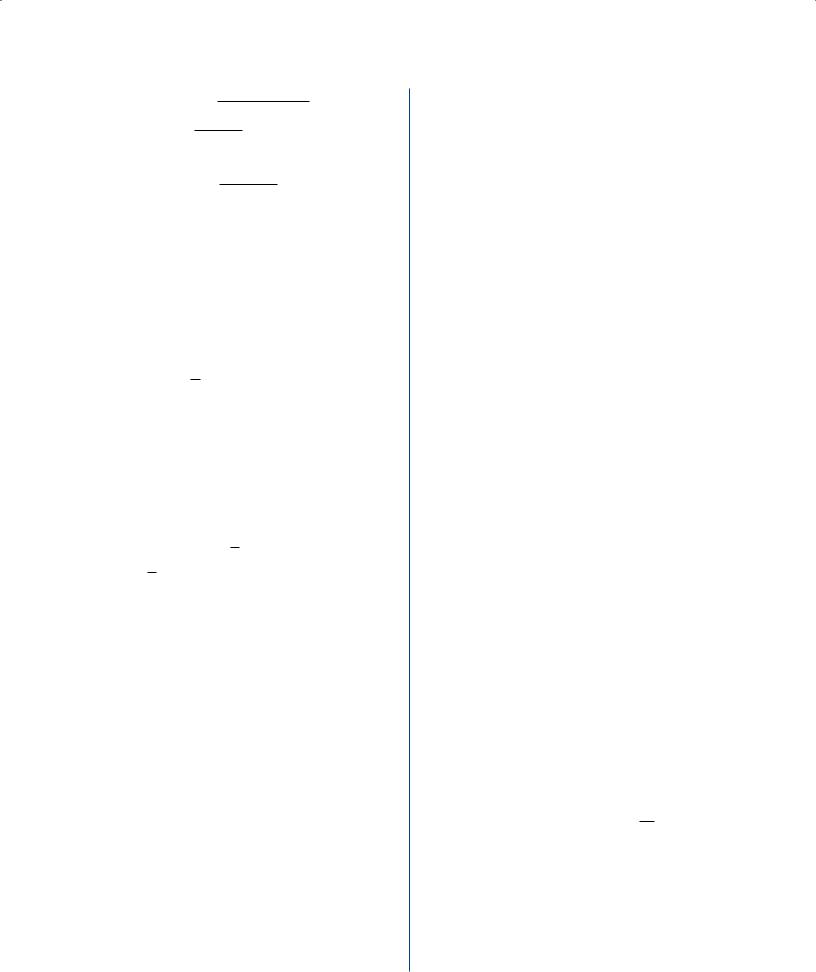
(1)It is given that ( j + 2) + (k + 4) = 11.
2
j + k + 6 = 11, j + k + 6 = 22; 2
j + k = 16; SUFFICIENT.
(2) It is given that j + k + 14 = 10 . Therefore, 3
j + k + 14 = 30, j + k = 16; SUFFICIENT.
The correct answer is D;
each statement alone is su cient.
85.Paula and Sandy were among those people who sold raffle tickets to raise money for Club X. If Paula and Sandy sold a total of 100 of the tickets, how many of the tickets did Paula sell?
(1)Sandy sold 2 as many of the raffle tickets
3 as Paula did.
(2)Sandy sold 8 percent of all the raffle tickets sold for Club X.
Algebra Simultaneous equations
If Paula sold p tickets and Sandy sold s tickets, then p + s = 100.
(1)Since Sandy sold 2 as many tickets as Paula,
2 3
s = p . The value of p can be determined
3
by solving the two equations simultaneously; SUFFICIENT.
(2)Since the total number of the raffle tickets sold is unknown, the number of tickets that
Sandy or Paula sold cannot be determined; NOT sufficient.
The correct answer is A; statement 1 alone is sufficient.
86.A number of people each wrote down one of the fi rst 30 positive integers. Were any of the integers written down by more than one of the people?
(1)The number of people who wrote down an integer was greater than 40.
(2)The number of people who wrote down an integer was less than 70.
Algebra Sets and functions
If the number of integers to be chosen from is smaller than the number of people making the
6.5 Data Sufficiency Answer Explanations
choice, then at least one of the integers has to be chosen and written down by more than one person. If the number of integers to be chosen from is the same as or greater than the number of people making the choice, it is possible that no integer will be chosen and written down more than once.
(1)Because the number of people was greater than 30, at least one integer had to be written down by more than one person; SUFFICIENT.
(2)It is not helpful just to know that the number of people was less than 70. If, for instance, the number of people was 35, then at least one of the 30 integers had to be written down by more than one person. If the number of people was 25 instead, it is possible that no two people wrote down the same integer; NOT su cient.
The correct answer is A; statement 1 alone is su cient.
87.Is the number of seconds required to travel d1 feet at r1 feet per second greater than the number of seconds required to travel d2 feet at r2 feet per second?
(1)d1 is 30 greater than d2.
(2)r1 is 30 greater than r2.
Algebra Applied problems
Determine if |
d1 |
is greater than |
d 2 |
. |
|
r2 |
|||
r1 |
(1)Although it is given that d1 = d2 + 30, without information about r1 and r2 it is
impossible to determine if |
d1 |
is greater |
||
r1 |
||||
than |
d 2 |
. For example, if d1 |
= 60, d2 = 30, |
|
r2 |
||||
r1 = 90, and r2 = 60, then d1 = d2 + 30, but
d1 |
= |
2 |
and |
d 2 |
= |
1 |
, so |
d1 |
is greater than |
|
|
|
r2 |
2 |
r1 |
||||||
r1 |
3 |
|||||||||
d 2 |
|
. On the other hand, if d1 = 90, d2 = 60, |
||||||||
r2 |
|
|||||||||
r1 = 60, and r2 = 30, then d1 = d2 + 30, but
|
d1 |
= |
3 |
|
and |
d 2 |
= 2, so |
d1 |
is not greater |
|
|
r1 |
|
2 |
|
r2 |
r1 |
||||
than |
d 2 |
|
; NOT su cient. |
|
||||||
r2 |
|
|
||||||||
317
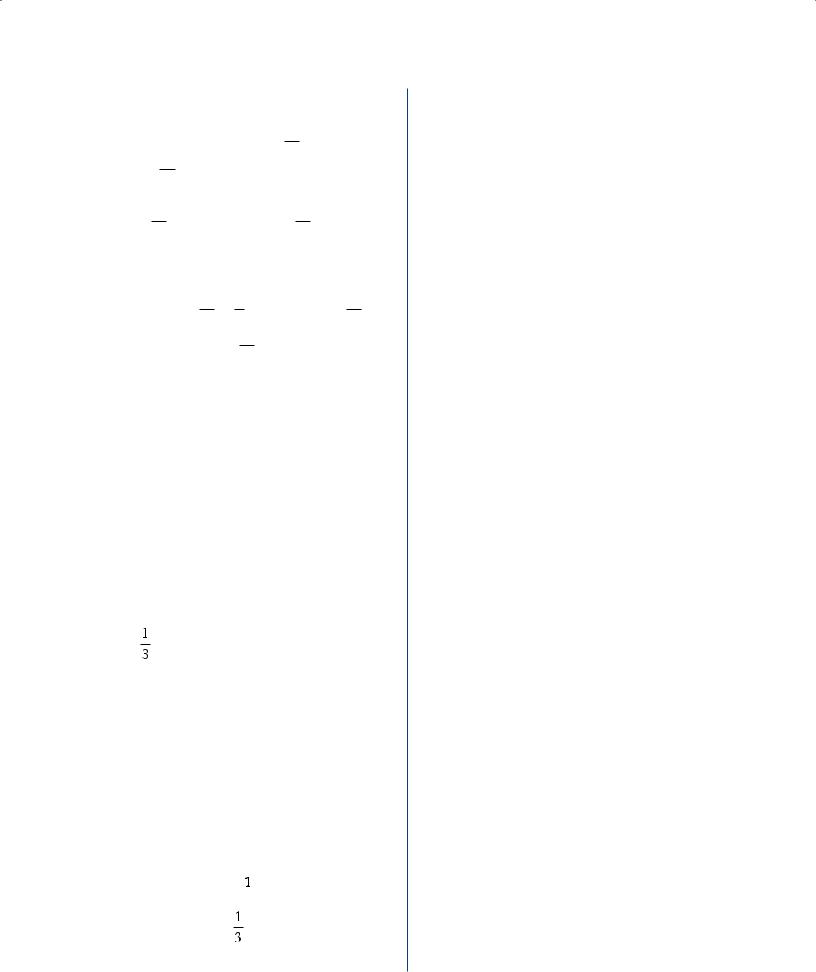
The Official Guide for GMAT® Review 12th Edition
(2)Although it is given that r1 = r2 + 30, without information about d1 and d2 it is
impossible to determine if d1 is greater d r1
than 2 . For example, if d1 = 60, d2 = r2
30, r1 = 90, and r2 = 60, then r1 = r2 + 30,
but |
d1 |
= |
2 |
and |
|
d 2 |
|
= |
1 |
, so |
d1 |
is greater |
||||||
r1 |
r2 |
|
||||||||||||||||
|
3 |
|
|
|
2 |
|
|
r1 |
||||||||||
than |
d 2 |
|
. On the other hand, if d1 = 90, |
|||||||||||||||
r2 |
|
|||||||||||||||||
|
|
|
|
|
|
|
|
|
|
|
|
|
|
|
|
|
|
|
d2 = 60, r1 = 60, and r2 = 30, then r1 = |
||||||||||||||||||
r2 + 30, but |
d1 |
= |
3 |
and |
d 2 |
= 2, so |
d1 |
|||||||||||
r1 |
|
r2 |
r1 |
|||||||||||||||
|
|
|
|
|
|
|
2 |
|
|
|
|
|
||||||
is not greater than d 2 ; NOT su cient. r2
Taking (1) and (2) together is of no more help than either of (1) or (2) taken separately because the same examples used to show that (1) is not su cient also show that (2) is not su cient.
The correct answer is E;
both statements together are still not su cient.
88.Last year, if Arturo spent a total of $12,000 on his mortgage payments, real estate taxes, and home insurance, how much did he spend on his real estate taxes?
(1)Last year, the total amount that Arturo spent on his real estate taxes and home insurance was
33 percent of the amount that he spent on his mortgage payments.
(2)Last year, the amount that Arturo spent on his real estate taxes was 20 percent of the total amount he spent on his mortgage payments and home insurance.
Arithmetic Applied problems
Let M, R, and H be the amounts that Arturo spent last year on mortgage payments, real estate taxes, and home insurance, respectively. Given that M + R + H = 12,000, determine the value of R.
(1)Given that R + H =  M and M + R + H =
M and M + R + H =
12,000, then M + M = 12,000, or
M = 9,000. However, the value of R cannot
be determined, since it is possible that
R = 2,000 (use M = 9,000 and H = 1,000) and it is possible that R = 1,000 (use
M = 9,000 and H = 2,000); NOT su cient.
(2)Given that R = 15 (M + H), or 5R = M + H and M + R + H = 12,000, which can be rewritten as (M + H) + R = 12,000, then
5R + R = 12,000, or R = 2,000;
SUFFICIENT.
The correct answer is B; statement 2 alone is su cient.
89.Is the number of members of Club X greater than the number of members of Club Y ?
(1)Of the members of Club X, 20 percent are also members of Club Y.
(2)Of the members of Club Y, 30 percent are also members of Club X.
Arithmetic Sets
Let a be the number of members in Club X that do not belong to Club Y, let b be the number of members in Club Y that do not belong to Club X, and let c be the number of members that belong to both Club X and to Club Y. Determine whether a + c > b + c, or equivalently, whether
a > b.
(1)If a = 80, b = 79, and c = 20, then 20 percent of the members of Club X are also members of Club Y (because c = 20 is 20 percent of
a + c = 100) and a > b is true. However, if a = 80, b = 80, and c = 20, then 20 percent
of the members of Club X are also members of Club Y (because c = 20 is 20 percent of
a + c = 100) and a > b is false. Therefore, it cannot be determined whether a > b;
NOT su cient.
(2)If a = 71, b = 70, and c = 30, then 30 percent of the members of Club Y are also members of Club X (because c = 30 is 30 percent of
b + c = 100) and a > b is true. However, if a = 70, b = 70, and c = 30, then 30 percent
of the members of Club Y are also members of Club X (because c = 30 is 30 percent of
b + c = 100) and a > b is false. Therefore, it cannot be determined whether a > b; NOT su cient.
318

Now assume both (1) and (2). From (1) it follows
that |
|
|
c |
|
= 0.20 = |
1 , or 5c |
= a + c, and so a = 4c. |
||||
|
a |
+ |
|
||||||||
|
|
|
c |
5 |
c |
3 |
|
||||
From (2) it follows that |
|
||||||||||
|
|
= 0.30 = |
|
, or |
|||||||
b + c |
|
10 |
|||||||||
10c = 3b + 3c, and so 7c = 3b and b = 7 c. Since |
|||||||||||
4c > |
7 |
|
|
|
|
|
3 |
|
|
||
|
(from the statements it can be deduced |
||||||||||
|
3 c |
||||||||||
that c > 0), it follows that a > b. Therefore, (1) and
(2) together are su cient.
The correct answer is C;
both statements together are su cient.
90.If k, m, and t are positive integers and k6 + m4 = 12t , do t and 12 have a common factor greater than 1 ?
(1)k is a multiple of 3.
(2)m is a multiple of 3.
Arithmetic Properties of numbers
Using a common denominator and expressing the
122k + 312m = 12t . Therefore, it follows that 2k + 3m = t. Determine
if t and 12 have a common factor greater than 1.
(1) Given that k is a multiple of 3, then 2k is a multiple of 3. Since 3m is also a multiple of 3, and a sum of two multiples of 3 is a multiple of 3, it follows that t is a multiple of 3. Therefore, t and 12 have 3 as a common factor; SUFFICIENT.
(2) If k = 3 and m = 3, then m is a |
|
|
|
||||
multiple of 3 and t = 15 (since |
|
|
|
||||
(2)(3) + |
(3)(3) = |
6 + 9 = 15 |
), so t and 12 |
||||
12 |
12 |
12 |
12 |
||||
|
|
|
|||||
have 3 as a common factor. However, if k = 2 |
|||||||
and m = 3, then m is a multiple of 3 and |
|
|
|||||
|
(2)(2) + ( |
3)(3) |
= 4 + 9 = |
13 |
), |
||
t = 13 (since |
|
12 |
12 |
12 |
|||
|
12 |
|
|
||||
so t and 12 do not have a common factor greater than 1; NOT su cient.
The correct answer is A; statement 1 alone is su cient.
6.5 Data Sufficiency Answer Explanations
A B C D
91.In the figure above, is CD > BC ?
(1)AD = 20
(2)AB = CD
Geometry Lines
(1)Information is given about the total length of the segment shown, which has no bearing on the relative sizes of CD and BC; NOT sufficient.
(2)Here, AB and CD are equal, which also has no bearing on the relative sizes of BC and CD; NOT sufficient.
It cannot be assumed that the figure is drawn to scale. Considering (1) and (2) together, if lengths
AB and CD were each a little larger than pictured, for example,
20
A |
8 |
B |
4 |
C |
8 |
D |
|
|
|
then BC < CD. But if the reverse were true, and lengths AB and CD were instead a little smaller than pictured, then BC could be greater than CD.
The correct answer is E;
both statements together are still not sufficient.
92.In a certain office, 50 percent of the employees are college graduates and 60 percent of the employees are over 40 years old. If 30 percent of those over 40 have master’s degrees, how many of the employees over 40 have master’s degrees?
(1)Exactly 100 of the employees are college graduates.
(2)Of the employees 40 years old or less, 25 percent have master’s degrees.
Arithmetic Percents
(1)It is given that 50 percent of the employees are college graduates. Here, it is now known that exactly 100 of the employees are college graduates. Thus, the total number of employees in the company is 200. It is also given that 60 percent of the
319
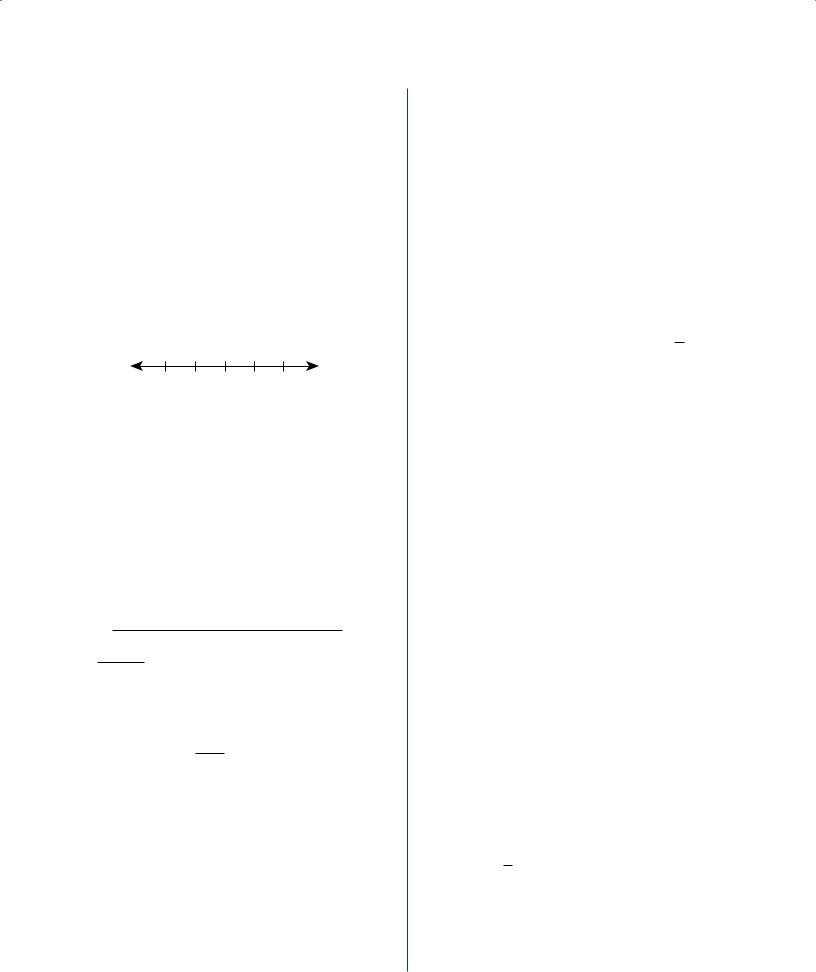
The Official Guide for GMAT® Review 12th Edition
employees are over 40 years old, which would be (0.60)(200), or 120 employees. Since it is given that 30 percent of those over 40 have master’s degrees, then (0.30)(120), or 36 employees are over 40 and have master’s degrees; SUFFICIENT.
(2)There is no information regarding how many employees fall into any of the categories, and it thus cannot be determined how many employees there are in any category; NOT sufficient.
The correct answer is A; statement 1 alone is sufficient.
p |
q |
r |
s |
t |
93.On the number line above, p, q, r, s, and t are fi ve consecutive even integers in increasing order. What is the average (arithmetic mean) of these fi ve integers?
(1)q + s = 24
(2)The average (arithmetic mean) of q and r is 11.
Arithmetic Properties of numbers
Since p, q, r, s, and t are consecutive even integers listed in numerical order, the 5 integers can also be given as p, p + 2, p + 4, p + 6, and p + 8. Determine the average of these 5 integers, which is the value of p + ( p + 2) + ( p + 4) + ( p + 6) + ( p + 8) =
5 p + 20
5
5
= p + 4.
(1)Given that q + s = 24, then (p + 2) + (p + 6) = 24. Therefore, 2p + 8 = 24, or p = 8, and hence p + 4 = 12; SUFFICIENT.
(2) Given that q + r = 11, then q + r = (2)(11) =
2
22, or (p + 2) + (p + 4) = 22. Therefore,
2p + 6 = 22, or p = 8, and hence p + 4 = 12; SUFFICIENT.
The correct answer is D;
each statement alone is su cient.
94.If line k in the xy-plane has equation y = mx + b, where m and b are constants, what is the slope of k ?
(1)k is parallel to the line with equation y = (1 – m)x + b + 1.
(2)k intersects the line with equation y = 2x + 3 at the point (2,7).
Algebra Coordinate geometry
The slope of the line given by y = mx + b is m. Determine the value of m.
(1)Given that the slope of line k is equal to the slope of line given by y = (1 – m)x + b + 1,
then m = 1 – m, 2m = 1, or m = 1; SUFFICIENT. 2
(2)Since a line passing through the point (2,7) can have any value for its slope, it is impossible to determine the slope of line k. For example, y = x + 5 intersects y = 2x + 3 at (2,7) and has slope 1, while y = 3x + 1 intersects y = 2x + 3 at (2,7) and has slope 3; NOT su cient.
The correct answer is A; statement 1 alone is su cient.
95.Is rst = 1 ?
(1)rs = 1
(2)st = 1
Arithmetic Properties of numbers
(1)This establishes that rs = 1, but since the value of t is unavailable, it is unknown if rst = 1; NOT sufficient.
(2)Similarly, this establishes the value of st but the value of r is unknown; NOT sufficient.
Both (1) and (2) taken together are still not sufficient to determine whether or not rst = 1. For example, it is true that if r = s = t = 1, then rs = 1, st = 1, and rst = 1. However, if r = t = 5,
and s = 1 , then rs = 1, st = 1, but rst = 5. 5
The correct answer is E;
both statements together are still not sufficient.
320
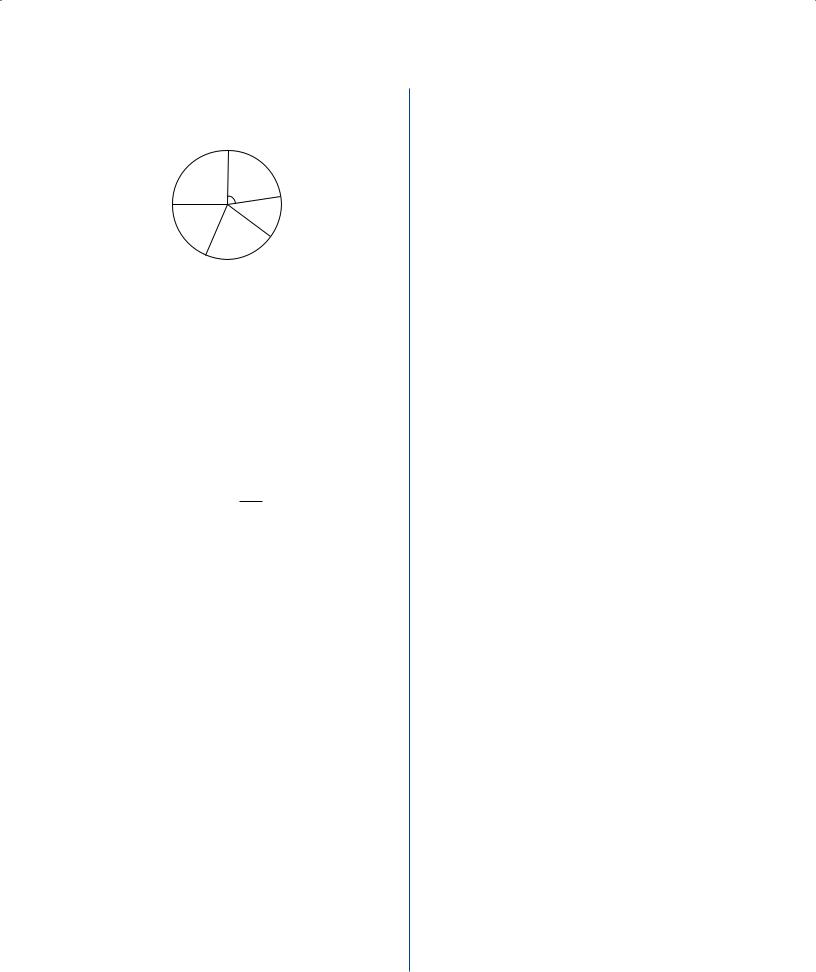
TOTAL EXPENSES FOR THE FIVE DIVISIONS OF COMPANY H
Q R x°
OS
P
T
96.The fi gure above represents a circle graph of Company H’s total expenses broken down by the expenses for each of its fi ve divisions. If O is the center of the circle and if Company H’s total expenses are $5,400,000, what are the expenses for Division R ?
(1)x = 94
(2)The total expenses for Divisions S and T are twice as much as the expenses for Division R.
Geometry Circles
In this circle graph, the expenses of Division R are equal to the value of 360x multiplied by
$5,400,000, or $15,000x. Therefore, it is necessary to know the value of x in order to determine the expenses for Division R.
(1)The value of x is given as 94, so the expenses of Division R can be determined; SUFFICIENT.
(2)This gives a comparison among the expenses of some of the divisions of Company H, but no information is given about the value of x; NOT su cient.
The correct answer is A; statement 1 alone is su cient.
97.If x is negative, is x < –3 ?
(1)x2 > 9
(2)x3 < –9
Arithmetic Properties of numbers
(1)Given that x2 > 9, it follows that x < –3 or x > 3, a result that can be obtained in a variety of ways. For example, consider the
equivalent equation (|x|)2 > 9 that reduces to |x| > 3, or consider when the two factors of
6.5 Data Sufficiency Answer Explanations
x2 – 9 are both positive and when the two factors of x2 – 9 are both negative, or consider where the graph of the parabola
y = x2 – 9 is above the x-axis, etc. Since it is also given that x is negative, it follows that x < –3; SUFFICIENT.
(2)Given that x3 < –9, if x = – 4, then x3 = –64, and so x3 < –9 and it is true that x < –3. However, if x = –3, then x3 = –27, and so
x3 < –9, but it is not true that x < –3; NOT su cient.
The correct answer is A; statement 1 alone is su cient.
98.Seven different numbers are selected from the integers 1 to 100, and each number is divided by 7. What is the sum of the remainders?
(1)The range of the seven remainders is 6.
(2)The seven numbers selected are consecutive integers.
Arithmetic Properties of numbers
(1)If the numbers are 6, 7, 14, 21, 28, 35, and
42, then the remainders when divided by 7 are 6, 0, 0, 0, 0, 0, and 0. Thus, the range of the remainders is 6 and the sum of the remainders is 6. However, if the numbers are 5, 6, 7, 14, 21, 28, and 35, then the remainders when divided by 7 are 5, 6, 0, 0, 0, 0, and 0. Thus, the range of the remainders is 6 and the sum of the remainders is 11. Therefore, it is not possible to determine the sum of the remainders given that the range of the remainders is 6; NOT su cient.
(2)When a positive integer is divided by 7, the only possible remainders are 0, 1, 2, 3, 4, 5, and 6. Also, each of these remainders will occur exactly once when the terms in a sequence of 7 consecutive integers are divided by 7. For example, if n has remainder 4 upon division by 7 (for example, n = 46), then the remainders when n, n + 1, n + 2,
n + 3, n + 4, n + 5, and n + 6 are divided by 7 will be 4, 5, 6, 0, 1, 2, and 3. Therefore, the sum of the remainders will always be
0 + 1 + 2 + 3 + 4 + 5 + 6; SUFFICIENT.
The correct answer is B; statement 2 alone is su cient.
321
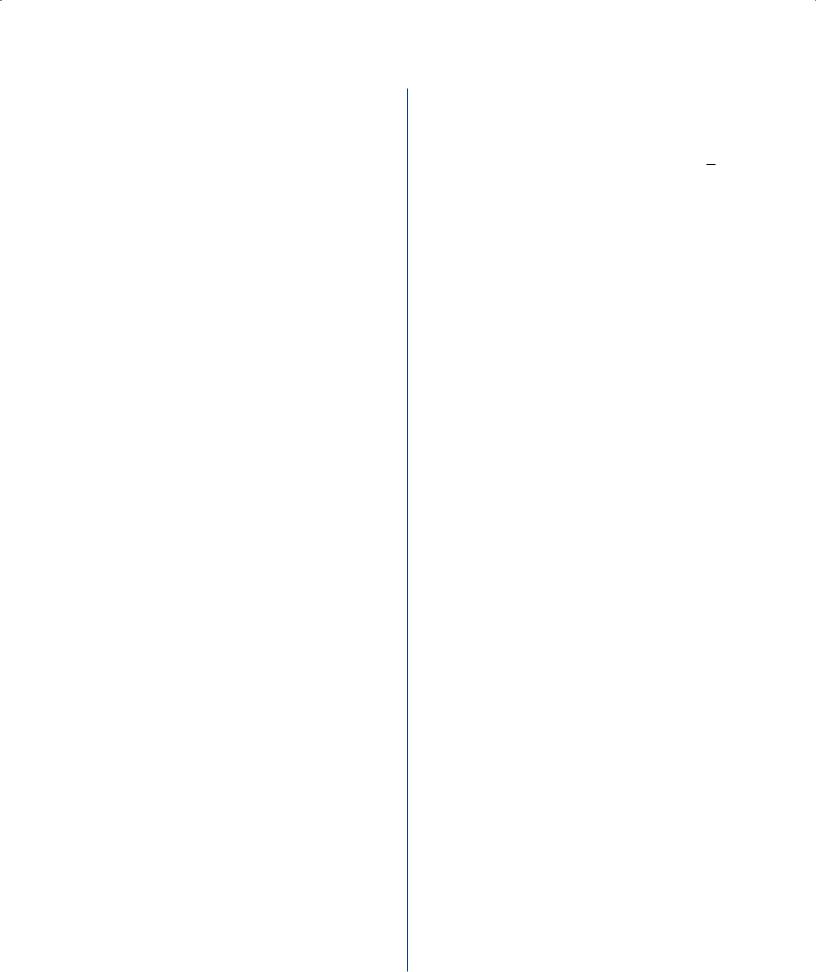
The Official Guide for GMAT® Review 12th Edition
r |
s |
t |
|
|
|
u |
v |
w |
|
|
|
x |
y |
z |
|
|
|
99.Each of the letters in the table above represents one of the numbers 1, 2, or 3, and each of these numbers occurs exactly once in each row and exactly once in each column. What is the value of r ?
(1)v + z = 6
(2)s + t + u + x = 6
Arithmetic Properties of numbers
In the following discussion, “row/column convention” means that each of the numbers 1, 2, and 3 appears exactly once in any given row and exactly once in any given column.
(1)Given that v + z = 6, then both v and z are equal to 3, since no other sum of the possible values is equal to 6. Applying the row/column convention to row 2, and then to row 3, it follows that neither u nor x can
be 3. Since neither u nor x can be 3, the row/ column convention applied to column 1 forces r to be 3; SUFFICIENT.
(2)If u = 3, then s + t + x = 3. Hence, s = t = x = 1, since the values these variables can have does not permit another possibility.
However, this assignment of values would violate the row/column convention for row 1, and thus u cannot be 3. If x = 3, then
s + t + u = 3. Hence, s = t = u = 1, since the values these variables can have does not permit another possibility. However, this assignment of values would violate the row/ column convention for row 1, and thus x cannot be 3. Since neither u nor x can be 3, the row/column convention applied to column 1 forces r to be 3; SUFFICIENT.
The correct answer is D;
each statement alone is su cient.
100.If [x] denotes the greatest integer less than or equal to x, is [x] = 0 ?
(1)5x + 1 = 3 + 2x
(2)0 < x < 1
Algebra Inequalities
It will be useful to observe that the condition
[x] = 0 is equivalent to 0 ≤ x < 1.
2
(1)The solution to 5x + 1 = 3 + 2x is x = 3, which satisfies 0 ≤ x < 1; SUFFICIENT.
(2)If 0 < x < 1, then it follows that 0 ≤ x < 1; SUFFICIENT.
The correct answer is D;
each statement alone is su cient.
101.Material A costs $3 per kilogram, and Material B costs $5 per kilogram. If 10 kilograms of Material K consists of x kilograms of Material A and y kilograms of Material B, is x > y ?
(1)y > 4
(2)The cost of the 10 kilograms of Material K is less than $40.
Algebra Inequalities
Since x + y = 10, the relation x > y is equivalent to x > 10 – x, or x > 5.
(1)The given information is consistent with x = 5.5 and y = 4.5, and the given
information is also consistent with x = y = 5. Therefore, it is possible for x > y to be true and it is possible for x > y to be false; NOT su cient.
(2)Given that 3x + 5y < 40, or
3x + 5(10 – x) < 40, then 3x – 5x < 40 – 50.
It follows that –2x < –10, or x > 5; SUFFICIENT.
The correct answer is B; statement 2 alone is su cient.
102. While on a straight road, Car X and Car Y are traveling at different constant rates. If Car X is now 1 mile ahead of Car Y, how many minutes from now will Car X be 2 miles ahead of Car Y ?
(1) |
Car X is traveling at 50 miles per hour and Car Y |
|||
|
is traveling at 40 miles per hour. |
|||
(2) |
Three minutes ago Car X was |
1 |
mile ahead of |
|
2 |
||||
|
Car Y. |
|
||
|
|
|
||
322
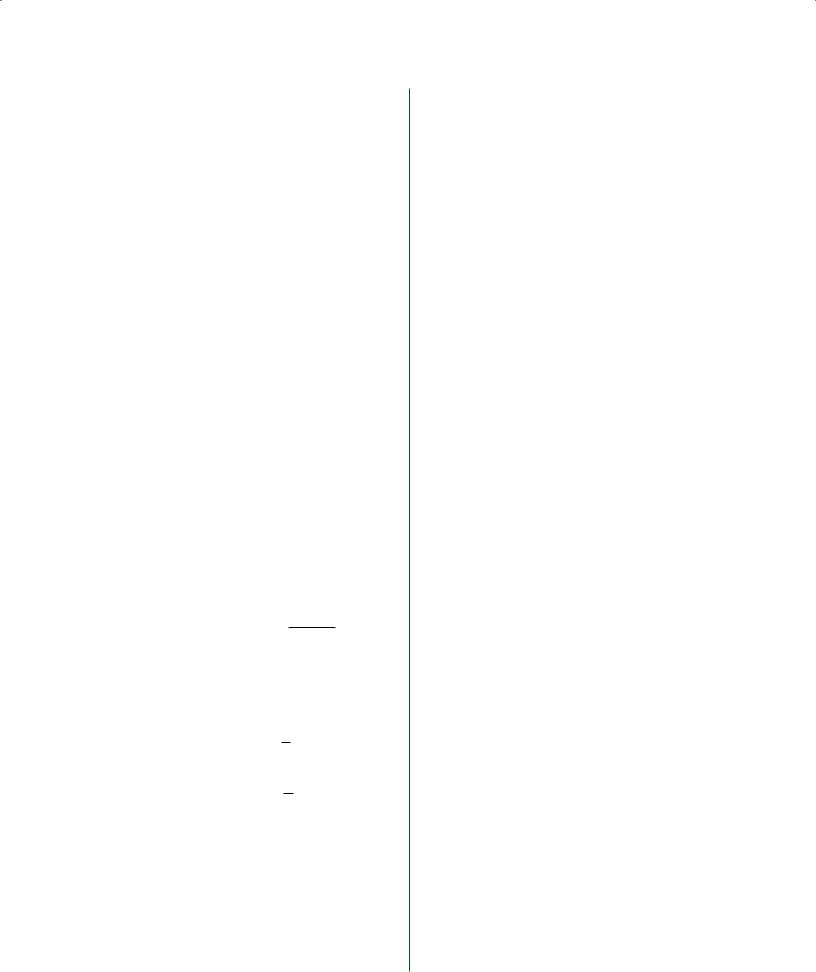
Arithmetic Rate problem
Simply stated, the question is how long will it take Car X to get one mile further ahead of Car Y than it is now.
(1)At their constant rates, Car X would increase its distance from Car Y by 10 miles every hour or, equivalently, 1 mile every
6 minutes; SUFFICIENT.
(2)This states that Car X increases its distance from Car Y by 0.5 mile every 3 minutes, or alternately 1 mile every 6 minutes;
SUFFICIENT.
The correct answer is D;
each statement alone is sufficient.
103.If a certain animated cartoon consists of a total of 17,280 frames on film, how many minutes will it take to run the cartoon?
(1)The cartoon runs without interruption at the rate of 24 frames per second.
(2)It takes 6 times as long to run the cartoon as it takes to rewind the film, and it takes a total of 14 minutes to do both.
Arithmetic Arithmetic operations
(1)Given the frames-per-second speed, it can be determined that it takes 17,280 minutes
×6024
to run the cartoon; SUFFICIENT.
(2)It is given both that it takes 14 minutes to run the cartoon and rewind the film and that, with the ratio 6:1 expressed as a fraction, the cartoon runs 6 of the total
7
time. Thus, it can be determined that
running the cartoon takes 6 of the
7
14 minutes; SUFFICIENT.
The correct answer is D;
each statement alone is sufficient.
6.5Data Sufficiency Answer Explanations
104.At what speed was a train traveling on a trip when it had completed half of the total distance of the trip?
(1)The trip was 460 miles long and took 4 hours to complete.
(2)The train traveled at an average rate of 115 miles per hour on the trip.
Arithmetic Applied problems
Determine the speed of the train when it had completed half the total distance of the trip.
(1)Given that the train traveled 460 miles in
4 hours, the train could have traveled at the constant rate of 115 miles per hour for
4 hours, and thus it could have been traveling 115 miles per hour when it had completed half the total distance of the trip.
However, the train could have traveled
150 miles per hour for the first 2 hours (a distance of 300 miles) and 80 miles per hour for the last 2 hours (a distance of
160 miles), and thus it could have been traveling 150 miles per hour when it had completed half the total distance of the trip; NOT su cient.
(2)Given that the train traveled at an average rate of 115 miles per hour, each of the possibilities given in the explanation for (1)
could occur, since 460 miles in 4 hours gives
an average speed of 4604 = 115 miles per hour; NOT su cient.
Assuming (1) and (2), each of the possibilities given in the explanation for (1) could occur. Therefore, (1) and (2) together are NOT su cient.
The correct answer is E;
both statements together are still not su cient.
105.Tom, Jane, and Sue each purchased a new house. The average (arithmetic mean) price of the three houses was $120,000. What was the median price of the three houses?
(1)The price of Tom’s house was $110,000.
(2)The price of Jane’s house was $120,000.
323
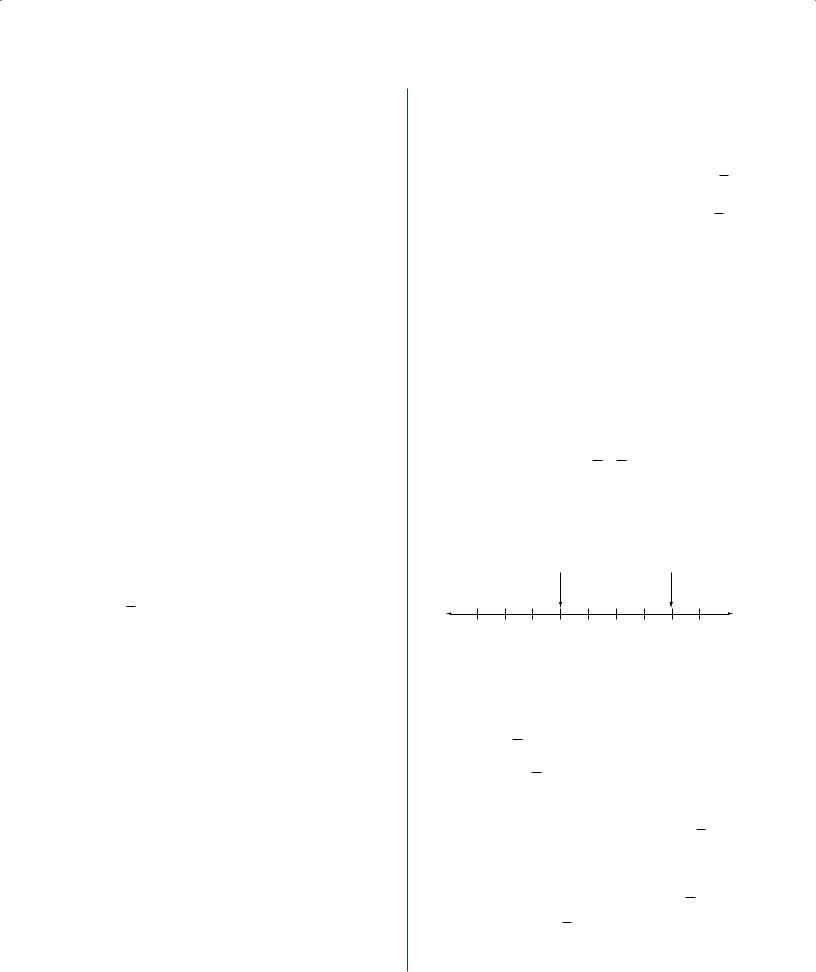
The Official Guide for GMAT® Review 12th Edition
Arithmetic Statistics
Let T, J, and S be the purchase prices for Tom’s,
Jane’s, and Sue’s new houses. Given that the average purchase price is 120,000, or
T + J + S = (3)(120,000), determine the median purchase price.
(1)Given T = 110,000, the median could be 120,000 (if J = 120,000 and S = 130,000) or 125,000 (if J = 125,000 and S = 125,000); NOT su cient.
(2)Given J = 120,000, the following two cases include every possibility consistent with T + J + S = (3)(120,000), or
T + S = (2)(120,000).
(i)T = S = 120,000
(ii)One of T or S is less than 120,000 and the other is greater than 120,000.
In each case, the median is clearly 120,000; SUFFICIENT.
The correct answer is B; statement 2 alone is su cient.
106. If x and y are integers, is xy even?
(1)x = y + 1
x
(2)y is an even integer.
Arithmetic Properties of numbers
Determine if xy is even.
(1)Since x and y are consecutive integers, one of these two numbers is even, and hence their product is even. For example, if x is even, then x = 2m for some integer m, and thus xy = (2m)y = (my)(2), which is an integer multiple of 2, so xy is even; SUFFICIENT.
(2) If |
x |
is even, then |
x |
= 2n for some integer n, |
|
y |
|
y |
|
and thus x = 2ny. From this it follows that xy = (2ny)(y) = (ny2)(2), which is an integer multiple of 2, so xy is even; SUFFICIENT.
The correct answer is D;
each statement alone is su cient.
107.A box contains only red chips, white chips, and blue chips. If a chip is randomly selected from the box, what is the probability that the chip will be either white or blue?
(1)The probability that the chip will be blue is 1 .
5
(2)The probability that the chip will be red is 1 .
3
Arithmetic Probability
(1)Since the probability of drawing a blue chip is known, the probability of drawing a chip that is not blue (in other words, a red or white chip) can also be found. However, the probability of drawing a white or blue chip cannot be determined from this information; NOT sufficient.
(2)The probability that the chip will be either white or blue is the same as the probability that it will NOT be red. Thus, the
probability is 1 – 1 = 2 ; SUFFICIENT. 3 3
The correct answer is B; statement 2 alone is sufficient.
x |
y |
0
108.If the successive tick marks shown on the number line above are equally spaced and if x and y are the numbers designating the end points of intervals as shown, what is the value of y ?
(1)x = 1 2
(2)y – x = 2
3
Arithmetic Properties of numbers
(1)If 3 tick marks represent a value of 1, then
2
6 tick marks would represent a value of 1.
From this it can be established that each subdivision of the line represents 1 , so the
value of y is 7 ; SUFFICIENT. 6 6
324

(2)From this, the four equal subdivisions between y and x represent a total distance of 2 . This implies that each subdivision of
3 |
1 |
|
2 |
|
= |
1 |
|
|
the number line has the length |
|
|
, |
|||||
4 |
|
|
||||||
|
3 |
|
6 |
|
||||
enabling the value of y to be found;
SUFFICIENT.
The correct answer is D;
each statement alone is sufficient.
109.In triangle ABC, point X is the midpoint of side AC and point Y is the midpoint of side BC. If point R is the midpoint of line segment XC and if point S is the midpoint of line segment YC, what is the area of triangular region RCS ?
(1)The area of triangular region ABX is 32.
(2)The length of one of the altitudes of triangle ABC is 8.
Geometry Triangles; Area
B
Y
S
A F X G R H C
As shown in the figure above, X and Y are the
midpoints of AC and BC , respectively, of
ABC, and R and S are the midpoints of XC and
YC , respectively. Thus, letting AC = b, it follows
1
that AX = XC = 2b and RC = b. Also, if
BF , YG , and SH are perpendicular to AC as shown, then BFC, YGC, and SHC are similar triangles, since their corresponding interior angles have the same measure. Thus, letting BF = h, it
1 |
h and SH = |
|
h. The area of |
|||||
follows that YG = |
|
|
||||||
2 |
||||||||
|
|
|
|
|
|
1 |
|
|
RCS, which is 1 |
1 b |
1 h |
= |
|
bh, can be |
|||
32 |
||||||||
2 |
4 |
4 |
|
|
|
|||
determined exactly when the value of bh can be determined.
6.5 Data Sufficiency Answer Explanations
(1) Given that the area of ABX, which is
12 ( AX )(BF ), or 12 12 b (h ), is 32, then bh = (4)(32); SUFFICIENT.
(2)Without knowing the length of the side to which the altitude is drawn, the area of
ABC, and hence the value of bh, cannot be determined; NOT su cient.
The correct answer is A; statement 1 alone is su cient.
110.The product of the units digit, the tens digit, and the hundreds digit of the positive integer m is 96. What is the units digit of m ?
(1)m is odd.
(2)The hundreds digit of m is 8.
Arithmetic Decimals
Let the hundreds, tens, and units digits of m be a, b, and c, respectively. Given that abc = 96, determine the value of c.
(1)Since m is odd, then c = 1, 3, 5, 7, or 9. Also, because c is a factor of 96 and 96 = (25)(3), then c = 1 or c = 3. If c = 1, then ab = 96, but
96 cannot be expressed as a product of two 1-digit integers. Hence, c ≠ 1, and thus, c = 3;
SUFFICIENT.
(2)Given that a = 8, it is possible for c to be 3 (for example, m = 843) and it is possible for c to be 6 (for example, m = 826); NOT su cient.
The correct answer is A; statement 1 alone is su cient.
111.A department manager distributed a number of pens, pencils, and pads among the staff in the department, with each staff member receiving x pens, y pencils, and z pads. How many staff members were in the department?
(1)The numbers of pens, pencils, and pads that each staff member received were in the ratio 2:3:4, respectively.
(2)The manager distributed a total of 18 pens, 27 pencils, and 36 pads.
325
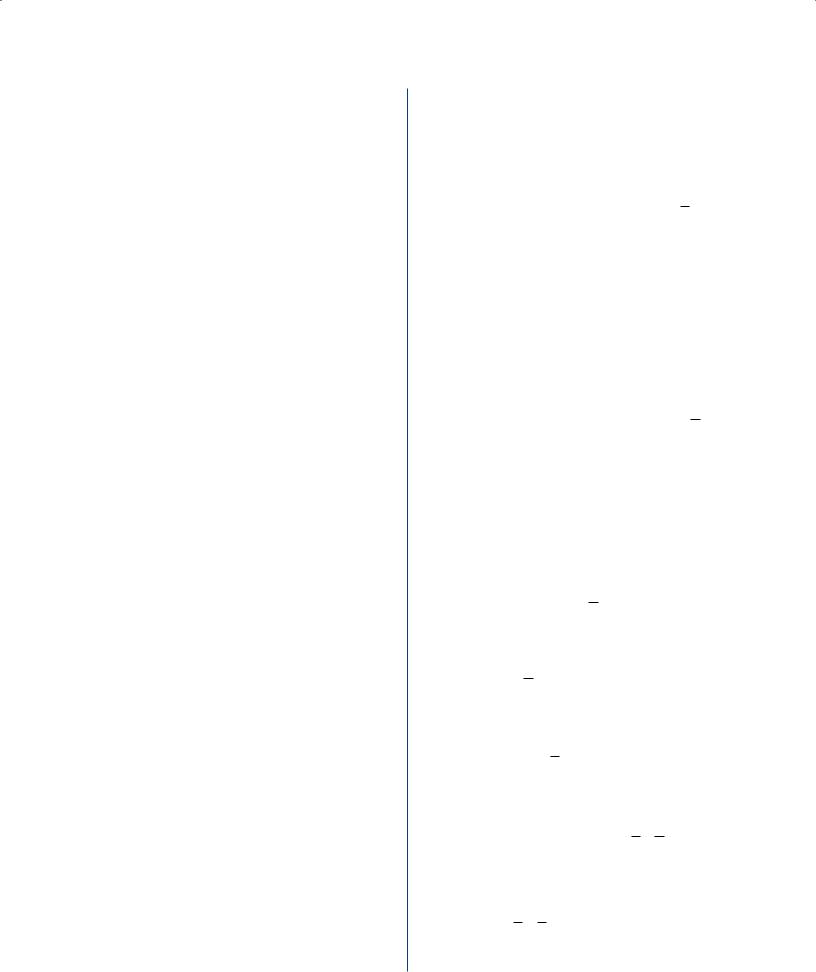
The Official Guide for GMAT® Review 12th Edition
Arithmetic Ratio and proportion
(1)Each of 10 sta members could have received 2 pens, 3 pencils, and 4 pads, or each of 20 sta members could have received 2 pens, 3 pencils, and 4 pads; NOT su cient.
(2)There could have been 1 sta member who received 18 pens, 27 pencils, and 36 pads, or 3 sta members each of whom received
6 pens, 9 pencils, and 12 pads; NOT su cient.
Assuming both (1) and (2), use the fact that 18:27:36 is equivalent to both 6:9:12 and 2:3:4 to obtain di erent possibilities for the number of sta . Each of 3 sta members could have received
6 pens, 9 pencils, and 12 pads, or each of 9 sta members could have received 2 pens, 3 pencils, and 4 pads. Therefore, (1) and (2) together are NOT su cient.
The correct answer is E;
both statements together are still not su cient.
112.Machines X and Y produced identical bottles at different constant rates. Machine X, operating alone for 4 hours, fi lled part of a production lot; then Machine Y, operating alone for 3 hours, fi lled the rest of this lot. How many hours would it have taken Machine X operating alone to fi ll the entire production lot?
(1)Machine X produced 30 bottles per minute.
(2)Machine X produced twice as many bottles in 4 hours as Machine Y produced in 3 hours.
Algebra Rate problem
Let rX and rY be the rates, in numbers of bottles produced per hour, of Machine X and Machine Y.
In 4 hours Machine X produces 4rX bottles working alone and in 3 hours Machine Y produces
3rY bottles working alone. Thus, 4rX + 3rY bottles are produced when Machine X operates alone for
4 hours followed by Machine Y operating alone for 3 hours. If t is the number of hours for
Machine X to produce the same number of bottles, then 4rX + 3rY = (rX)t.
(1)Given that Machine X produces 30 bottles per minute, then rX = (30)(60) = 1,800. This
does not determine a unique value for t, since more than one positive value of t satisfies (4)(1,800) + 3rY = (1,800)t when rY is allowed to vary over positive real numbers. For example, if rY = 600, then t = 5, and if rY = 1,200, then t = 6; NOT su cient.
(2)Given that 4rX = 2(3rY), so rX = 32 rY.
T erefore,h from 4rX + 3rY = (rX)t, it follows
3 |
|
|
|
3 |
t, or |
|
that 6rY + 3rY = |
2 |
rYt, or 6 + 3 = |
2 |
|||
t = 6; SUFFICIENT. |
|
|
||||
The correct answer is B; |
|
|
||||
statement 2 alone is su cient. |
|
|
||||
113. On a company-sponsored cruise, |
2 |
of the |
|
|
||
|
|
|
||||
3 passengers were company employees and the
remaining passengers were their guests. If 3 of the 4
company-employee passengers were managers, what was the number of company-employee passengers who were NOT managers?
(1)There were 690 passengers on the cruise.
(2)There were 230 passengers who were guests of the company employees.
Arithmetic Arithmetic operations
(1)From this, since 2 of the passengers were
3 |
2 |
× 690 = 460 |
|
company employees, then |
|||
3 |
|||
|
|
passengers were company employees. Then, since 3 of the company employees were
4 |
3 |
|
1 |
|
|
managers, so 1 – |
= |
of the company- |
|||
4 |
4 |
||||
|
|
|
employee passengers were not managers.
T ereforeh 1 × 460 = 115 company employees 4
who were not managers; SUFFICIENT.
(2)If 230 of the passengers were guests,
then this represents 1 – 2 = 1 of the cruise
3 3
passengers. Therefore, there were 230 × 3 =
690 passengers altogether, 690 – 230 = 460 of whom were company employees. Since
1 – 3 = 1 of the company employees were
44
326
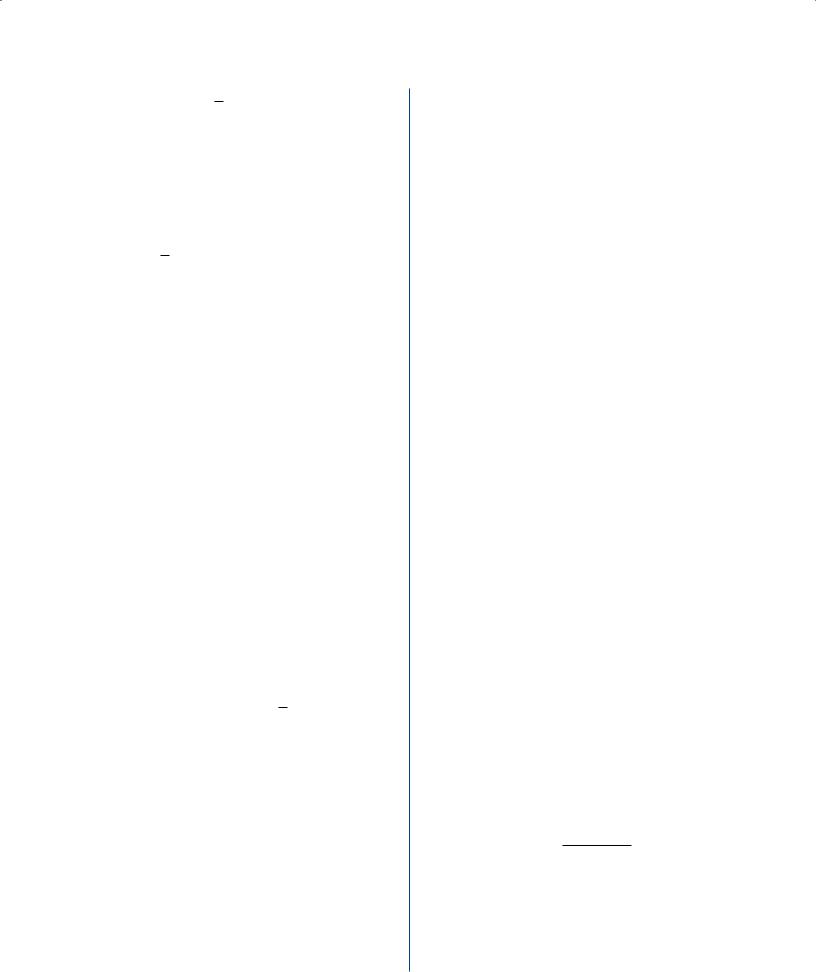
not managers, 1 × 460 = 115 of the 4
passengers who were company employees were not managers; SUFFICIENT.
The correct answer is D;
each statement alone is sufficient.
114.The length of the edging that surrounds circular
garden K is 1 the length of the edging that surrounds 2
circular garden G. What is the area of garden K ? (Assume that the edging has negligible width.)
(1)The area of G is 25π square meters.
(2)The edging around G is 10π meters long.
Geometry Circles; Area
Note that the length of the edging around a circular garden is equal to the circumference of the circle. The formula for the circumference of a circle, where C is the circumference and d is the diameter, is C = πd. The formula for the area of a circle, where A is the area and r is the radius, is
A = πr2. In any circle, r is equal to |
1 |
|
d. If the |
|||
2 |
|
|||||
|
|
|
|
1 |
|
|
length of the edging around K is equal to |
2 |
|
||||
the length of the edging around G, then |
|
|
||||
the circumference of K is equal to |
1 |
the |
|
|
||
|
|
|
||||
circumference of G. |
2 |
|
|
|
|
|
(1)Since the area of G is 25π square meters, 25π = πr2 or 25 = r2 and 5 = r. So, if the radius of G is 5, the diameter is 10, and the circumference of G is equal to 10π. Since
1
the circumference of K is 2 that of G, then
the circumference of K is 5π, making the diameter of K equal to 5. If the diameter of K is 5, the radius of K is 2.5, and the area of K is π (2.5)2 or 6.25π; SUFFICIENT.
(2)If the edging around G is 10π meters long, then the circumference of G is 10π. The area of K can then by found by proceeding as in (1); SUFFICIENT.
The correct answer is D;
each statement alone is su cient.
6.5Data Sufficiency Answer Explanations
115.For any integers x and y, min(x, y) and max(x, y) denote the minimum and the maximum of x and y, respectively. For example, min(5, 2) = 2 and max(5, 2) = 5. For the integer w, what is the value of min(10, w) ?
(1)w = max(20, z) for some integer z.
(2)w = max(10, w)
Arithmetic Properties of numbers
If w ≥ 10, then min(10, w) = 10, and if w < 10, then min(10, w) = w. Therefore, the value of min(10, w) can be determined if the value of w can be determined.
(1)Given that w = max(20, z), then w ≥ 20. Hence, w ≥ 10, and so min(10, w) = 10; SUFFICIENT.
(2)Given that w = max(10, w), then w ≥ 10, and so min(10, w) = 10; SUFFICIENT.
The correct answer is D;
each statement alone is su cient.
116.During a 6-day local trade show, the least number of people registered in a single day was 80. Was the average (arithmetic mean) number of people registered per day for the 6 days greater than 90 ?
(1)For the 4 days with the greatest number of people registered, the average (arithmetic mean) number registered per day was 100.
(2)For the 3 days with the smallest number of people registered, the average (arithmetic mean) number registered per day was 85.
Arithmetic Statistics
Let a, b, c, d, and e be the numbers of people registered for the other 5 days, listed in increasing
80 + a + b + c + d + e > 90
6
is equivalent to determining if
(80 + a + b + c + d + e) > (6)(90) = 540, or if a + b + c + d + e > 460.
(1) Given that b + c + d + e = 100, then
4
b + c + d + e = 400. Therefore, since a ≥ 80
(because 80 is the least of the 6 daily registration numbers), it follows that
a + b + c + d + e ≥ 80 + 400 = 480, and hence a + b + c + d + e > 460; SUFFICIENT.
327
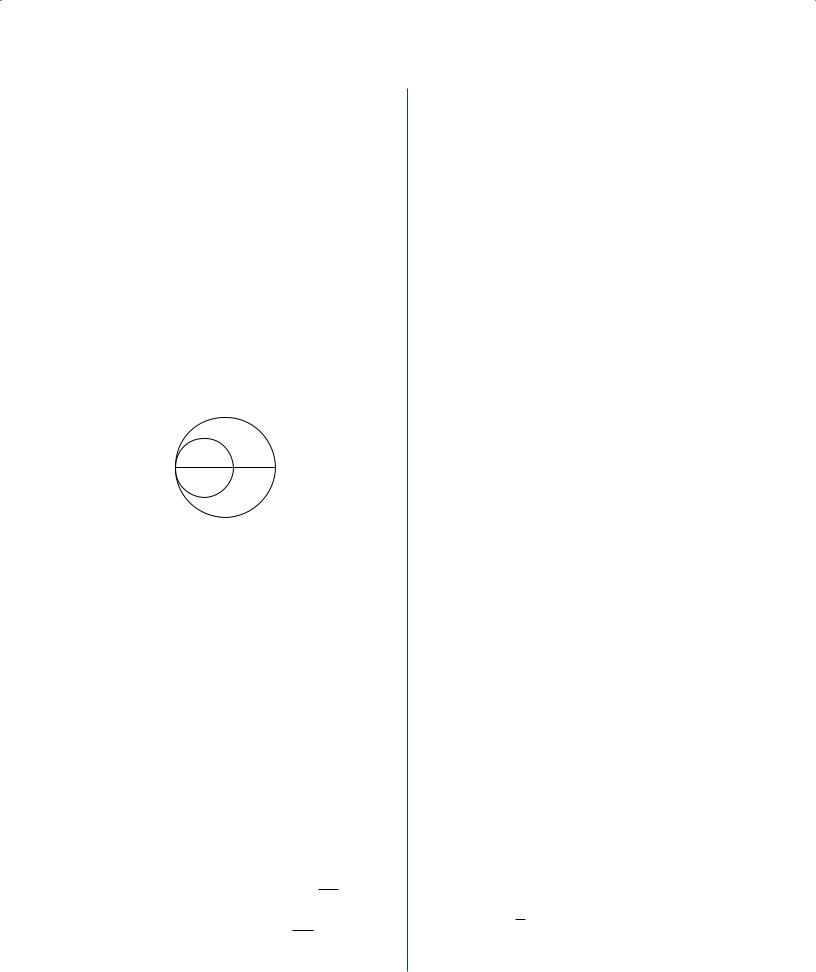
The Official Guide for GMAT® Review 12th Edition
(2) Given that 80 + a + b = 85, then 80 + a + b =
3
(3)(85), or a + b = 175. Note that this is possible with each of a and b being an integer that is at least 80, such as a = 87 and b = 88. From a + b = 175, the condition
a + b + c + d + e > 460 is equivalent to
175 + c + d + e > 460, or c + d + e > 285. However, using 3 integers that are each at least 88 (recall that the values of c, d, and e must be at least the value of b), it is possible for c + d + e > 285 to hold (for example, c = d = e = 100) and it is possible for c + d + e > 285 not to hold (for example, c = d = e = 90); NOT su cient.
The correct answer is A; statement 1 alone is su cient.
A 
 E
E
BC D
117.In the fi gure above, points A, B, C, D, and E lie on a line. A is on both circles, B is the center of the smaller circle, C is the center of the larger circle, D is on the smaller circle, and E is on the larger circle. What is the area of the region inside the larger circle and outside the smaller circle?
(1)AB = 3 and BC = 2
(2)CD = 1 and DE = 4
Geometry Circles
If R is the radius of the larger circle and r is the radius of the smaller circle, then the desired area is πR2 – πr2. Thus, if both the values of R and r can be determined, then the desired area can be determined.
(1)Given that AB = r = 3 and BC = 2, then AB + BC = R = 3 + 2 = 5; SUFFICIENT.
(2)Given that CD = 1 and DE = 4, then
CD + DE = R = 1 + 4 = 5. Since AE is a diameter of the larger circle, then
AD + DE = 2R. Also, since AD is a
diameter of the smaller circle, then AD = 2r. Thus, 2r + DE = 2R, or 2r + 4 = 10, and so r = 3; SUFFICIENT.
The correct answer is D;
each statement alone is su cient.
118.An employee is paid 1.5 times the regular hourly rate for each hour worked in excess of 40 hours per week, excluding Sunday, and 2 times the regular hourly rate for each hour worked on Sunday. How much was the employee paid last week?
(1)The employee’s regular hourly rate is $10.
(2)Last week the employee worked a total of 54 hours but did not work more than 8 hours on any day.
Arithmetic Arithmetic operations
The employee’s pay consists of at most 40 hours at the regular hourly rate, plus any overtime pay at either 1.5 or 2 times the regular hourly rate.
(1)From this, the employee’s regular pay for a
40-hour week is $400. However, there is no information about overtime, and so the employee’s total pay cannot be calculated; NOT sufficient.
(2)From this, the employee worked a total of 54 – 40 = 14 hours. However, there is no indication of how many hours were worked on Sunday (at 2 times the regular hourly rate) or another day (at 1.5 times the regular hourly rate); NOT sufficient.
With (1) and (2) taken together, there is still no way to calculate the amount of overtime pay.
The correct answer is E;
both statements together are still not sufficient.
119.What was the revenue that a theater received from the sale of 400 tickets, some of which were sold at the full price and the remainder of which were sold at a reduced price?
(1)The number of tickets sold at the full price
was 1 of the total number of tickets sold. 4
(2)The full price of a ticket was $25.
328
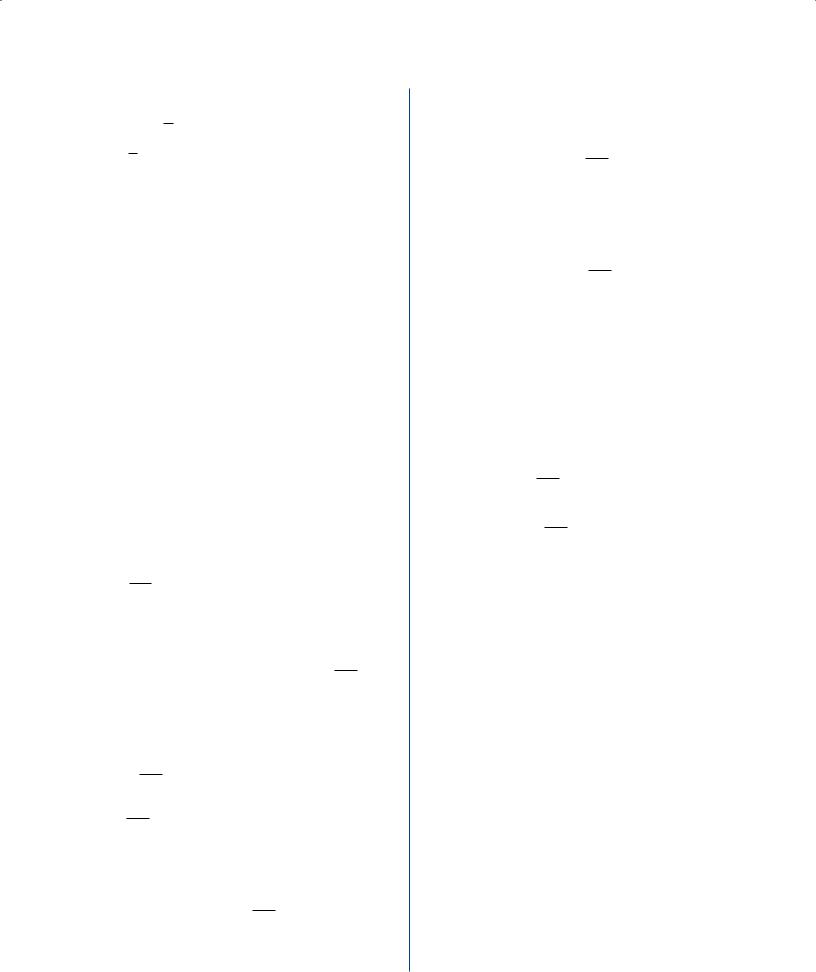
Arithmetic Arithmetic operations
(1) Since 1 of the tickets were sold at full price, 4
3 × 400 = 300 tickets were sold at a reduced 4
price. However, the revenue cannot be determined from this information; NOT sufficient.
(2)Although a full-priced ticket cost $25, the revenue cannot be determined without additional information; NOT sufficient.
When both (1) and (2) are taken together, the revenue from full-priced tickets was 100 × $25 = $2,500, but the cost of a reduced-priced ticket is still unknown, and the theater’s revenues cannot be calculated.
The correct answer is E;
both statements together are still not sufficient.
120.The annual rent collected by a corporation from a certain building was x percent more in 1998 than in 1997 and y percent less in 1999 than in 1998. Was the annual rent collected by the corporation from the building more in 1999 than in 1997 ?
(1)x > y
(2) |
xy |
< x – y |
100 |
Algebra Percents
Let A be the annual rent collected in 1997. Then the annual rent collected in 1998 is 1 + 100x A and the annual rent collected in 1999 is
|
|
+ |
|
|
|
|
|
− |
y |
|
|
|
|
|
|
|
|
|
|
|
|
|
|
|
|||
|
1 |
x |
|
|
|
1 |
100 |
A . Determine if |
|
|
|||||||||||||||||
|
|
|
100 |
|
|
|
|
|
|
|
|
|
|
|
|
|
|
|
|
|
|
|
|
||||
|
|
+ |
x |
|
|
|
− |
y |
|
|
> A, or equivalently, if |
||||||||||||||||
A 1 |
|
|
|
1 |
|
|
|
|
|
||||||||||||||||||
100 |
100 |
|
|||||||||||||||||||||||||
|
|
|
|
|
|
|
|
|
|
|
|
|
|
|
|
|
|
|
|
||||||||
|
1 |
+ |
x |
|
|
|
1 |
− |
y |
|
> 1. |
|
|
|
|
|
|
|
|
|
|
|
|||||
|
|
|
|
|
|
|
|
|
|
|
|
|
|
|
|
|
|||||||||||
|
100 |
|
|
100 |
|
|
|
|
|
|
|
|
|
|
|
||||||||||||
|
|
|
|
|
|
|
|
|
|
|
|
|
|
|
|
|
|
y |
|
||||||||
|
|
|
|
|
|
|
|
|
|
|
|
|
|
|
|
|
+ |
|
|
|
|
|
− |
||||
(1) Given that x > y, |
|
1 |
|
x |
|
1 |
100 |
> 1 |
|||||||||||||||||||
|
|
|
|
|
|
|
|
|
|
|
|
|
|
|
|
|
|
|
100 |
|
|
|
|
|
|||
|
|
|
is possible by choosing x = 100 and y = 10, |
||||||||||||||||||||||||
|
|
|
|
|
|
|
|
|
|
|
|
|
|
|
|
|
|
|
|
|
|
|
|
|
|||
|
|
|
since |
|
1 |
+ 100 |
|
1 |
− |
|
10 |
|
= (2)(0.9) = 1.8, |
||||||||||||||
|
|
|
|
|
|
|
|
|
|
|
100 |
|
|
|
|
100 |
|
|
|
|
|
|
|
||||
6.5 Data Sufficiency Answer Explanations
|
|
|
+ |
|
|
|
|
|
− |
|
y |
|
and |
|
1 |
|
x |
|
|
1 |
100 |
≤ 1 is possible |
|||
|
|
|
|
100 |
|
|
|
|
|
|||
by choosing x = 100 and y = 90, since |
||||||||||||
|
|
|
|
|
|
|
|
|
|
|
||
1 + 100 |
1 |
− |
|
90 |
= (2)(0.1) = 0.2; |
|||||||
|
100 |
|
|
|
100 |
|
|
|
||||
NOT su cient.
(2) As shown below, the given inequality xy
|
|
< x – y is equivalent to the desired |
|||||||||||
100 |
|||||||||||||
|
|
|
+ |
x |
|
|
− |
y |
|
|
|||
inequality, |
|
1 |
|
|
1 |
|
|
|
> 1, which |
||||
|
|
100 |
|||||||||||
|
|
|
|
|
|
100 |
|
|
|
|
|
||
can be justified by the following steps, where each step’s inequality is equivalent to the previous step’s inequality.
|
xy |
|
|
|
< |
|
|
x |
− |
|
|
y |
|
|
|
|
|
divide both sides |
|||||||||
10,000 |
|
100 |
|
100 |
|
|
|
||||||||||||||||||||
|
|
|
|
|
by 100 |
||||||||||||||||||||||
0 |
< |
|
|
x |
|
|
|
− |
y |
− |
|
|
|
|
xy |
|
|
subtract |
xy |
||||||||
|
|
100 |
|
|
100 |
|
|
10,000 |
|
10,000 |
|
||||||||||||||||
|
|
|
|
|
|
|
|
|
|
|
|
|
|
y |
|
|
|
|
|
|
xy |
from both sides |
|||||
1 |
< |
1 |
+ |
|
|
x |
− |
|
|
|
− |
|
|
|
add 1 to both |
||||||||||||
|
|
|
|
|
|
|
|
|
|
|
|
||||||||||||||||
|
|
100 |
|
100 |
|
|
10,000 |
||||||||||||||||||||
|
|
|
|
|
|
|
|
sides |
|||||||||||||||||||
|
|
|
|
|
|
|
x |
|
|
|
|
|
|
|
|
y |
|
|
|||||||||
|
< |
|
+ |
|
|
|
− |
|
factor the |
||||||||||||||||||
1 |
|
|
1 |
|
|
|
|
|
1 |
|
|
|
|
|
|
|
|
||||||||||
|
|
|
|
|
100 |
||||||||||||||||||||||
|
|
|
|
|
|
|
100 |
|
|
|
|
right side; |
|||||||||||||||
SUFFICIENT
The correct answer is B; statement 2 alone is su cient.
121.In the xy-plane, region R consists of all the points (x,y) such that 2x + 3y ≤ 6. Is the point (r,s) in region R ?
(1)3r + 2s = 6
(2)r ≤ 3 and s ≤ 2
Algebra Coordinate geometry
(1)Both (r,s) = (2,0) and (r,s) = (0,3) satisfy the equation 3r + 2s = 6, since 3(2) + 2(0) = 6 and
3(0) + 2(3) = 6. However, 2(2) + 3(0) = 4, so
(2,0) is in region R, while 2(0) + 3(3) = 9, so (0,3) is not in region R; NOT su cient.
(2)Both (r,s) = (0,0) and (r,s) = (3,2) satisfy the inequalities r ≤ 3 and s ≤ 2. However,
2(0) + 3(0) = 0, so (0,0) is in region R, while 2(3) + 3(2) = 12, so (3,2) is not in region R;
NOT su cient.
329
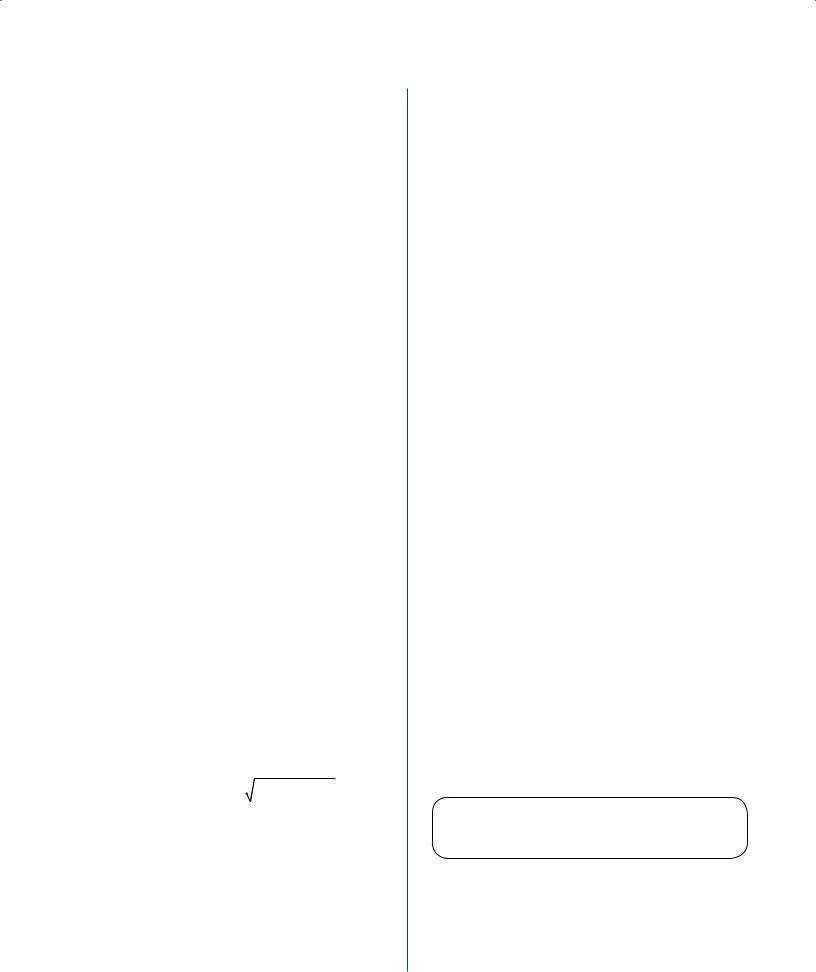
The Official Guide for GMAT® Review 12th Edition
Taking (1) and (2) together, it can be seen that both (r,s) = (2,0) and (r,s) = (1,1.5) satisfy
3r + 2s = 6, r ≤ 3 and s ≤ 2. However,
2(2) + 3(0) = 4, so (2,0) is in region R, while 2(1) + 3(1.5) = 6.5, so (1,1.5) is not in region R.
Therefore (1) and (2) together are NOT su cient.
The correct answer is E;
both statements together are still not su cient.
122.What is the volume of a certain rectangular solid?
(1)Two adjacent faces of the solid have areas 15 and 24, respectively.
(2)Each of two opposite faces of the solid has area 40.
Geometry Rectangular solids and cylinders
(1)If the edge lengths of the rectangular solid are 3, 5, and 8, then two adjacent faces will have areas (3)(5) = 15 and (3)(8) = 24 and the volume of the rectangular solid will be (3)(5)(8) = 120. If the edge lengths of the rectangular solid are 1, 15, 24, then two adjacent faces will have areas (1)(15) = 15 and (1)(24) = 24 and the volume of the rectangular solid will be (1)(15)(24) = 360; NOT su cient.
(2)If the edge lengths of the rectangular solid are 5, 8, and x, where x is a positive real number, then the rectangular solid will have a pair of opposite faces of area 40, namely the two faces that are 5 by 8. However, the volume is (5)(8)(x), which will vary as x varies; NOT su cient.
Taking (1) and (2) together, if the edge lengths are denoted by x, y, and z, then xy = 15, xz = 24, and yz = 40, and so (xy)(xz)(yz) = (15)(24)(40),
or (xyz)2 = (15)(24)(40). Thus, the volume of the |
|
rectangular solid is xyz = |
(15)(24)(40) . |
Therefore, (1) and (2) together are su cient.
The correct answer is C;
both statements together are su cient.
123.Joanna bought only $0.15 stamps and $0.29 stamps. How many $0.15 stamps did she buy?
(1)She bought $4.40 worth of stamps.
(2)She bought an equal number of $0.15 stamps and $0.29 stamps.
Algebra Simultaneous equations
Determine the value of x if x is the number of $0.15 stamps and y is the number of $0.29 stamps.
(1)Given that 15x + 29y = 440, then
29y = 440 – 15x. Because x is an integer,
440– 15x = 5(88 – 3x) is a multiple of 5. Therefore, 29y must be a multiple of 5, from which it follows that y must be a multiple of
5.Hence, the value of y must be among the numbers 0, 5, 10, 15, etc. To more e ciently test these values of y, note that
15x = 440 – 29y, and hence 440 – 29y must be a multiple of 15, or equivalently,
440– 29y must be a multiple of both 3 and
5.By computation, the values of 440 – 29y for y equal to 0, 5, 10, and 15 are 440, 295,
150, and 5. Of these, only 150, which corresponds to y = 10, is divisible by 3. From 15x = 440 – 29y it follows that x = 10 when y = 10. Therefore, x = 10 and y = 10;
SUFFICIENT.
(2)Although x = y, it is impossible to determine the value of x because there is no information on the total worth of the stamps Joanna bought. For example, if the total worth, in dollars, was 0.15 + 0.29, then x = 1, but if the total worth was 2(0.15) + 2(0.29), then x = 2; NOT su cient.
The correct answer is A; statement 1 alone is su cient.
|
Favorable |
Unfavorable |
Not Sure |
Candidate M |
40 |
20 |
40 |
Candidate N |
30 |
35 |
35 |
|
|
|
|
124.The table above shows the results of a survey of 100 voters who each responded “Favorable” or “Unfavorable” or “Not Sure” when asked about their
impressions of Candidate M and of Candidate N. What was the number of voters who responded “Favorable” for both candidates?
330

(1)The number of voters who did not respond “Favorable” for either candidate was 40.
(2)The number of voters who responded “Unfavorable” for both candidates was 10.
Arithmetic Sets
If x is the number of voters who responded
“Favorable” for both candidates, then it follows from the table that the number of voters who responded “Favorable” to at least one candidate is 40 + 30 – x = 70 – x. This is because 40 + 30 represents the number of voters who responded “Favorable” for Candidate M added to the number of voters who responded “Favorable” for
Candidate N, a calculation that counts twice each of the x voters who responded “Favorable” for both candidates.
(1)Given that there were 40 voters who did not respond “Favorable” for either candidate and there were 100 voters surveyed, the number of voters who responded “Favorable” to at least one candidate is 100 – 40 = 60.
Therefore, from the comments above, it follows that 70 – x = 60, and hence x = 10; SUFFICIENT.
(2)The information given a ects only the numbers of voters in the categories “Unfavorable” for Candidate M only,
“Unfavorable” for Candidate N only, and “Unfavorable” for both candidates. Thus, the numbers of voters in the categories “Favorable” for Candidate M only,
“Favorable” for Candidate N only, and “Favorable” for both candidates are not a ected. Since these latter categories are only constrained to have certain integer values that have a total sum of 70 – x, more than one possibility exists for the value of x. For example, the numbers of voters in the categories “Favorable” for Candidate M only, “Favorable” for Candidate N only, and “Favorable” for both candidates could be 25, 15, and 15, respectively, which gives 70 – x = 25 + 15 + 15, or x = 15. However, the numbers of voters in the categories
“Favorable” for Candidate M only,
“Favorable” for Candidate N only, and
6.5 Data Sufficiency Answer Explanations
“Favorable” for both candidates could be 30, 20, and 10, respectively, which gives 70 – x = 30 + 20 + 10, or x = 10; NOT su cient.
The correct answer is A; statement 1 alone is su cient.
125.If ° represents one of the operations +, –, and ×,
is k ° (C + m) = (k ° C) + (k ° m) for all numbers k, C, and m ?
(1)k ° 1 is not equal to 1 ° k for some numbers k.
(2)° represents subtraction.
Arithmetic Properties of numbers
(1)For operations + and ×, k ° 1 is equal to 1 ° k since both k + 1 = 1 + k, and also k × 1 = 1 × k. Therefore, the operation represented must be subtraction. From
this, it is possible to determine whether k – (C + m) = (k – C) + (k – m) holds for all numbers k, C, and m; SUFFICIENT.
(2)The information is given directly that the operation represented is subtraction.
Once again, it can be determined whether k – (C + m) = (k – C) + (k – m) holds for all numbers k, C, and m; SUFFICIENT.
The correct answer is D;
each statement alone is sufficient.
126.How many of the 60 cars sold last month by a certain dealer had neither power windows nor a stereo?
(1)Of the 60 cars sold, 20 had a stereo but not power windows.
(2)Of the 60 cars sold, 30 had both power windows and a stereo.
Algebra Sets
(1)With this information, there are three other categories of cars that are unknown: those equipped with both a stereo and power windows, with power windows but with
no stereo, and with neither power windows nor a stereo; NOT sufficient.
331
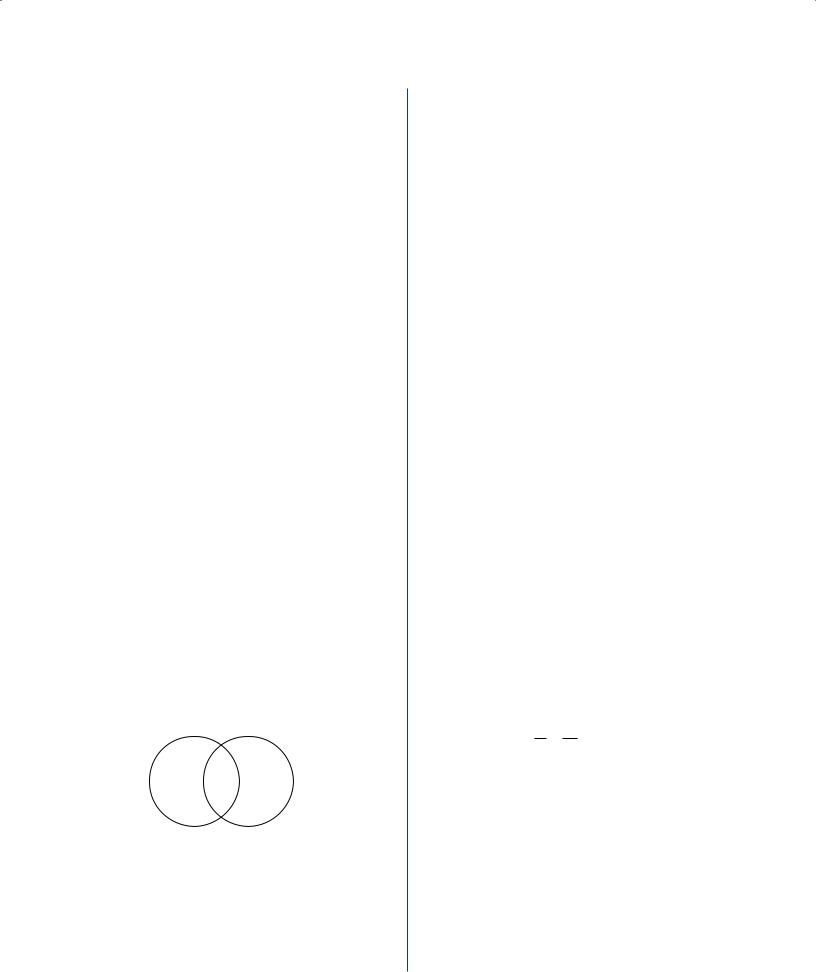
The Official Guide for GMAT® Review 12th Edition
(2)Again there are three other categories that are unknown: those with a stereo but no power windows, with power windows with no stereo, and with neither power windows nor a stereo; NOT sufficient.
From (1) and (2) together, it can be deduced that there were 60 – 50 = 10 cars sold that did not have a stereo. However, it is unknown and cannot be concluded from this information how many of these cars did not have a stereo but did have power windows or did not have either a stereo
or power windows.
The correct answer is E;
both statements together are still not sufficient.
127.In Jefferson School, 300 students study French or Spanish or both. If 100 of these students do not study French, how many of these students study both French and Spanish?
(1)Of the 300 students, 60 do not study Spanish.
(2)A total of 240 of the students study Spanish.
Algebra Sets (Venn diagrams)
One way to solve a problem of this kind is to represent the data regarding the 300 students by a Venn diagram. Let x be the number of students who study both French and Spanish, and let y be the number who do not study Spanish (i.e., those who study only French). It is given that there are 100 students who do not study French (i.e., those who study only Spanish). This information can be represented by the Venn diagram below, where 300 = x + y + 100:
French |
Spanish |
y x 100
(1)This provides the value of y in the equation
300 = x + y + 100, and the value of x (the number who study both languages) can thus be determined; SUFFICIENT.
(2)Referring to the Venn diagram above, this provides the information that 240 is the sum of x + 100, the number of students who study Spanish. That is, 240 is equal to the number who study both French and Spanish
(x) plus the number who study only Spanish
(100). Since 240 = x + 100, the value of x and thus the number who study both languages can be determined; SUFFICIENT.
The correct answer is D;
each statement alone is sufficient.
128.A school administrator will assign each student in a group of n students to one of m classrooms. If
3 < m < 13 < n, is it possible to assign each of the n students to one of the m classrooms so that each
classroom has the same number of students assigned to it?
(1)It is possible to assign each of 3n students to one of m classrooms so that each classroom has the same number of students assigned to it.
(2)It is possible to assign each of 13n students to one of m classrooms so that each classroom has the same number of students assigned to it.
Arithmetic Properties of numbers
Determine if n is divisible by m.
(1)Given that 3n is divisible by m, then n is divisible by m if m = n = 9 (note that 3n = 27 and m = 9, so 3n is divisible by m) and n is not divisible by m if m = 9 and n = 12 (note that 3n = 36 and m = 9, so 3n is divisible by m); NOT su cient.
(2)Given that 13n is divisible by m, then 13n = qm, or mn = 13q , for some integer q. Since 13 is a prime number that divides qm (because 13n = qm) and 13 does not divide m
(because m < 13), it follows that 13 divides q.
T |
erefore,h |
q |
is an integer, and since |
||||||
13 |
|
||||||||
|
n = |
q |
|
|
|
n |
|
||
|
m |
|
13 |
, then |
|
m |
is an integer. Thus, n is |
||
divisible by m; SUFFICIENT.
The correct answer is B; statement 2 alone is su cient.
332

129.What is the median number of employees assigned per project for the projects at Company Z ?
(1)25 percent of the projects at Company Z have 4 or more employees assigned to each project.
(2)35 percent of the projects at Company Z have 2 or fewer employees assigned to each project.
Arithmetic Statistics
(1)Although 25 percent of the projects have 4 or more employees, there is essentially no information about the middle values of the numbers of employees per project. For example, if there were a total of 100 projects, then the median could be 2 (75 projects that have exactly 2 employees each and
25 projects that have exactly 4 employees each) or the median could be 3 (75 projects that have exactly 3 employees each and
25 projects that have exactly 4 employees each); NOT su cient.
(2)Although 35 percent of the projects have 2 or fewer employees, there is essentially no information about the middle values of the numbers of employees per project. For example, if there were a total of 100 projects, then the median could be 3 (35 projects that have exactly 2 employees each and
65 projects that have exactly 3 employees each) or the median could be 4 (35 projects that have exactly 2 employees each and
65 projects that have exactly 4 employees each); NOT su cient.
Given both (1) and (2), 100 – (25 + 35) percent =
40 percent of the projects have exactly
3 employees. Therefore, when the numbers of employees per project are listed from least to greatest, 35 percent of the numbers are 2 or less and (35 + 40) percent = 75 percent are 3 or less, and hence the median is 3.
The correct answer is C;
both statements together are su cient.
6.5Data Sufficiency Answer Explanations
130.If Juan had a doctor’s appointment on a certain day, was the appointment on a Wednesday?
(1)Exactly 60 hours before the appointment, it was Monday.
(2)The appointment was between 1:00 p.m. and 9:00 p.m.
Arithmetic Arithmetic operations
(1)From this, it is not known at what point on Monday it was 60 hours before the
appointment, and the day of the appointment cannot be known. If, for example, the specific point on Monday was 9:00 a.m.,
60 hours later it would be 9:00 p.m. Wednesday, and the appointment would thus be on a Wednesday. If the specific point on
Monday was instead 9:00 p.m., 60 hours later it would be 9:00 a.m. Thursday, and the appointment would instead fall on a Thursday rather than Wednesday; NOT sufficient.
(2)No information is given about the day of the appointment; NOT sufficient.
Using (1) and (2) together, it can be determined that the point 60 hours before any time from
1:00 p.m. to 9:00 p.m. on any particular day, as given in (2), is a time between 1:00 a.m. and 9:00 a.m. two days earlier. If 60 hours before an appointment in this 1:00 p.m.–9:00 p.m. time frame it was Monday as given in (1), then the appointment had to be on a Wednesday.
The correct answer is C;
both statements together are sufficient.
131.When a player in a certain game tossed a coin a number of times, 4 more heads than tails resulted. Heads or tails resulted each time the player tossed the coin. How many times did heads result?
(1)The player tossed the coin 24 times.
(2)The player received 3 points each time heads resulted and 1 point each time tails resulted, for a total of 52 points.
333

The Official Guide for GMAT® Review 12th Edition
Arithmetic; Algebra Probability; Applied problems; Simultaneous equations
Let h represent the number of heads that resulted and t represent the number of tails obtained by the player. Then the information given can be expressed as h = t + 4.
(1)The additional information can be expressed as h + t = 24. When this equation is paired with the given information, h = t + 4, there are two linear equations in two unknowns. One way to conclude that we can determine the number of heads is to solve the equations simultaneously, thereby obtaining the number of heads and the number of tails: Solving h = t + 4 for t, which gives t = h – 4, and substituting the result in h + t = 24 gives h + (h – 4) = 24, which clearly can be solved for h. Another way to conclude that we can determine the number of heads is to note that the pair of equations represents two non-parallel lines in the coordinate plane;
SUFFICIENT.
(2)The additional information provided can be expressed as 3h + t = 52. The same comments in (1) apply here as well. For example, solving h = t + 4 for t, which gives t = h – 4, and substituting the result in
3h + t = 52 gives 3h + (h – 4) = 52, which clearly can be solved for h; SUFFICIENT.
The correct answer is D;
each statement alone is su cient.
y˚
x˚
w˚
z˚
132.What is the value of x + y in the fi gure above?
(1)w = 95
(2)z = 125
Geometry Angles
x˚ d˚ |
c˚ y˚ |
|
|
w˚ a˚ |
b˚ |
|
|
|
z˚ |
In the figure above, a, b, c, and d are the degree measures of the interior angles of the quadrilateral formed by the four lines and a + b + c + d = 360.
Then
w + x + y + z
=(180 – a) + (180 – d) + (180 – c) + (180 – b)
=720 – (a + b + c + d)
=720 – 360
=360.
Determine the value of x + y.
(1)Given that w = 95, then 95 + x + y + z = 360 and x + y + z = 265. If z = 65, for example, then x + y = 200. On the other hand, if
z = 100, then x + y = 165; NOT su cient.
(2)Given that z = 125, then w + x + y + 125 = 360 and w + x + y = 235. If w = 35, for example, then x + y = 200. On the other hand, if w = 100, then x + y = 135; NOT su cient.
Taking (1) and (2) together, 95 + x + y + 125 =
360, and so x + y = 140. Therefore, (1) and (2) together are su cient.
The correct answer is C;
both statements together are su cient.
133.Are all of the numbers in a certain list of 15 numbers equal?
(1)The sum of all the numbers in the list is 60.
(2)The sum of any 3 numbers in the list is 12.
Arithmetic Properties of numbers
(1)If there are 15 occurrences of the number 4 in the list, then the sum of the numbers in the list is 60 and all the numbers in the list
334

are equal. If there are 13 occurrences of the number 4 in the list, 1 occurrence of the number 3 in the list, and 1 occurrence of the number 5 in the list, then the sum of the numbers in the list is 60 and not all the numbers in the list are equal; NOT su cient.
(2)Given that the sum of any 3 numbers in the list is 12, arrange the numbers in the list in numerical order, from least to greatest:
a1 ≤ a2 ≤ a3 ≤ ... ≤ a15.
If a1 < 4, then a1 + a2 + a3 < 4 + a2 + a3. Therefore, from (2), 12 < 4 + a2 + a3, or
8 < a2 + a3, and so at least one of the values a2 and a3 must be greater than 4. Because a2 ≤ a3, it follows that a3 > 4. Since the numbers are arranged from least to greatest,
it follows that a4 > 4 and a5 > 4. But then a3 + a4 + a5 > 4 + 4 + 4 = 12, contrary to (2), and so a1 < 4 is not true. Therefore, a1 ≥ 4. Since a1 is the least of the 15 numbers,
an ≥ 4 for n = 1, 2, 3, ..., 15.
If a15 > 4, then a13 + a14 + a15 > a13 + a14 + 4. Therefore, from (2), 12 > a13 + a14 + 4, or
8 > a13 + a14, and so at least one of the values a13 and a14 must be less than 4. Because
a13 ≤ a14, it follows that a13 < 4. Since the numbers are arranged from least to greatest,
it follows that a11 < 4 and a12 < 4. But then a11 + a12 + a13 < 4 + 4 + 4 = 12, contrary to (2). Therefore, a15 ≤ 4. Since a15 is the
greatest of the 15 numbers, an ≤ 4 for n = 1, 2, 3, ..., 15.
It has been shown that, for n = 1, 2, 3, ...,
15, each of an ≥ 4 and an ≤ 4 is true. Therefore, an = 4 for n = 1, 2, 3, ..., 15;
SUFFICIENT.
The correct answer is B; statement 2 alone is su cient.
134.A scientist recorded the number of eggs in each of 10 birds’ nests. What was the standard deviation of the numbers of eggs in the 10 nests?
(1)The average (arithmetic mean) number of eggs for the 10 nests was 4.
(2)Each of the 10 nests contained the same number of eggs.
6.5 Data Sufficiency Answer Explanations
Arithmetic Statistics
Note that if all the values in a data set are equal to the same number, say x, then the average of the data set is x, the di erence between each data value and the average is x – x = 0, the sum of the squares of these di erences is 0, and so the standard deviation is 0. On the other hand, if the values in a data set are not all equal to the same number, then the standard deviation will be positive.
(1)If each of the 10 nests had 4 eggs, then the average would be 4 and the standard deviation would be 0. If 8 nests had 4 eggs, 1 nest had 3 eggs, and 1 nest had 5 eggs, then the average would be 4 and the standard deviation would be positive; NOT su cient.
(2)Since all of the data values are equal to the same number, the standard deviation is 0;
SUFFICIENT.
The correct answer is B; statement 2 alone is su cient.
S 45 m T
60 m
R |
15 m |
U |
|
W |
|
135.Quadrilateral RSTU shown above is a site plan for a parking lot in which side RU is parallel to side ST and RU is longer than ST. What is the area of the parking lot?
(1)RU = 80 meters
(2)TU = 20 10 meters
Geometry Area
The area of a quadrilateral region that has parallel 1
sides of lengths a and b and altitude h is 2 (a + b)h.
Therefore, it is su cient to know the lengths of the two parallel sides and the altitude in order to
335
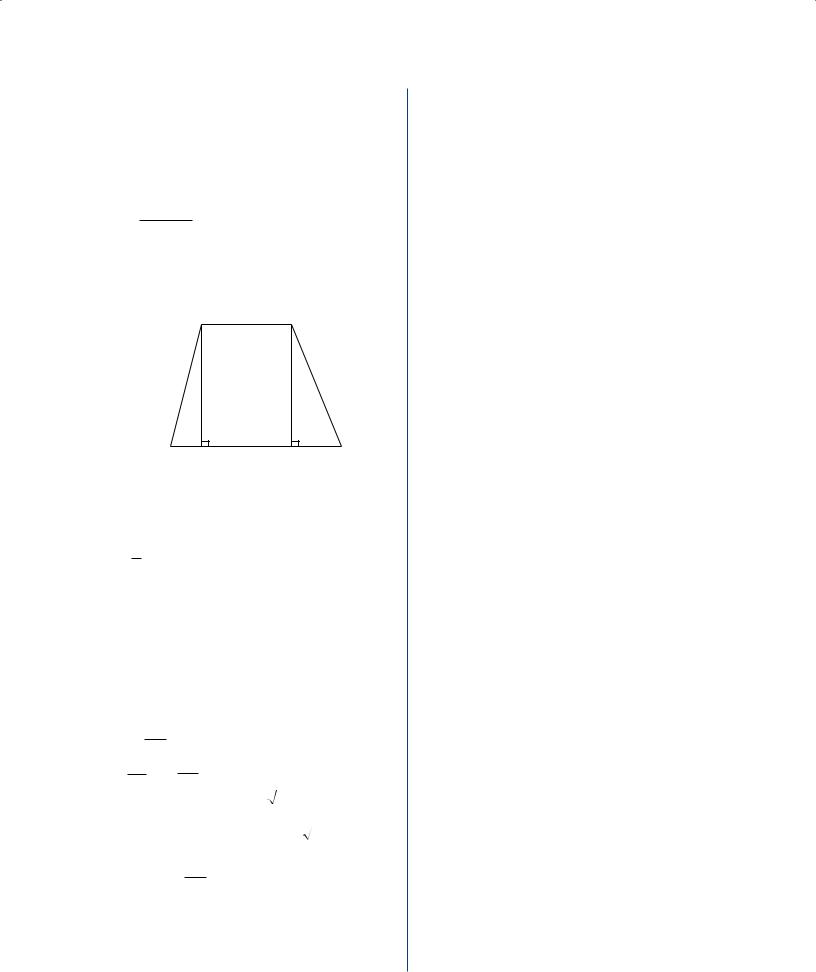
The Official Guide for GMAT® Review 12th Edition
find the area. The altitude is shown to be 60 m and the length of one of the parallel sides is 45 m.
(1)The length of the base of the quadrilateral, that is, the length of the second parallel side, is given. Thus, the area of the quadrilateral region, in square meters,
is (45 + 80)(60); SUFFICIENT. 2
Alternatively, if the formula is unfamiliar, drawing the altitude from T, as shown in the figure below, can be helpful.
S 45 m T
60 m
R |
15 m |
U |
|
W |
X |
Since ST = WX or 45 m, it can be seen that, in meters, RU = 15 + 45 + XU. Since
RU = 80, then 80 = 15 + 45 + XU, or XU = 20.
The area of RSTU is the sum of the areas
1
(2bh) of the two triangles ( SRW = 450 m2
and TUX = 600 m2) and the area (l × w) of the rectangle STWX (2,700 m2). Thus, the same conclusion can be drawn.
(2)Continue to refer to the supplemental figure showing the altitude drawn from T. Although the length of the base of the quadrilateral is not fully known, parts of the base (RW as well as WX = ST ) are known.
The only missing information is the length of XU . This can be found using the Pythagorean theorem with TUX. Since ST and RU are parallel, TX = SW = 60 m.
It is given that TU = 20 10 m. Using the Pythagorean theorem, where a2 + b2 = c2,
yields 602 + XU 2 = TU 2 = (20 10)2 and by simplification, 3,600 + XU 2 = 4,000, and thus XU 2 = 400 and XU = 20. Then, the
length of RU , in meters, is 15 + 45 + 20 =
80. Since this is the information given in (1), it can similarly be used to find the area of RSTU; SUFFICIENT.
The correct answer is D;
each statement alone is su cient.
136.If the average (arithmetic mean) of six numbers is 75, how many of the numbers are equal to 75 ?
(1)None of the six numbers is less than 75.
(2)None of the six numbers is greater than 75.
Arithmetic Statistics
If the average of six numbers is 75, then
1
6 of the sum of the numbers is 75. Therefore, the sum of the numbers is (6)(75).
(1)If one of the numbers is greater than 75, then we can write that number as 75 + x for some positive number x. Consequently, the sum of the 6 numbers must be at least (5)(75) + (75 + x) = (6)(75) + x, which is greater than (6)(75), contrary to the fact that the sum is equal to (6)(75). Hence, none of the numbers can be greater than 75. Since none of the numbers can be less than 75
(given information) and none of the numbers can be greater than 75, it follows that each of the numbers is equal to 75; SUFFICIENT.
(2)If one of the numbers is less than 75, then we can write that number as 75 – x for some positive number x. Consequently, the sum of the 6 numbers must be at most
(5)(75) + (75 – x) = (6)(75) – x, which is less than (6)(75), contrary to the fact that the sum is equal to (6)(75). Hence, none of the numbers can be less than 75. Since none of the numbers can be less than 75 and none of the numbers can be greater than 75
(given information), it follows that each of the numbers is equal to 75; SUFFICIENT.
The correct answer is D;
each statement alone is su cient.
137.At a bakery, all donuts are priced equally and all bagels are priced equally. What is the total price of 5 donuts and 3 bagels at the bakery?
(1)At the bakery, the total price of 10 donuts and 6 bagels is $12.90.
(2)At the bakery, the price of a donut is $0.15 less than the price of a bagel.
336
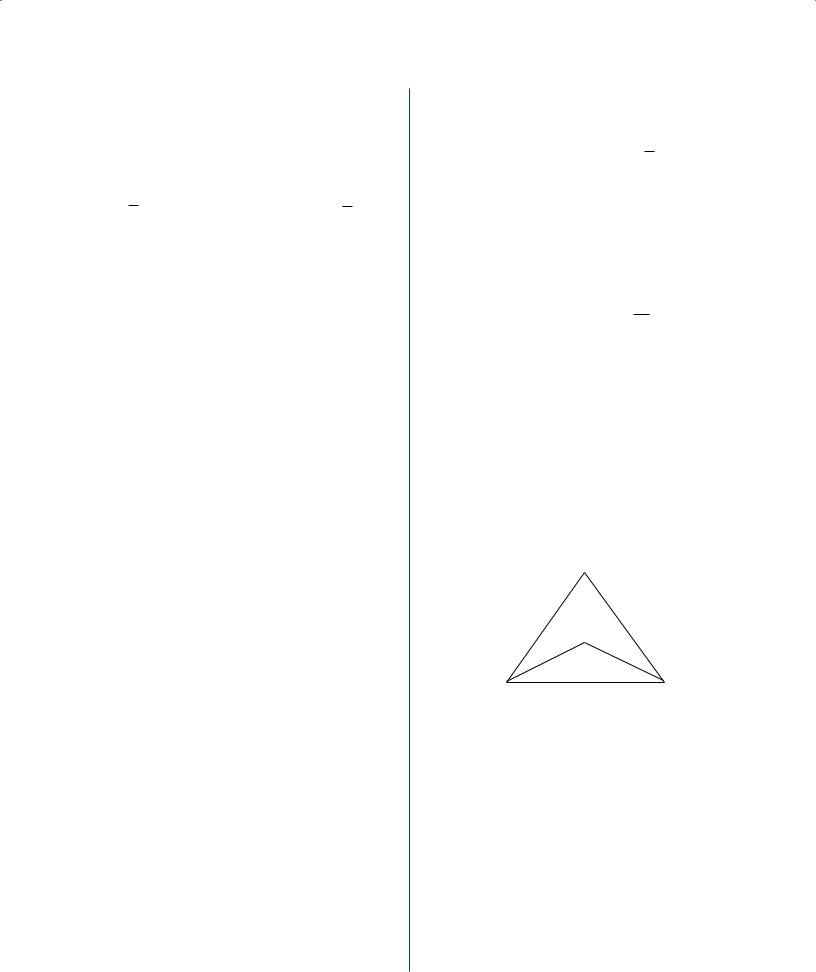
Algebra Simultaneous equations
Let x be the price, in dollars, of each donut and let y be the price, in dollars, of each bagel. Find the value of 5x + 3y.
(1)Given that 10x + 6y = 12.90, then 5x + 3y =
1(10x + 6y), it follows that 5x + 3y = 1
2 2 (12.90); SUFFICIENT.
(2)Given that x = y – 0.15, then 5x + 3y =
5(y – 0.15) + 3y = 8y – 0.75, which varies as y varies; NOT su cient.
The correct answer is A; statement 1 alone is su cient.
138.What was the total amount of revenue that a theater received from the sale of 400 tickets, some of which were sold at x percent of full price and the rest of which were sold at full price?
(1)x = 50
(2)Full-price tickets sold for $20 each.
Arithmetic Percents
(1)While this reveals that some of the
400 tickets were sold at 50 percent of full price and some were sold at full price, there is no information as to the amounts in either category, nor is there any information as
to the cost of a full-price ticket; NOT sufficient.
(2)Although this specifies the price of the full-price tickets, it is still unknown how many tickets were sold at full price or at a discount. Moreover, the percent of the discount is not disclosed; NOT sufficient.
While (1) and (2) together show that full-price tickets were $20 and discount tickets were
50 percent of that or $10, the number or percentage of tickets sold at either price, and thus the theater’s revenue, cannot be determined.
The correct answer is E;
both statements together are still not sufficient.
6.5Data Sufficiency Answer Explanations
139.Any decimal that has only a finite number of nonzero digits is a terminating decimal. For example, 24, 0.82,
and 5.096 are three terminating decimals. If r and s are positive integers and the ratio r is expressed
|
r |
s |
|
as a decimal, is |
a terminating decimal? |
||
s |
|||
|
|
(1)90 < r < 100
(2)s = 4
Arithmetic Properties of numbers
(1)This provides no information about the value of s. For example, 92 = 18.4, which
terminates, but |
92 |
5 |
|
= 30.666 . . . , which |
|||
|
3
does not terminate; NOT sufficient.
(2)Division by the number 4 must terminate: the remainder when dividing by 4 must be 0, 1, 2, or 3, so the quotient must end with
.0, .25, .5, or .75, respectively;
SUFFICIENT.
The correct answer is B; statement 2 alone is sufficient.
B
x°
D y°
A C
140.In the fi gure above, what is the value of x + y ?
(1)x = 70
(2)ABC and ADC are both isosceles triangles.
Geometry Triangles
(1)Even if x = 70, the location of point D can vary. As the location of D varies, the value of y will vary, and hence the value of x + y will vary. Therefore, the value of x + y cannot be determined; NOT su cient.
337
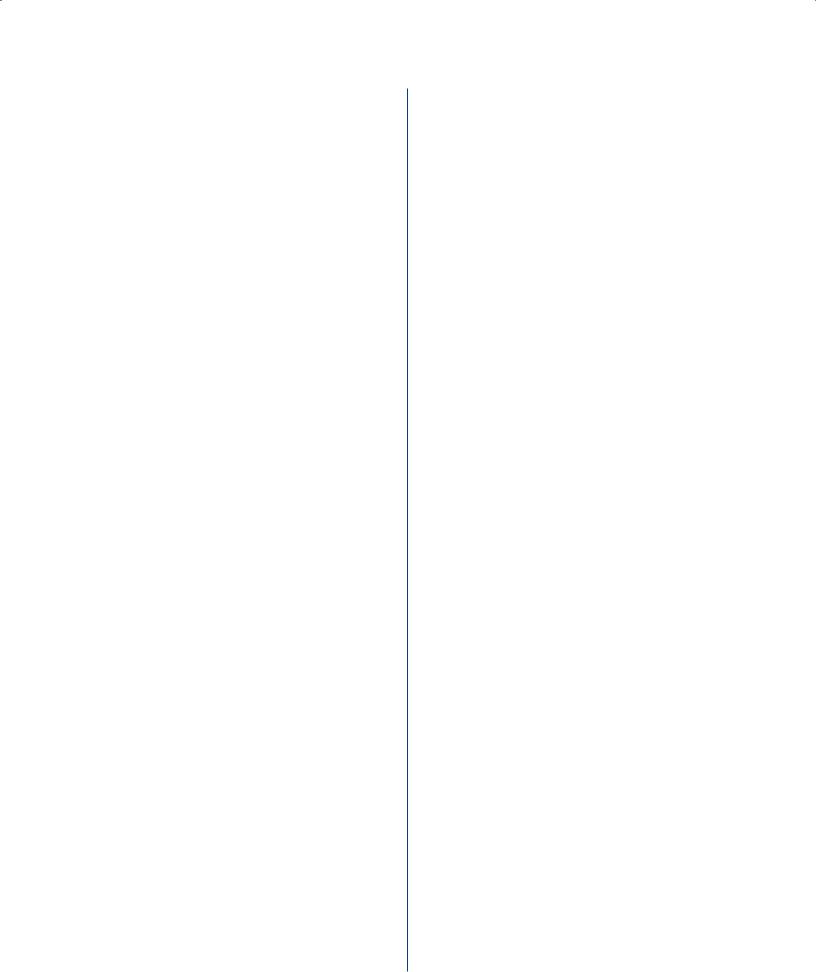
The Official Guide for GMAT® Review 12th Edition
(2) If ABC and ADC are isosceles triangles, then BAC and BCA have the same measure, and DAC and DCA have the same measure. However, since no values are given for any of the angles, there is no way to evaluate x + y; NOT su cient.
Taking (1) and (2) together, x = 70 and BAC and BCA have the same measure. Since the sum of the measures of the angles of a triangle is 180°, both BAC and BCA have measure 55° (70 + 55 + 55 = 180), but there is still no information about the value of y. Therefore, the value of x + y cannot be determined.
The correct answer is E;
both statements together are still not su cient.
141.Committee X and Committee Y, which have no common members, will combine to form Committee Z. Does Committee X have more members than Committee Y ?
(1)The average (arithmetic mean) age of the members of Committee X is 25.7 years and the average age of the members of Committee Y is 29.3 years.
(2)The average (arithmetic mean) age of the members of Committee Z will be 26.6 years.
Arithmetic Statistics
(1)The information given allows for variations in the numbers of members in Committee X and Committee Y. For example,
Committee X could have 10 members
(8 age 25, 1 age 27, 1 age 30 with average age
(8)(25)+ (1)(27 )+ (1)(30) = 25.7) and 10
Committee Y could have 10 members (8 age
25, 1 age 40, 1 age 53 with average age (8)(25)+ (1)(40)+ (1)(53)
10
so Committee X can fail to have more members than Committee Y. On the other hand, Committee X could have 100 members (80 age 25, 10 age 27,
10 age 30 with average age
(80)(25)+ (10)(27 )+ (10)(30)
= 25.7)
100
and Committee Y could have 10 members
(8 age 25, 1 age 40, 1 age 53 with average age (8)(25)+ (1)(40)+ (1)(53)
10
and so Committee X can have more members than Committee Y; NOT su cient.
(2) As above, the information given allows for variations in the numbers of members in
Committee X and Committee Y. For example, Committee Z could have
10 members (8 age 25 and 2 age 33 with
average age (8)(25)+ (2)(33) = 26.6). If 10
Committee X consists of the 2 members whose age is 33, then Committee X does not have more members than Committee Y.
On the other hand, if Committee X consists of the 8 members whose age is 25, then Committee X has more members than Committee Y; NOT su cient.
Given both (1) and (2), since 26.6 is closer to 25.7 than 29.3, it follows that Committee X has more members than Committee Y. This intuitively evident fact about averages can be proved algebraically. Let m and n be the numbers of members in Committees X and Y, respectively. Then it follows from (1) that the sum of the ages of the members in Committee X is (25.7)m and the sum of the ages of the members in Committee Y is (29.3)n. Therefore, the average age of the members in Committee Z is
(25.7 )m + (29.3)n m + n
(25.7 )m + (29.3)n m + n
(25.7)m + (29.3)n = (26.6)(m + n)
(0.9)m = (2.7)n
m = 3n
Since both m and n are positive by (1), it follows that m > n; SUFFICIENT.
The correct answer is C;
both statements together are su cient.
338
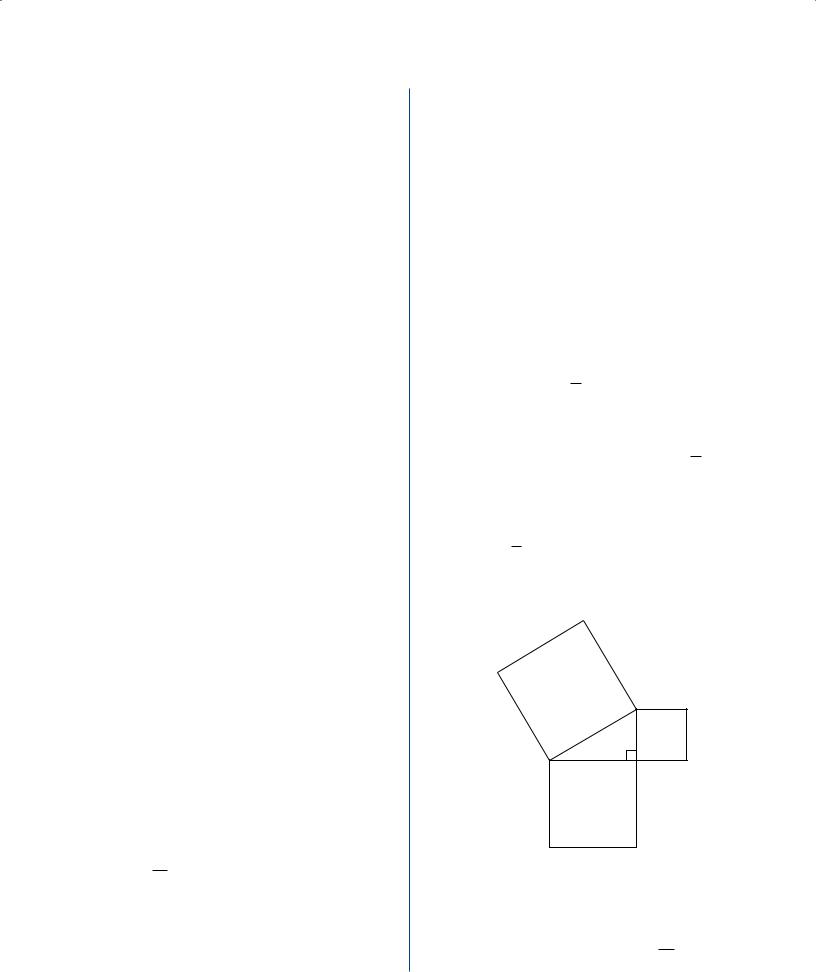
142.What amount did Jean earn from the commission on her sales in the fi rst half of 1988 ?
(1)In 1988 Jean’s commission was 5 percent of the total amount of her sales.
(2)The amount of Jean’s sales in the second half of 1988 averaged $10,000 per month more than in the fi rst half.
Arithmetic Applied problems
Let A be the amount of Jean’s sales in the first half of 1988. Determine the value of A.
(1)If the amount of Jean’s sales in the first half of 1988 was $10,000, then her commission in the first half of 1988 would have been
(5%)($10,000) = $500. On the other hand, if the amount of Jean’s sales in the first half of
1988 was $100,000, then her commission in the first half of 1988 would have been (5%) ($10,0000) = $5,000; NOT su cient.
(2)No information is given that relates the amount of Jean’s sales to the amount of Jean’s commission; NOT su cient.
Given (1) and (2), from (1) the amount of Jean’s commission in the first half of 1988 is (5%)A.
From (2) the amount of Jean’s sales in the second half of 1988 is A + $60,000. Both statements together do not give information to determine the value of A. Therefore, (1) and (2) together are NOT su cient.
The correct answer is E;
both statements together are still not su cient.
143.The price per share of Stock X increased by 10 percent over the same time period that the
price per share of Stock Y decreased by 10 percent. The reduced price per share of Stock Y was what percent of the original price per share of Stock X ?
(1)The increased price per share of Stock X was equal to the original price per share of Stock Y.
(2)The increase in the price per share of Stock X 10
was 11 Stock Y.
6.5 Data Sufficiency Answer Explanations
Arithmetic; Algebra Percents; Applied problems; Equations
Let x represent the original price per share of
Stock X. The amount that Stock X increased per share can then be represented by 0.1x and the increased price per share of Stock X by 1.1x. Let y represent the original price per share of Stock Y. The amount that Stock Y decreased per share can then be represented by 0.1y and the decreased price per share of Stock Y by 0.9y. The reduced price per share of Stock Y as a percent of the original price per share of Stock X is
|
0.9 y |
|
|
|
y |
|
|
|
100 |
% = (0.9 |
100)% |
|
|||
x |
|
||||||
|
|
|
x |
. |
|||
Therefore, the question can be answered exactly y
when the value of x can be determined.
(1) The increased price per share of Stock X is
1.1x, and this is given as equal to y. Thus, y
1.1x = y, from which the value of x can be determined; SUFFICIENT.
(2)The statement can be written as
0.1x = 10 0.1 y , from which the value y 11
of x can be determined; SUFFICIENT.
The correct answer is D;
each statement alone is su cient.
A
B
D
C
144.In the fi gure above, if the area of triangular region D is 4, what is the length of a side of square region A ?
(1)The area of square region B is 9.
64
(2) The area of square region C is 9 .
339

The Official Guide for GMAT® Review 12th Edition
Geometry Area
The area of the triangular region D can be
1
represented by 2bh, where b is the base of the
triangle (and is equal to the length of a side of the square region C) and h is the height of the triangle (and is equal to the length of a side of the square region B). The area of any square is equal to the length of a side squared. The Pythagorean theorem is used to find the length of a side of a right triangle, when the length of the other
2 sides of the triangle are known and is represented by a2 + b2 = c2, where a and b are the lengths of the 2 perpendicular sides of the triangle and c is the length of the hypotenuse.
Although completed calculations are provided in what follows, keep in mind that completed calculations are not needed to solve this problem.
(1)If the area of B is 9, then the length of each side is 3. Therefore, h = 3. Then, b can be determined, since the area of the triangle is, by substitution, 4 = 1 (3b) or 8 = 3b or 8 = b.
|
|
|
|
|
|
|
|
|
2 |
|
|
|
|
|
|
|
|
|
|
|
|
|
|
|
3 |
|
||
Once b is known, the Pythagorean theorem |
||||||||||||||||||||||||||||
|
|
|
|
|
|
8 2 |
+ |
3 |
2 |
= |
c |
2 |
|
64 + |
|
|
= |
|
2 |
|||||||||
can be used: |
|
|
|
|
|
|
or |
|
|
|
|
|
|
9 |
|
c |
|
|||||||||||
|
|
|
|
|
|
|
|
|
|
|
|
|
||||||||||||||||
145 = |
2 |
|
|
3 |
|
|
|
|
|
|
|
|
|
9 |
|
|
|
|
|
|
|
|
||||||
or |
|
|
|
. The length of a side of A |
|
|
|
|||||||||||||||||||||
9 |
|
|
|
|
||||||||||||||||||||||||
is thus |
|
|
|
|
; SUFFICIENT. |
|
|
|
|
|
|
|
|
|||||||||||||||
|
9 |
|
|
|
|
|
|
|
|
|
|
|||||||||||||||||
(2) If the area of C is |
64 |
, then the length of |
|
|||||||||||||||||||||||||
9 |
|
|||||||||||||||||||||||||||
each side is |
8 |
. Therefore, b = |
8 |
. The area |
||||||||||||||||||||||||
|
||||||||||||||||||||||||||||
|
|
|
|
3 |
|
|
|
1 |
|
|
|
|
3 |
1 8 |
|
|
|
|||||||||||
of the triangle is A = |
|
|
bh so 4 = |
|
|
|
|
|
h |
, |
||||||||||||||||||
2 |
2 3 |
|
||||||||||||||||||||||||||
8 = 83 h, and 3 = h. Once h is known, the
Pythagorean theorem can be used as above; SUFFICIENT.
The correct answer is D;
each statement alone is su cient.
145.If Sara’s age is exactly twice Bill’s age, what is Sara’s age?
(1)Four years ago, Sara’s age was exactly 3 times Bill’s age.
(2)Eight years from now, Sara’s age will be exactly 1.5 times Bill’s age.
Algebra Applied problems
If s and b represent Sara’s and Bill’s ages in years, then s = 2b.
(1)The additional information can be expressed as s – 4 = 3(b – 4), or s = 3b – 8. When
this equation is paired with the given information, s = 2b, there are two linear equations in two unknowns. One way to conclude that we can determine the value of s is to solve the equations simultaneously.
Setting the two expressions for s equal to each other gives 3b – 8 = 2b, or b = 8. Hence, s = 2b = (2)(8) = 16. Another way to conclude that we can determine the value of s is to note that the pair of equations represents two non-parallel lines in the coordinate plane; SUFFICIENT.
(2)The additional information provided can be expressed as s + 8 = 1.5(b + 8). The same comments in (1) apply here as well. For example, multiplying both sides of s + 8 = 1.5(b + 8) by 2 gives 2s + 16 = 3b + 24 or, using s = 2b, 2(2b) + 16 = 3b + 24. Therefore, 4b – 3b = 24 – 16, or b = 8. Hence, s = 2b = (2)(8) = 16; SUFFICIENT.
The correct answer is D;
each statement alone is su cient.
146.A report consisting of 2,600 words is divided into 23 paragraphs. A 2-paragraph preface is then added
to the report. Is the average (arithmetic mean) number of words per paragraph for all 25 paragraphs less than 120 ?
(1)Each paragraph of the preface has more than 100 words.
(2)Each paragraph of the preface has fewer than 150 words.
Arithmetic Statistics
Determining if the average number of words for 25 paragraphs is less than 120 is equivalent to determining if the total number of words for the 25 paragraphs is less than (25)(120) = (25)(4)(30)
= (100)(30) = 3,000. Since there are 2,600 words in the original 23 paragraphs, this is equivalent to determining if the total number of words
in the 2 added paragraphs is less than
3,000 – 2,600 = 400.
340
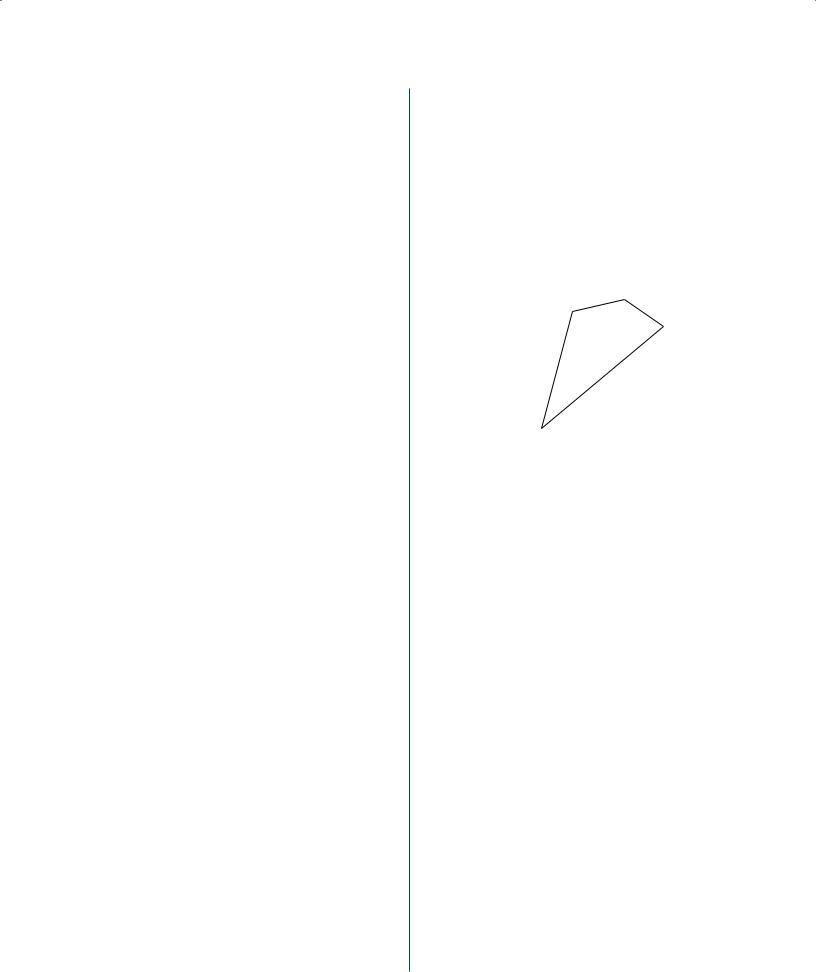
(1)The information provided implies only that the total number of words in the 2 added paragraphs is more than (2)(100) = 200. Therefore, the number of words could be 201, in which case the total number of added words is less than 400, or the number of words could be 400, in which case the number of added words is not less than 400; NOT su cient.
(2)The information provided implies that the total number of words in the 2 added paragraphs is less than (2)(150) = 300, which in turn is less than 400; SUFFICIENT.
The correct answer is B; statement 2 alone is su cient.
147.A certain bookcase has 2 shelves of books. On the upper shelf, the book with the greatest number of pages has 400 pages. On the lower shelf, the book with the least number of pages has 475 pages. What is the median number of pages for all of the books on the 2 shelves?
(1)There are 25 books on the upper shelf.
(2)There are 24 books on the lower shelf.
Arithmetic Statistics
(1)The information given says nothing about the number of books on the lower shelf. If there are fewer than 25 books on the lower shelf, then the median number of pages will be the number of pages in one of the books on the upper shelf or the average number of pages in two books on the upper shelf.
Hence, the median will be at most 400. If there are more than 25 books on the lower shelf, then the median number of pages will be the number of pages in one of the books on the lower shelf or the average number of pages in two books on the lower shelf.
Hence, the median will be at least 475;
NOT su cient.
(2)An analysis very similar to that used in (1) shows the information given is not su cient to determine the median; NOT su cient.
6.5 Data Sufficiency Answer Explanations
Given both (1) and (2), it follows that there is a total of 49 books. Therefore, the median will be the 25th book when the books are ordered by number of pages. Since the 25th book in this ordering is the book on the upper shelf with the greatest number of pages, the median is 400.
Therefore, (1) and (2) together are su cient.
The correct answer is C;
both statements together are su cient.
x
x
x + 60
3x
148.The fi gure above shows the number of meters in the lengths of the four sides of a jogging path. What is the total distance around the path?
(1)One of the sides of the path is 120 meters long.
(2)One of the sides of the path is twice as long as each of the two shortest sides.
Geometry Quadrilaterals
Determine the value of 6x + 60, which can be determined exactly when the value of x can be determined.
(1)Given that one of the sides has length 120, it is possible that x = 120, that 3x = 120, or x + 60 = 120. These possibilities generate more than one value for x; NOT su cient.
(2)Since x < x + 60 and x < 3x (the latter because x is positive), the two shortest side lengths are x. One of the two other side lengths is twice this, so it follows that
x + 60 = 2x, or x = 60; SUFFICIENT.
The correct answer is B; statement 2 alone is su cient.
341
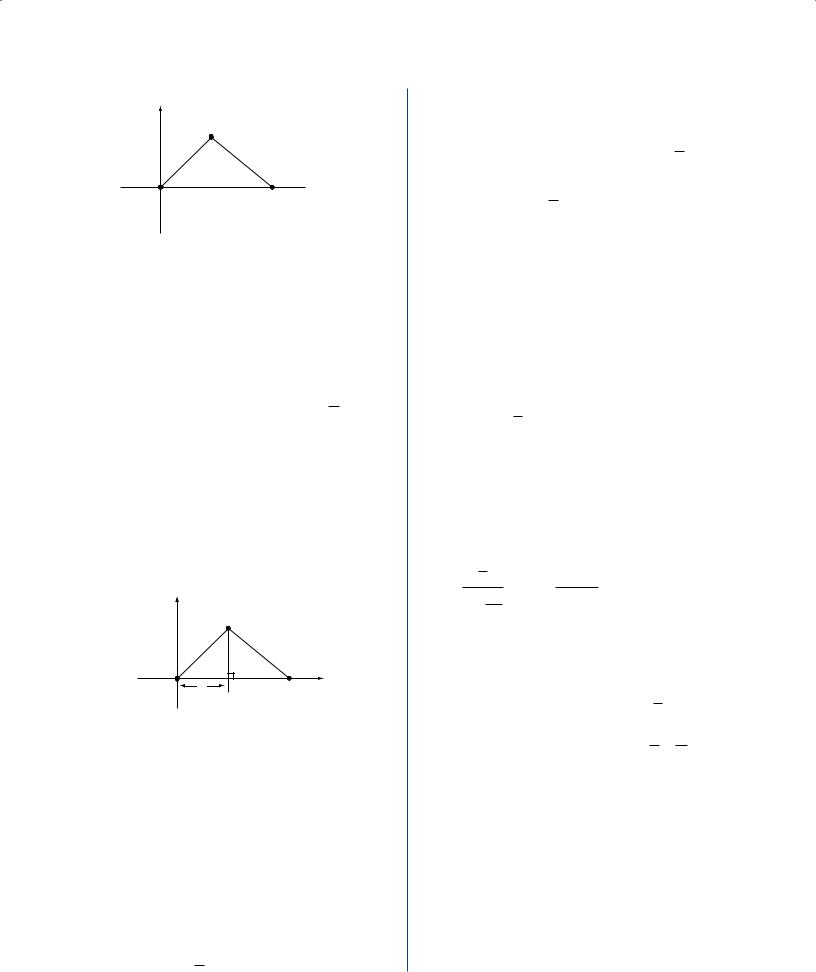
The Official Guide for GMAT® Review 12th Edition
y
P
 x
x
O |
Q |
149.In the rectangular coordinate system above, if
OP < PQ, is the area of region OPQ greater than 48 ?
(1)The coordinates of point P are (6,8).
(2)The coordinates of point Q are (13,0).
Geometry Coordinate Geometry; Triangles
The area of a triangle with base b and altitude h
1
can be determined through the formula 2bh. The
altitude of a triangle is the line segment drawn from a vertex perpendicular to the side opposite that vertex. In a right triangle (formed here since it is given that the altitude is perpendicular to the side), the Pythagorean theorem states that the square of the length of the hypotenuse is equal to the sum of the squares of the lengths of the legs of the triangle.
|
y |
|
|
|
P |
|
|
8 |
O |
6 |
x |
Q |
||
|
|
R |
(1)The given information fi xes the side lengths of ORP as 6, 8, 10 (twice a 3-4-5 triangle), and the farther Q is from R (i.e., the greater
the value of PQ), the greater the area of PRQ, and hence the greater the area of OPQ. If PQ = 10, then the area of OPQ would be 48. Since it is known that PQ > 10
(because 10 = OP < PQ), it follows that the area of OPQ is greater than 48;
SUFFICIENT.
(2)The given information implies that OQ = 13. However, no information is given about the
height of P above the x-axis. Since the area
1
of ORP is 2 the product of OQ and the
height of P above the x-axis, it cannot be determined whether the area of ORP is greater than 48. For example, if this height
were 2, then the area would be 12(2)(13) = 13, and if this height were 8, then the area
would be 1(8)(13) = 52; NOT su cient. 2
The correct answer is A; statement 1 alone is su cient.
|
|
2 |
|
|
|
S = |
|
|
n |
|
|
1 |
+ |
2 |
|||
|
x |
|
|
3x |
|
150.In the expression above, if xn ≠ 0, what is the value of S ?
(1)x = 2n
1
(2)n =
2
Algebra Firstand second-degree equations
It may be helpful to rewrite the given expression for S by multiplying its numerator and denominator by a common denominator of
the secondary fractions (i.e., the common denominator of n, x, and 3x):
2 |
|
3nx = |
6x |
= 6x |
|
6 |
|
n |
|
= |
x |
||||
1 + |
2 |
3nx 3n + 2n 5n |
5 n . |
||||
x |
3x |
|
|
|
|||
Therefore, the value of the expression can be
x determined exactly when the value of n can be
determined.
(1)From x = 2n it follows that x = 2;
SUFFICIENT. |
n |
|
||||
(2) From n = |
1 |
it follows that |
x |
= |
x |
= 2x, |
2 |
|
n 1 |
|
|||
|
|
|
2 |
|
||
which can vary; NOT su cient.
The correct answer is A; statement 1 alone is su cient.
151.If n is a positive integer and k = 5.1 × 10n, what is the value of k ?
(1)6,000 < k < 500,000
(2)k2 = 2.601 × 109
342
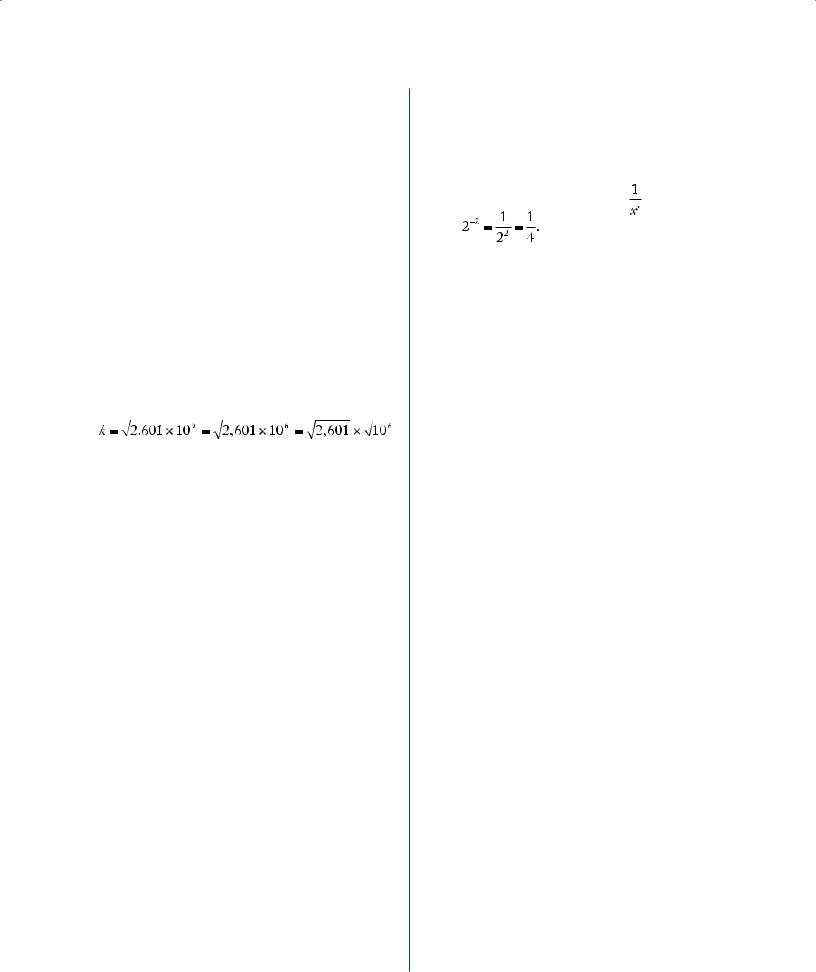
Arithmetic Properties of numbers
Given that k = 5.1 × 10n, where n is a positive integer, then the value of k must follow the pattern shown in the following table:
nk
151
2510
35,100
451,000
5510,000
65,100,000
∙∙
∙∙
∙∙
(1)Given that 6,000 < k < 500,000, then k must have the value 51,000, and so n = 4;
SUFFICIENT.
(2)Given that k2 = 2.601 × 109, then
=51 × 103 = 51,000, and so n = 4; SUFFICIENT.
The correct answer is D;
each statement alone is su cient.
152.If Carmen had 12 more tapes, she would have twice as many tapes as Rafael. Does Carmen have fewer tapes than Rafael?
(1)Rafael has more than 5 tapes.
(2)Carmen has fewer than 12 tapes.
Algebra Inequalities
If C and R are the numbers of tapes that Carmen and Rafael have, respectively, then C + 12 = 2R, or C = 2R – 12. To determine if C < R, it is equivalent to determining if 2R – 12 < R, or equivalently, if R < 12.
(1)Given that R > 5, it is possible that R < 12 (for example, if R = 8 and C = 4) and it is possible that R e 12 (for example, if R = 12 and C = 12); NOT su cient.
(2)Given that C < 12, it follows that
2R – 12 < 12, or R < 12; SUFFICIENT.
The correct answer is B; statement 2 alone is su cient.
6.5Data Sufficiency Answer Explanations
153.If x is an integer, is x |x| < 2x ?
(1)x < 0
(2)x = –10
Arithmetic Properties of numbers
Note that x-r is equivalent to ; for example,
(1)Since |x| > 0 when x ≠ 0, it follows from x < 0 that x|x| is the product of a negative number and a positive number, and hence x|x| is negative. On the other hand, 2x is positive for any number x. Since each negative number is less than each positive number, it follows that x|x| < 2x; SUFFICIENT.
(2)The fact that x = –10 is a specific case of the argument in (1); SUFFICIENT.
The correct answer is D;
each statement alone is su cient.
154.If n is a positive integer, is the value of b – a at least twice the value of 3n – 2n ?
(1)a = 2n + 1 and b = 3n + 1
(2)n = 3
Algebra Exponents
If r, s, and x are real numbers with x > 0, then xr + s = (xr)(xs). Therefore, 2n + 1 = (2n)(21) = (2n)(2) and 3n + 1 = (3n)(31) = (3n)(3).
(1)From this, applying the properties of exponents:
b – a = 3n + 1 – 2n + 1 = 3(3n) – 2(2n)
Twice the value of the given expression
3n – 2n is equal to 2(3n – 2n) or 2(3n) – 2(2n).
It is known that b – a = 3(3n) – 2(2n), which is greater than 2(3n) – 2(2n). Thus, b – a is at least twice the value of 3n – 2n; SUFFICIENT.
(2)This statement gives no information about b – a; NOT su cient.
The correct answer is A; statement 1 alone is su cient.
343
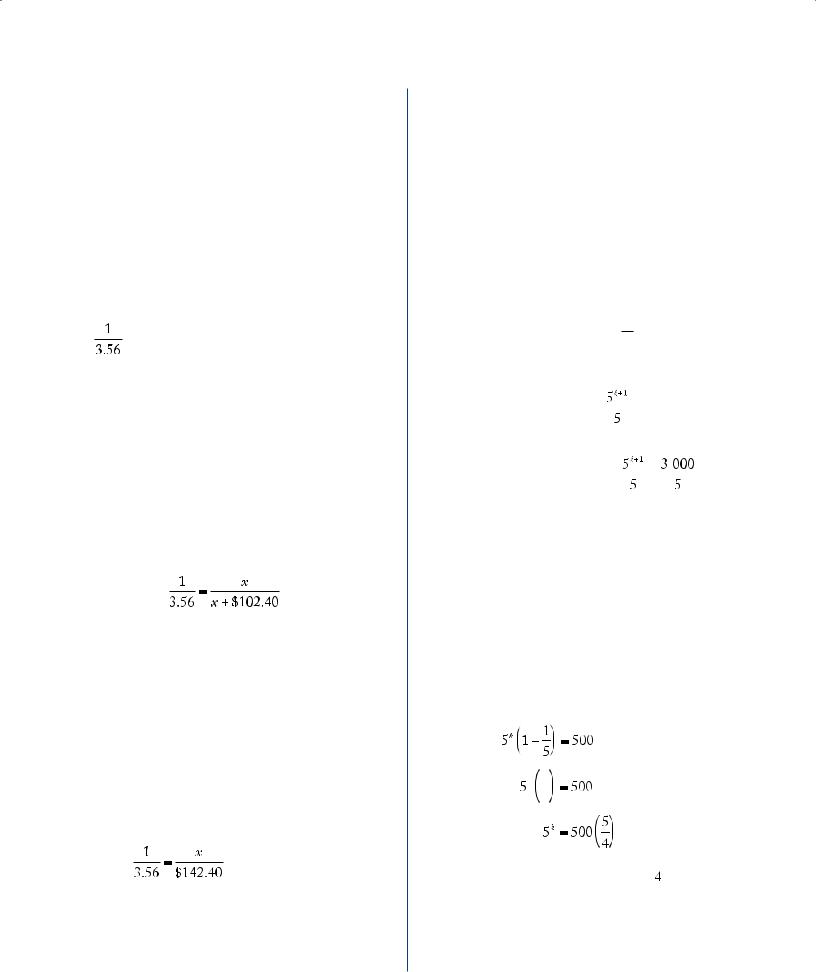
The Official Guide for GMAT® Review 12th Edition
155.The infl ation index for the year 1989 relative to the year 1970 was 3.56, indicating that, on the average, for each dollar spent in 1970 for goods, $3.56 had to be spent for the same goods in 1989. If the price of a Model K mixer increased precisely according to the
infl ation index, what was the price of the mixer in 1970 ?
(1)The price of the Model K mixer was $102.40 more in 1989 than in 1970.
(2)The price of the Model K mixer was $142.40 in 1989.
Arithmetic Proportions
The ratio of 1970 goods to 1989 goods is 1:3.56 or
. This ratio can be used to set up a proportion
between 1970 goods and 1989 goods. Let x represent the 1970 price of the mixer. Although the 1970 price of the mixer is calculated in what follows, keep in mind that the object of this data su ciency question is to determine whether the price can be calculated from the information given, not necessarily to actually calculate the price.
(1)From this, the 1989 price of the mixer can be expressed as x + $102.40. Therefore a proportion can be set up and solved for x:
x + $102.40 |
= 3.56x |
cross multiply |
$102.40 |
= 2.56x |
subtract x from |
|
|
both sides |
$40 |
= x |
divide both sides |
|
|
by 2.56 |
T e priceh of the mixer in 1970 was $40;
SUFFICIENT.
(2)The following proportion can be set up using the information that the 1989 price of the mixer was $142.40:
3.56x = $142.40 |
cross multiply |
x = $40 |
divide both sides |
|
by 3.56 |
T e priceh of the mixer in 1970 was $40;
SUFFICIENT.
The correct answer is D;
each statement alone is su cient.
156.Is 5k less than 1,000 ?
(1)5k + 1 > 3,000
(2)5k – 1 = 5k – 500
Arithmetic Arithmetic operations
If x is any positive number and r and s are any
positive integers, then x–r = 1 and xr + s = (xr)(xs). xr
Therefore, 5k + 1 = 5k(51). When both sides of this equation are divided by 51 (which equals 5),
the resultant equation is 



(1)If both sides of this given inequality are divided by 5, it yields 

 or
or
5k > 600. Although it is known that
5k > 600, it is unknown if 5k is less than 1,000; NOT sufficient.
(2)It is given that 5k – 1 = 5k – 500, thus:
|
5k – 5k – 1 = 500 |
subtract 5k from both |
|||||||
|
|
|
|
|
|
|
|
sides; divide all terms |
|
|
|
|
|
|
|
|
|
by –1 |
|
5k – 5k (5–1) = 500 |
property of exponents |
||||||||
5 |
k − |
5 |
k |
1 |
|
= |
500 |
substitute for 5 |
–1 |
|
|||||||||
|
|
|
|
|
|
||||
|
|
|
|
5 |
|
|
|
|
|
factor out 5k

 simplify 5
simplify 5
multiply both sides by 

5k = 625, which is less than 1,000;
SUFFICIENT.
The correct answer is B; statement 2 alone is sufficient.
344
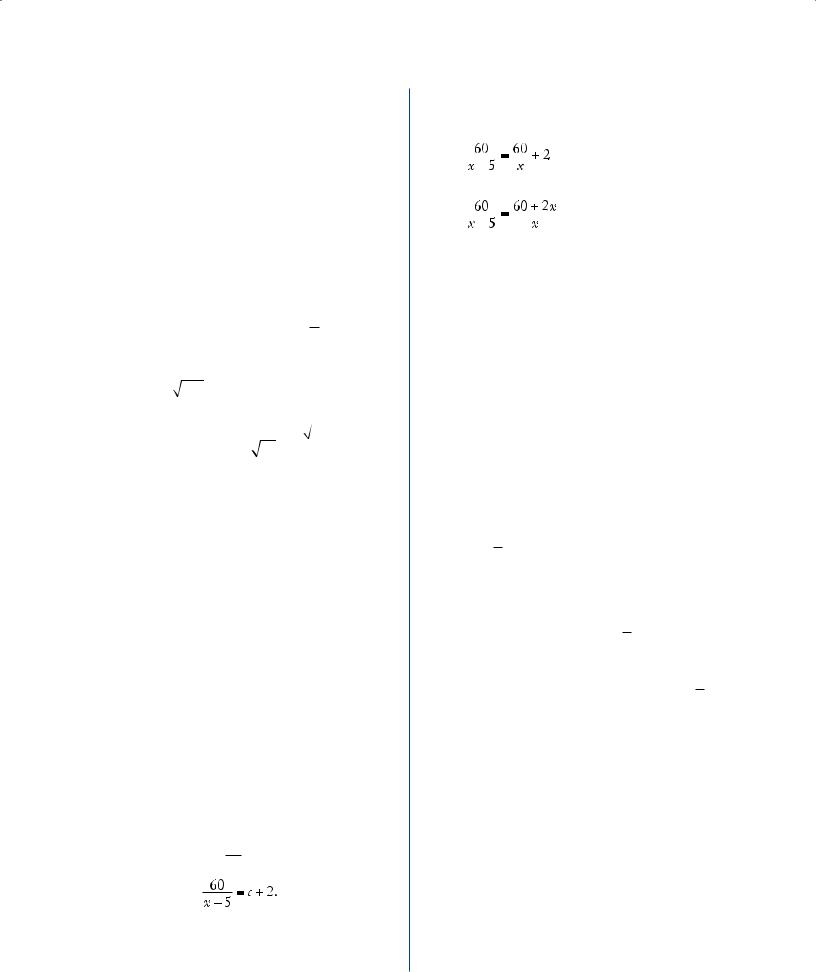
157.The hypotenuse of a right triangle is 10 cm. What is the perimeter, in centimeters, of the triangle?
(1)The area of the triangle is 25 square centimeters.
(2)The 2 legs of the triangle are of equal length.
Geometry Triangles
If x and y are the lengths of the legs of the triangle, then it is given that x2 + y2 = 100. To determine the value of x + y + 10, the perimeter of the triangle, is equivalent to determining the value of x + y.
1
(1)Given that the area is 25, then 2xy = 25, or xy = 50. Since (x + y)2 = x2 + y2 + 2xy, it follows that (x + y)2 = 100 + 2(50), or
x + y = 200 ; SUFFICIENT.
(2)Given that x = y, since x2 + y2 = 100, it
follows that 2x2 = 100, or x = 50 . Hence, x + y = x + x = 2x = 2 50 ; SUFFICIENT.
The correct answer is D;
each statement alone is su cient.
158.Every member of a certain club volunteers to contribute equally to the purchase of a $60 gift certificate. How many members does the club have?
(1)Each member’s contribution is to be $4.
(2)If 5 club members fail to contribute, the share of each contributing member will increase by $2.
Arithmetic; Algebra Arithmetic operations; Simultaneous equations
(1)If each member’s contribution is to be $4 and the total amount to be collected is $60, then 60 ÷ 4 = 15 members in the club;
SUFFICIENT.
(2)Let c represent each person’s contribution, and let x represent the number of members in the club. From the given information,
it is known that 60 = c. From this, it is also x
6.5 Data Sufficiency Answer Explanations
T ese htwo equations can be solved simultaneously for x:
|
|
|
|
|
|
|
|
|
substitute |
|
|
|
|
|
|
|
|
|
for c |
|
|
|
|
|
|
|
|
|
|
|
|
|
|
|
|
|
|
|
add fraction and |
|
|
|
|
|
|
|
|
|
whole number |
|
|
|
|
|
|
|
|
|
|
60x = (x – 5)(60 + 2x) |
cross multiply |
||||||||
60x = 2x2 |
– 10x + 60x – 300 |
multiply |
|||||||
0 |
= 2x2 |
– 10x – 300 |
subtract 60x |
||||||
|
|
|
|
|
|
|
|
|
from both sides |
0 |
= 2(x – 15)(x + 10) |
factor |
|||||||
T erefore,h x could be 15 or –10. Since there cannot be –10 members, x must be 15;
so there are 15 members in the club; SUFFICIENT.
The correct answer is D;
each statement alone is sufficient.
159.If x < 0, is y > 0 ?
(1)x < 0 y
(2)y – x > 0
Algebra Inequalities
(1)In order for x < 0 and x < 0 to be true,
y |
x |
|
y must be greater than 0. If y = 0, then |
||
|
y
would be undefined. If y < 0, then x would y
be a positive number; SUFFICIENT.
(2)Here, if x < 0, then y could be 0. For example, if y was 0 and x was –3, then y – x > 0 would be 0 – (–3) > 0 or 3 > 0. The statement would also be true if y were less than 0 but greater than x. For example, if y = –2 and x = –7, then –2 – (–7) > 0 or 5 > 0. Finally, this statement would also be true if y > 0. Without any further information, it is impossible to tell whether y > 0; NOT sufficient.
The correct answer is A; statement 1 alone is sufficient.
345

The Official Guide for GMAT® Review 12th Edition
X
Y
O Z
Z
160.What is the circumference of the circle above with center O ?
(1) The perimeter of OXZ is |
. |
(2)The length of arc XYZ is 5π.
Geometry Circles
The circumference of the circle can be found if the radius r is known. OXZ is a right triangle with OX = OZ = r (since O is the center). The perimeter of OXZ is the sum of OX (or r) + OZ (or r) + XZ, or the perimeter = 2r + XZ. From the
Pythagorean theorem,
XZ 2 = OX 2 + OZ 2
XZ 2 = r 2 + r 2
XZ = 
XZ = 
XZ = 

The perimeter of ∆OXZ is then 2r + 
 .
.
(1)The perimeter of ∆OXZ is 20 + 10 . Thus, 2r +
. Thus, 2r + 
 = 20 + 10
= 20 + 10 = 2(10) + 10
= 2(10) + 10 , and r = 10. Since r is known, the circumference can be found; SUFFICIENT.
, and r = 10. Since r is known, the circumference can be found; SUFFICIENT.
(2)The length of arc XYZ is the measurement of angle XOZ divided by 360 and multiplied by the circumference. Since angle XOZ equals 90, the length of arc XYZ is thus


 of the circumference. Since 1 of
of the circumference. Since 1 of 

 4
4
the circumference is given as equal to 5π, the circumference can be determined; SUFFICIENT.
The correct answer is D;
each statement alone is sufficient.
161.Beginning in January of last year, Carl made deposits of $120 into his account on the 15th of each month for several consecutive months and then made withdrawals of $50 from the account on the 15th of each of the remaining months of last year. There were no other transactions in the account last year. If the closing balance of Carl’s account for May of last year was $2,600, what was the range of the monthly closing balances of Carl’s account last year?
(1)Last year the closing balance of Carl’s account for April was less than $2,625.
(2)Last year the closing balance of Carl’s account for June was less than $2,675.
Arithmetic Statistics
(1)If Carl began making $50 withdrawals on or before May 15, his account balance on
April 16 would be at least $50 greater than it was on the last day of May. Thus, his account balance on April 16 would be at least $2,600 + $50 = $2,650, which is contrary to the information given in (1). Therefore, Carl did not begin making $50 withdrawals until
June 15 or later. These observations can be used to give at least two possible ranges. Carl could have had an account balance of $2,000 on January 1, made $120 deposits in each of the first 11 months of the year, and then made a $50 withdrawal on December 15, which gives a range of monthly closing balances of (120)(10). Also, Carl could have had an account balance of $2,000 on January 1, made $120 deposits in each of the
first 10 months of the year, and then made $50 withdrawals on November 15 and on December 15, which gives a range of monthly closing balances of (120)(9); NOT su cient.
(2)On June 1, Carl’s account balance was the same as its closing balance was for May, namely $2,600. Depending on whether Carl made a $120 deposit or a $50 withdrawal on
June 15, Carl’s account balance on June 16 was either $2,720 or $2,550. It follows from the information given in (2) that Carl’s balance on June 16 was $2,550. Therefore, Carl began making $50 withdrawals on or before June 15. These observations can be used to give at least two possible ranges.
Carl could have had an account balance of
346
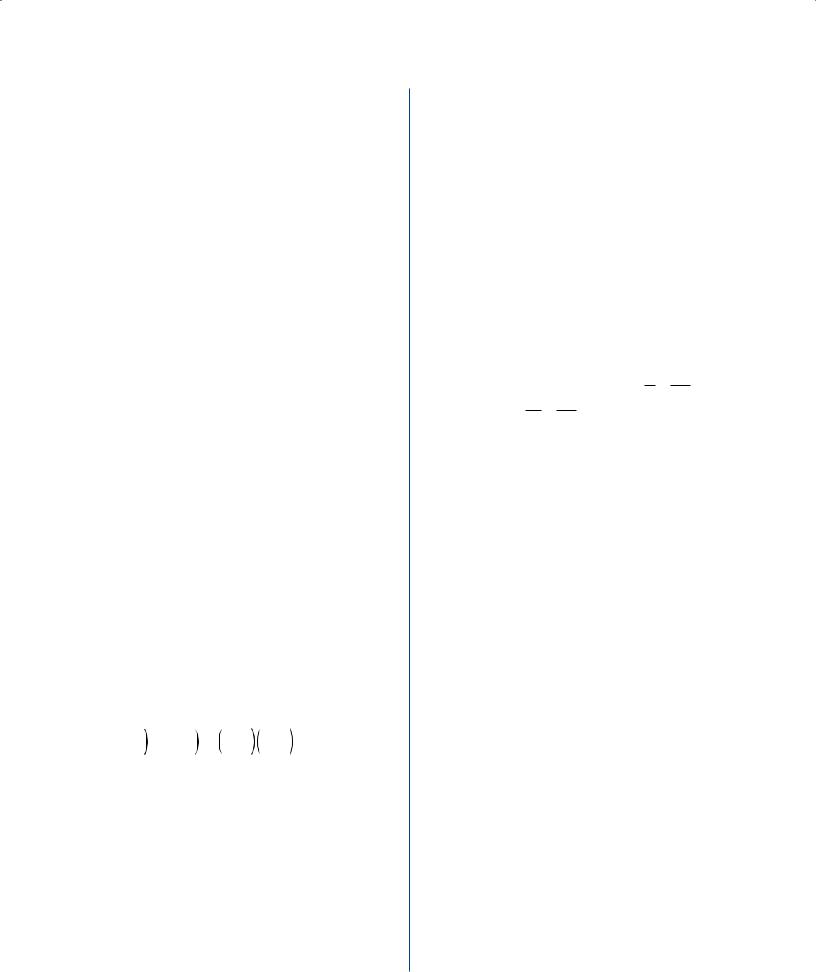
$2,680 on January 1, made one $120 deposit on January 15, and then made a $50 withdrawal in each of the remaining
11 months of the year (this gives a closing balance of $2,600 for May), which gives a range of monthly closing balances of
(50)(11). Also, Carl could have had an account balance of $2,510 on January 1, made $120 deposits on January 15 and on February 15, and then made a $50 withdrawal in each of the remaining 10 months of the year (this gives a closing balance of $2,600 for May), which gives a range of monthly closing balances of (50)(10); NOT su cient.
Given both (1) and (2), it follows from the remarks above that Carl began making $50 withdrawals on June 15. Therefore, the changes to Carl’s account balance for each month of last year are known. Since the closing balance for May is given, it follows that the closing balances for each month of last year are known, and hence the range of these 12 known values can be determined. Therefore, (1) and (2) together are su cient.
The correct answer is C;
both statements together are su cient.
162.If n and k are positive integers, is  > 2
> 2 ?
?
(1)k > 3n
(2)n + k > 3n
Algebra Inequalities
Determine if  > 2
> 2 . Since each side is positive, squaring each side preserves the
. Since each side is positive, squaring each side preserves the
inequality, so  > 2
> 2 is equivalent to
is equivalent to







 >
> 


 , which in turn is equivalent to n + k > 4n, or to k > 3n.
, which in turn is equivalent to n + k > 4n, or to k > 3n.
(1)Given that k > 3n, then  > 2
> 2 ; SUFFICIENT.
; SUFFICIENT.
(2)Given that n + k > 3n, then k > 2n. However, it is possible for k > 2n to be true and k > 3n to be false (for example, k = 3 and n = 1) and it is possible for k > 2n to be true and k > 3n to be true (for example, k = 4 and n = 1); NOT su cient.
The correct answer is A; statement 1 alone is su cient.
6.5Data Sufficiency Answer Explanations
163.In a certain business, production index p is directly proportional to effi ciency index e, which is in turn directly proportional to investment index i. What is p if i = 70 ?
(1)e = 0.5 whenever i = 60.
(2)p = 2.0 whenever i = 50.
Arithmetic Proportions
(1)This gives only values for e and i, and, while p is directly proportional to e, the nature of this proportion is unknown. Therefore, p cannot be determined; NOT su cient.
(2)Since p is directly proportional to e, which is directly proportional to i, then p is directly proportional to i. Therefore, the following
proportion can be set up: p = 2.0 . If i = 70,
then p = 2.0 . 70 50
this equation yields 50p = 140, or p = 2.8; SUFFICIENT.
The preceding approach is one method that can be used. Another approach is as follows: It is given that p = Ke = K(Li) = (KL)i, where K and L are the proportionality constants, and the value of 70KL is to be determined. Statement (1) allows us to determine the value of L, but gives nothing about K, and thus (1) is not su cient. Statement
(2) allows us to determine the value of KL, and thus (2) is su cient.
The correct answer is B; statement 2 alone is su cient.
164.In the rectangular coordinate system, are the points (r,s) and (u,v) equidistant from the origin?
(1)r + s = 1
(2)u = 1 – r and v = 1 – s
Geometry Coordinate geometry
The distance from (r,s) to (0,0) is 

 Similarly,
Similarly,
the distance from (u,v) to (0,0) is 
Therefore, if r2 + s2 = u2 + v2, the two points would be equidistant from the origin.
347
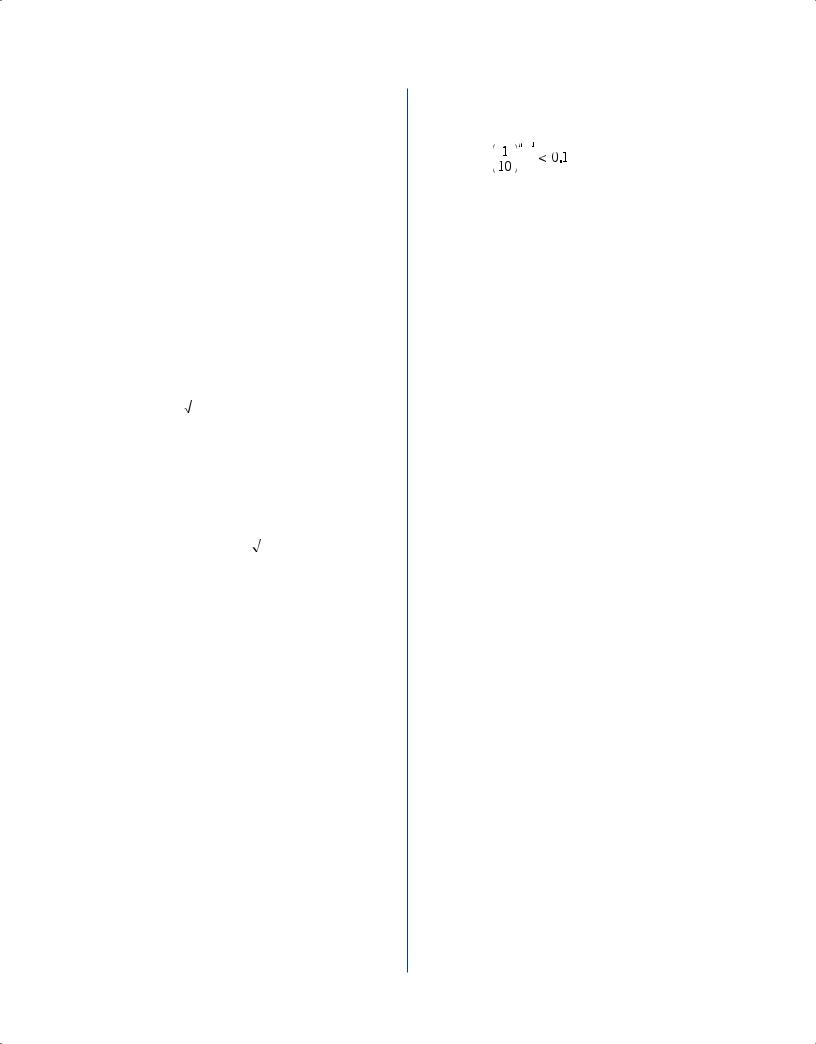
The Official Guide for GMAT® Review 12th Edition
(1)This says nothing about coordinates u and v; NOT sufficient.
(2)Using this information, u2= (1 – r)2 or
1 – 2r + r2, and v2 = (1 – s)2 or 1 – 2s + s2. Thus, u2 + v2 = 1 – 2r + r2 + 1 – 2s + s2, or u2 + v2 = 2 – 2(r + s) + r2 + s2, but there is no information about the value of r + s;
NOT sufficient.
From (1) and (2) together, since r + s = 1, it follows by substitution that u2 + v2 =
2 – 2(1) + r2 + s2, or u2 + v2 = r2 + s2.
The correct answer is C;
both statements together are sufficient.
165. If x is an integer, is 9x + 9–x = b ?
(1) 3x + 3–x = b + 2
(2)x > 0
Algebra Exponents
When solving this problem it is helpful to note that (xr)(x–s) = xr – s and that (xr)2 = x2r. Note also that x0 = 1.
(1) From this, 3x + 3–x = b + 2. Squaring both sides gives:
(3x + 3–x)2 = b + 2 |
|
32x + 2(3x × 3–x) + 3–2x = b + 2 |
|
9x + 2(30) + 9–x = b + 2 |
property of |
|
exponents |
9x + 2 + 9–x = b + 2 |
property of |
|
exponents |
9x + 9–x = b |
subtract 2 from |
|
both sides; |
|
SUFFICIENT. |
(2)This gives no information about the relationship between x and b; NOT su cient.
The correct answer is A; statement 1 alone is su cient.
|
|
|
|
|
1 |
n |
|
166. If n is a positive integer, is |
|
< 0.01 ? |
|||||
|
|
|
|
10 |
|
|
|
(1) n > 2 |
|
|
|
||||
(2) |
|
|
|
|
|
|
|
|
|
|
|
|
|
|
|
|
|
|
|
|
|
||
Arithmetic; Algebra Properties of numbers;
Inequalities
(1) |
|
|
n |
> 2 |
|
|
|
|
–n |
< –2 |
|
|
|
||
|
10–n |
< 10–2 |
|
|
|||
(10–1)n < 10–2 |
|
|
|||||
|
1 n |
< 10–2 |
|
|
|||
|
|
|
|
|
|
||
|
|
|
|
||||
|
10 |
|
|
|
|
||
|
1 n |
< 0.01 |
|
|
|||
|
|
|
|
|
|
||
|
|
|
|
||||
|
10 |
|
|
|
|
||
SUFFICIENT. |
|
||||||
(2) |
1 |
n − 1 |
< |
0.1 |
|||
|
|
|
|||||
|
10 |
|
|
|
|
||
|
1 |
n − 1 |
< |
10 |
–1 |
||
|
|
|
|
|
|||
|
|
|
|||||
|
10 |
|
|
|
|
||
|
(10–1)n – 1 < |
10–1 |
|||||
(10)(–1)(n – 1) < |
10–1 |
||||||
|
(10)–n + 1 < |
10–1 |
|||||
|
|
|
–n + 1 < |
–1 |
|
||
|
|
|
|
–n < |
–2 |
|
|
|
|
|
|
n > |
2 |
|
|
But, this is the inequality given in (1), which was su cient; SUFFICIENT.
The correct answer is D;
each statement alone is su cient.
167.If n is a positive integer, what is the tens digit of n ?
(1)The hundreds digit of 10n is 6.
(2)The tens digit of n + 1 is 7.
348
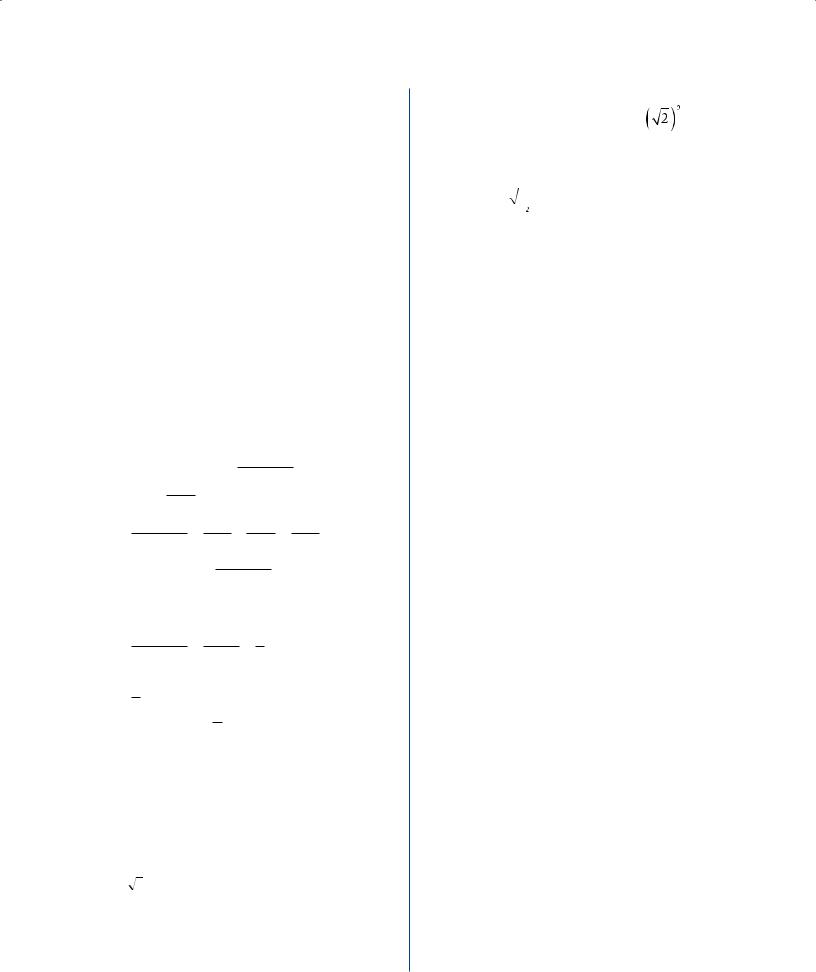
Arithmetic Properties of numbers
(1)Given that the hundreds digit of 10n is 6, the tens digit of n is 6, since the hundreds digit of 10n is always equal to the tens digit of n; SUFFICIENT.
(2)Given that the tens digit of n + 1 is 7, it is possible that the tens digit of n is 7 (for example, n = 70) and it is possible that the tens digit of n is 6 (for example, n = 69);
NOT su cient.
The correct answer is A; statement 1 alone is su cient.
168. What is the value of |
2t + t − x |
? |
||
|
|
|
t − x |
|
(1) |
2t |
= 3 |
|
|
t − x |
|
|
||
|
|
|
|
|
(2) t – x = 5
Algebra Simplifying algebraic expressions
Determine the value of |
2t + t − x |
. |
|
|||||||||||
(1) Since |
|
2t |
|
|
|
|
|
|
t − x |
|||||
|
|
= 3 and |
|
|
|
|
||||||||
t |
− x |
|
|
|
|
|||||||||
|
|
|
|
|
|
|
|
|
|
|
||||
2t + t − x |
= |
t |
2t |
+ |
t − x |
= |
2t |
+ 1 , |
||||||
t − x |
|
|
|
− x t − x |
|
t − x |
||||||||
it follows that |
|
2t + t − x |
= 3 + 1; |
|||||||||||
|
t − x |
|||||||||||||
|
|
|
|
|
|
|
|
|
|
|
||||
SUFFICIENT.
(2)Given that t – x = 5, it follows that
2t + t − x |
= |
2t + 5 |
= |
2 |
t + 1 , which can |
t − x |
|
|
|||
5 |
5 |
|
|||
vary when the value of t varies. For example,
2 |
t + 1 = 3 if t = 5 (choose x = 0 to have |
|||
5 |
||||
|
2 |
t + 1 = 5 if t = 10 (choose |
||
t – x = 5) and |
||||
5 |
||||
|
|
|
||
x = 5 to have t – x = 5); NOT su cient.
The correct answer is A; statement 1 alone is su cient.
169.Is n an integer?
(1)n2 is an integer.
(2)n is an integer.
6.5 Data Sufficiency Answer Explanations
Arithmetic Properties of numbers |
|
(1) Since 12 is an integer and |
is an |
integer, the square of an integer can be an integer and the square of a non-integer can be an integer; NOT su cient.
(2)If n = k, where k is an integer, then


 = k2, or n = k2. Therefore, n is the square of an integer, which in turn is an integer; SUFFICIENT.
= k2, or n = k2. Therefore, n is the square of an integer, which in turn is an integer; SUFFICIENT.
The correct answer is B; statement 2 alone is su cient.
170.If n is a positive integer, is n3 – n divisible by 4 ?
(1)n = 2k + 1, where k is an integer.
(2)n2 + n is divisible by 6.
Arithmetic Arithmetic operations; Properties of numbers
Since n is a positive integer and n3 – n =
n(n2 – 1) = n(n – 1)(n + 1), it follows that n3 – n is the product of the three consecutive integers n – 1, n, and n + 1.
(1)Since 2k is an even integer, then n = 2k + 1 must be an odd integer. Therefore, the consecutive integers, n – 1, n, and n + 1 are even, odd, and even, respectively. Two of the three numbers are therefore divisible by 2. When the product is broken down into factors, there are at least two factors of 2 in the product (2 × 2 = 4) so the product of the three numbers must be divisible by 4;
SUFFICIENT.
(2)The expression n2 + n can be factored as n(n + 1), which represents the product of two consecutive integers. The fact that
n(n + 1) is divisible by 6 does not appear to ensure that n(n – 1)(n + 1) is divisible by 4. For example, (6)(7) = 42 is divisible by 6, but (5)(6)(7) is not divisible by 4. However,
(5)(6) is divisible by 6, and (4)(5)(6) is divisible by 4. Since the exact value of n cannot be determined, it cannot be known whether n3 – n is divisible by 4; NOT su cient.
The correct answer is A; statement 1 alone is su cient.
349
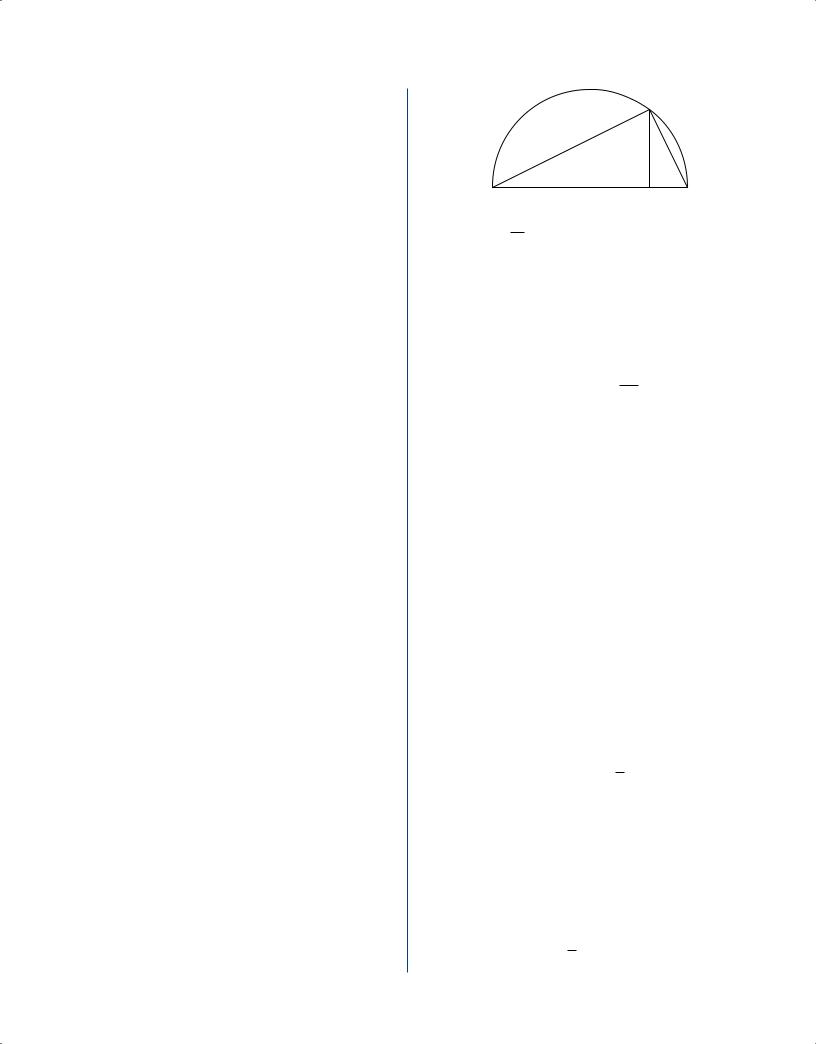
The Official Guide for GMAT® Review 12th Edition
171.What is the tens digit of positive integer x ?
(1)x divided by 100 has a remainder of 30.
(2)x divided by 110 has a remainder of 30.
Arithmetic Properties of numbers
(1)Having a remainder of 30 when x is divided by 100 can only happen if x has a tens digit of 3 and a ones digit of 0, as in 130, 230, 630, and so forth; SUFFICIENT.
(2)When 140 is divided by 110, the quotient is
1 R30. However, 250 divided by 110 yields a quotient of 2 R30, and 360 divided by
110 gives a quotient of 3 R30. Since there is no consistency in the tens digit, more information is needed; NOT sufficient.
The correct answer is A; statement 1 alone is sufficient.
172.If x, y, and z are positive integers, is x – y odd?
(1)x = z2
(2)y = (z – 1)2
Arithmetic Arithmetic operations; Properties of numbers
(1)This reveals the relationship between two of the variables but does not mention the relationship either has with y. Therefore the question cannot be answered; NOT su cient.
(2)If (z – 1)2 is expanded, the result is z2 – 2z + 1. Since y = z2 – 2z + 1, a substitution for y can be made in the
expression x – y. It becomes x – (z2 – 2z + 1).
However, without further information, it cannot be determined if x – y is odd; NOT su cient.
When (1) and (2) are taken together, z2,
from (1), can be substituted for x in the expression x – (z2 – 2z + 1) from (2). It then yields
z2 – z2 + 2z – 1, or simply 2z – 1, which is always an odd number regardless of the value of z.
So x – y is odd.
The correct answer is C;
both statements together are su cient.
Q
2
P a
a 
 b
b 
 R
R
173.If arc PQR above is a semicircle, what is the length of diameter PR ?
(1)a = 4
(2)b = 1
Geometry Circles
Since angle PQR is inscribed in a semicircle,
it is a right angle, and ∆PQR is a right triangle. ∆PQR is divided into two right triangles by the vertical line from Q to side PR. Let x = PQ and y = QR. The larger right triangle has hypotenuse x, so x2 = 4 + a2; the smaller right triangle has hypotenuse y , so y2 = 4 + b2. From ∆PQR,
(a + b)2 = x2 + y2, so by substitution, (a + b)2 = (4 + a2) + (4 + b2), and by simplification,
a2 + 2ab + b2 = 8 + a2 + b2 or 2ab = 8 or ab = 4.
(1)If a = 4 is substituted in ab = 4, then b must be 1 and diameter PR is 5; SUFFICIENT.
(2)If b = 1 is substituted in ab = 4, then a must be 4 and diameter PR is 5; SUFFICIENT.
The correct answer is D;
each statement alone is sufficient.
174.Marcia’s bucket can hold a maximum of how many liters of water?
(1)The bucket currently contains 9 liters of water.
(2)If 3 liters of water are added to the bucket when it is half full of water, the amount of water in the bucket will increase by 1 .
3
Geometry Volume
(1)This statement only implies that the bucket will hold at least 9 liters, but the maximum capacity is still unknown; NOT sufficient.
(2)Letting c represent the maximum capacity of Marcia’s bucket, the volume of water in the bucket when at half capacity can be
expressed as 1 c, and if 3 liters are then
2
350
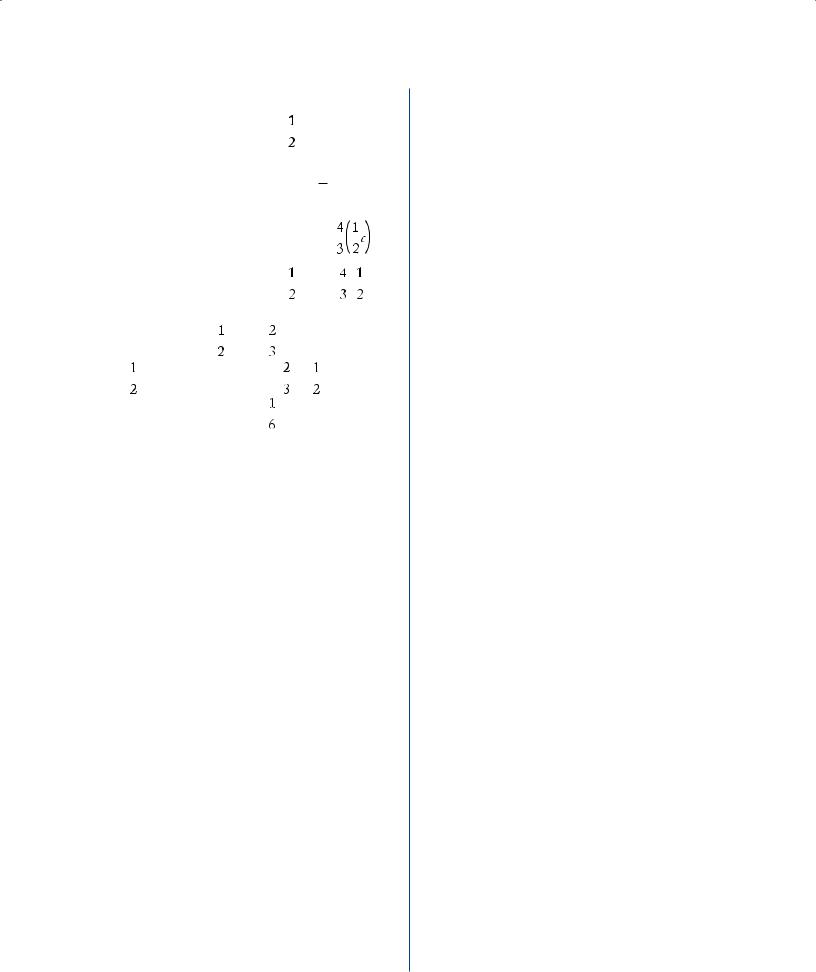
6.5 Data Sufficiency Answer Explanations
added, the present volume of water in the
bucket can be expressed as 
 + 3. It is
+ 3. It is
given that, when the 3 liters are added, the
volume of water will increase by 1 , which is 3
equivalent to multiplying the present volume
by |
4 |
. This becomes the expression |
|
|
|
. |
|
|
|||||
3 |
|
|
|
|
|
|
Therefore, it is known that 






 .
.
T is equationh can be solved for c, through
simplifying to 





 then subtracting
then subtracting

 from each side for
from each side for 





 and
and
then simplifying to 







T us the equation can be solved to determine the maximum capacity of the bucket; SUFFICIENT.
The correct answer is B; statement 2 alone is sufficient.
351
